Better Sailing
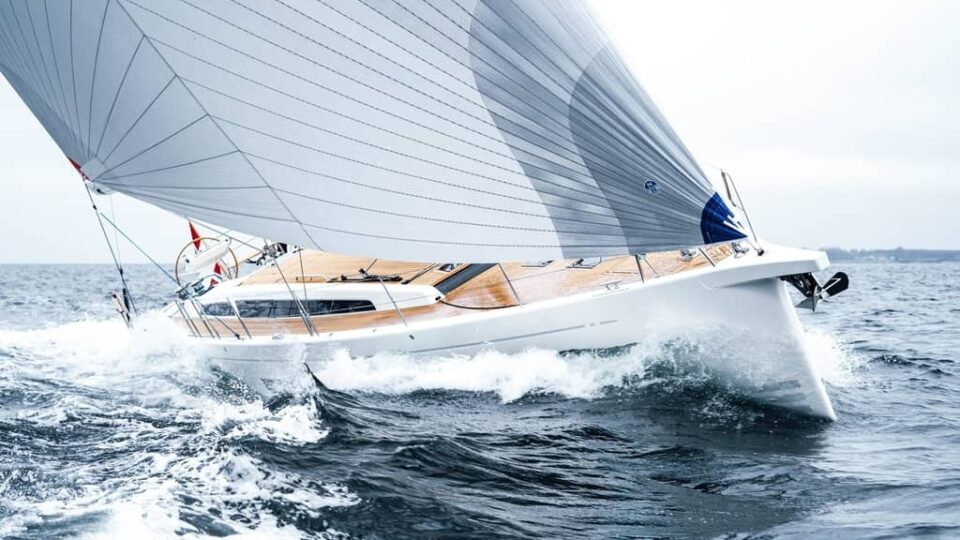

Names of Sails on a Sailboat
Are you a beginner sailor and want to get acquainted with the names of the sails? Are you an experienced sailor and want to learn more details about the sails on a sailboat? Then this article is written for you! Sails form a crucial part of the sailboat because without them, there’s no starting up. For that reason, there are many details about different types of sails concerning their utility, functionality, fabrication materials, and performance. Simply put, each sail serves different purposes when out on the water. Since the sail is the engine of your sailboat, in terms of it being the basic source of propulsion, it’s important to know when best to use either type of sail and why.
Types of Sails on a Sailboat
So, in order to better explain the types of sails, let’s look at their characteristics. The first important distinction between sails is their placement. Generally, the mainsail is placed aft of the mast , which means behind. On the contrary, the headsail is in front of the mast. There are also other sorts of sails that are used for specific conditions. These can be the spinnakers or balloon-shaped sails for downwind use. The second important distinction for the sails is their functionality. The specialized sails have different functionalities and are used in different sailing circumstances and weather conditions. A rule about sails is that large sails are appropriate for downwind use, whereas small sails are good for upwind use. Moreover, large sails perform better on weak winds while small sails are good for strong winds.
The Parts of a Sail and its Shapes
- Head: This is the top of the sail.
- Luff: The forward edge of the sail.
- Leech: Back edge of the sail.
- Tack: The lower front corner of the sail.
- Clew: The bottom back corner of the sail.
- Foot: Bottom of the sail.
There are two sail shapes, the fore-and-aft rigged sails, and square-rigged sails. Nowadays, fore-and-aft sails are more popular, have better performance and maneuverability. To grasp the idea square sails are the ones that Vikings had on their ships and are good at sailing downwind because they run from side to side. But they’re not suitable at all when sailing upwind. On the other hand, a fore-and-aft sail is tied from the front of the mast to the stern and is much better at sailing upwind.
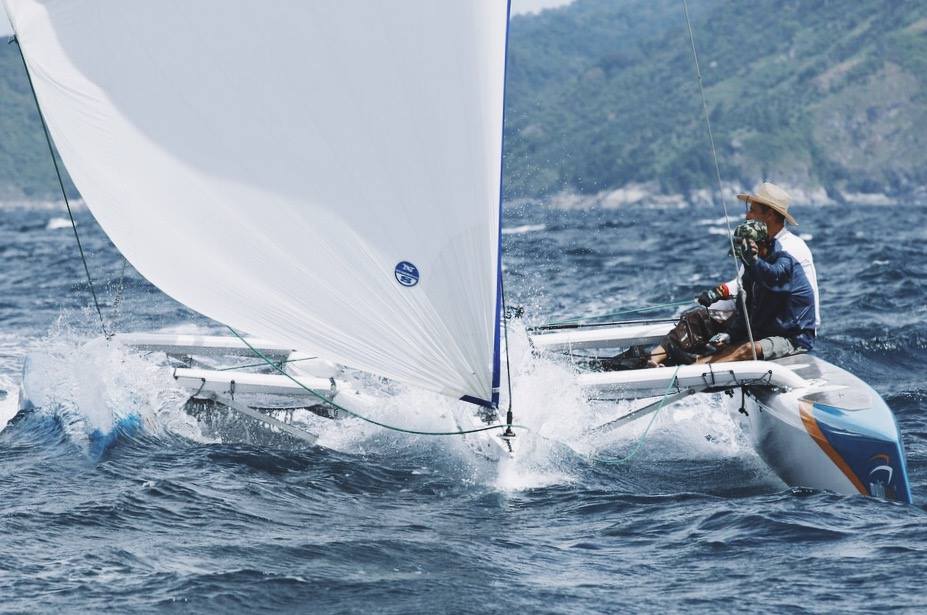
Also Read: What is Sailboat Rigging?
Types and Names of Sails
There are a lot of reasons why you’d want to put one sail over another, but the most important thing to remember has to do with the point of your sail and the wind strength. These points help you understand how your sailboat generates wind power. These points of sail include: into the wind (in irons), beam-reaching, broad-reaching, close-hauled, close-reaching, and running. They all go from windward to leeward and are symmetric from port to starboard . So, let’s get to the point and see the names and explanation of each sail:
- Mainsail : The large sail behind the mast which is attached to the mast and the boom, is called the mainsail. Mainsails cover a lot of surface area concerning incoming winds and by doing that they don’t need very strong winds to provide forward propulsion on a sailboat.
- Headsail or Jib : The small sail placed in front of the mast, attached to the mast and forestay (ie. jib or genoa), is called the headsail. Headsails are smaller than mainsails, thus their surface area is smaller. As a result, they can’t catch the same wind as a mainsail does. However, this is important because in case that the current wind is strong and the mainsail has been enough trimmed, being able to remove the mainsail and depend on the headsail alone, is a good strategy in order to reduce speed.
- Genoa : A genoa is like a large jib and it’s attached to the front of the forestay, like a headsail. When you use a genoa sail then you are expecting light to medium winds. Also, your sailboat would be somehow in a rush point of sail, meaning that the wind comes directly from the rear. Moreover, the surface area of a genoa sail is quite large, so it’s important to use it when winds are relatively low.
- Spinnaker : These downwind sails are symmetrical which makes them more sensitive to the reaching points of the sail and therefore more suitable for the running point of sail. Spinakkers are lighter than other types of jibs, and they don’t cover the mast like a genoa sail. Moreover, they remain unattached to the forestay and stretch out toward and past the bow of a sailboat.
- Gennaker : Gennakers are a mixture of genoa and spinnaker sails. There are small and big gennakers and both are downwind sails. They aren’t as symmetric as a spinnaker and aren’t attached to the forestay like a headsail. Furthermore, the gennaker sail is able to take on a more flexible point of sail while taking advantage of softer winds.
- Drifter Reacher : A drifter is a light air sail, and it’s basically a larger genoa for use in light winds. Its extra sail area offers better downwind performance than a genoa. It’s mostly made from lightweight nylon.
- Code Zero Reacher : This sail is a type of spinnaker, but it looks like a large genoa. However, code zero is designed for better reaching which makes it much flatter than the spinnaker.
- Windseeker : This sail is small, and it’s designed to guide light air onto the lee side of the mainsail. Moreover, it’s tall and thin and ensures a smoother flow of air.
Sail and Mast Configurations
Now that you got an idea of the different types of sails on a sailboat, it would also be an advantage to know how these types of sails are related to the configuration of a sailboat’s mast. There are numerous combinations when it comes to sails and mast configurations, let’s see some of them!
- Cat: A cat is similar to a dinghy and has one mast and one sail. The mast is located at the bow of the sailboat.
- Sloop: The sloop has the classic single mast and a double sail setup. The headsail can be different kinds of jibs, is connected with the forestay on the mast, and runs all the way up to the mast.
- Fractional Rig Sloop: A fractional rig sloop is different from the sloop because its forestay doesn’t reach the top of the mast. Its headsail is restricted to a fractional amount of space and this means that less wind can be captured, therefore the speed of the sailboat is reduced.
- Cutter: Having two forestays on the mast and cutters that are able to house two headsails this setup allows easy cruising because it offers a wide combination of points of sail for different strengths of wind.
- Ketch: Just like a sloop the ketch has a mast that enables the mainsail and headsail to a full range forestay. However, it also has a smaller mast between the mainmast and the stern of the sailboat.
- Schooner: A schooner is when a sailboat has two or more masts but it has a couple of sails to manage. A schooner’s aft mast is taller than the forward mast and sometimes a schooner can have up to six masts.
Names of Sails on a Sailboat – Summary
So, how many types of sails are there? In general, sailboats have one mainsail and one headsail. The rigging also affects the types of sails you can use. As we’ve explained before, the mainsail is a fore-and-aft Bermuda rig. Then, for a headsail, we use a jib or genoa. Most experienced sailors use extra sails to ensure better performance for their sailboat. For example, the spinnaker (a common downwind sail), the gennaker, the code zero (for upwind use), and the storm sail. Keep in mind that every sail has its own use and performance. Want to go downwind fast? Use a spinnaker. Don’t just raise any sail you think suits you best and go for it! It’s of great importance to understand the functionality, use, and performance of each sail.
Peter is the editor of Better Sailing. He has sailed for countless hours and has maintained his own boats and sailboats for years. After years of trial and error, he decided to start this website to share the knowledge.
Related Posts

Lagoon Catamaran Review: Are Lagoon Catamarans Good?

Best Inboard Boat Engine Brands

Are O’Day Sailboats Good? A Closer Look at a Classic Brand

Why Do Sailboats Lean?
- Buyer's Guide
- Destinations
- Maintenance
- Sailing Info
Hit enter to search or ESC to close.
Sail Types: A Comprehensive Guide to 8 Types of Sails
Sailboats come in all shapes and sizes. And that means there are many types of sails on the market! For those who might not know, sails are made of canvas and use wind power to propel sailboats through the water.
Understandably, different sails are required for different types of sailboats . And sailboats are categorized by the number of hulls they have. Monohulls have a single-hull design, catamarans have two hulls, and trimarans have three. Generally, sailors use catamarans for upwind sailing (but they can be used to sail downwind in certain conditions).
The type of sail you'll need for your sailboat depends on the kind of sailboat you have. Additionally, sails are highly dependent on the wind and weather conditions. Therefore, it's always a good idea to have different types of sails on board to navigate the ever-changing weather conditions.
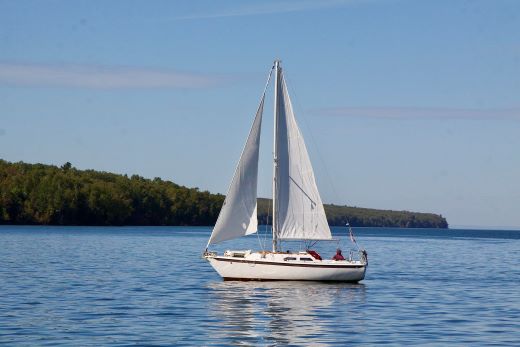
8 Types of Sails for Sailboats
As mentioned, you should carry multiple sails when sailing to prepare for various weather conditions. Here's a brief overview of the types of sails for sailboats:
1. Mainsails
The mainsail is the largest and most important sail. Therefore, it's probably the first sail to come to mind when you think of camping. Typically, it's situated directly behind the mast — connected to the boom — and uses wind energy to move the vessel. The mainsail plays a significant role in tacking and gybing, making it essential for any voyage.
Since the mainsail is a larger sail, it doesn't require wind to propel it forward. And the fact that it can be moved by moving the boom makes it uber-easy to operate.
Learn More About Sailing
2. Headsail
The headsail often accompanies the mainsail, though it is smaller in size. Regardless of your sailboat type, the headsail is positioned at the front of the mast – over the sailboat's bow.
Because headsails are small, they are helpful when navigating through windy conditions. Smaller sails catch less wind, preventing them from propelling your boat as strongly as larger sails. Additionally, headsails help lift, balance, and protect the vessel from inclement weather conditions.
While the term 'headsail' refers to any sail in front of the mast, the jib is the most common type of headsail. (And when a jib is so large that it overlaps the mast, it's called a genoa.)
Learn More About Sailboats
3. Genoa
The genoa is a large sail that attaches to the front of the forestay. (In this instance, it's similar to a headsail.) However, the genoa is larger than the headsail and overlaps the mainsail partially or completely to help the boat go faster.
Genoa sails are useful when sailing through light or medium wind. You can also use it when the wind comes directly from the rear. If you use a Genoa sail during high winds, you'll probably start sailing too quickly and put yourself and your boat at risk.
4. Spinnaker
The spinnaker is a large and whimsical (often colorful) sail. Spinnaker sails are usually symmetrical, allowing them to reach different points of sail. Generally, these are lighter sails and don't cover the mast like the genoa.
Because spinnaker sails are on the larger side, you have to be incredibly careful with them. Don't use them in rough conditions. Instead, save them for sailing in low winds and calm seas.
5. Gennaker
As the name suggests, the Gennaker sail combines a spinnaker and a Genoa sail. They are as large as the spinnaker, although they're not symmetrical.
They come in handy whenever the wind changes from a pure dead run to a reaching point of sail, as sailors can navigate various wind types with the same sail. It's still only meant for lighter and milder winds, but it's more versatile than the spinnaker and genoa.
6. Light Air Sails
Light air sails are useful in calmer conditions when the headsail and mainsail alone aren't cutting it. They include:
- Code Zero : A code zero sail is a gennaker sail ideal for sailing in light to mild winds. It's designed to create lift and boost boat speed whenever regular sails don't generate enough power. For that reason, many racers and cruisers use code zero sails to improve performance and gain control in various situations.
- Windseeker : This small, special sail is reserved for no wind or light wind. Essentially, it helps boats remain maneuverable in extremely calm conditions. And for that reason, it's valuable to long-distance sailors.
7. Storm Jib
Storm jibs can be used as a headsail whenever the weather is particularly rough and windy. Because it functions as a safety seal, it prevents boats from capsizing by reducing the sail area exposed to the wind. Therefore, it's a necessary sail for every sailor.
Read Next: Boating in Inclement Weather
During strong winds and storms, sailors can raise a trysail — a small, triangular sail near the boat's stern — for better control and stability. Generally, sailors do this whenever the mainsail becomes too large and challenging to maneuver.
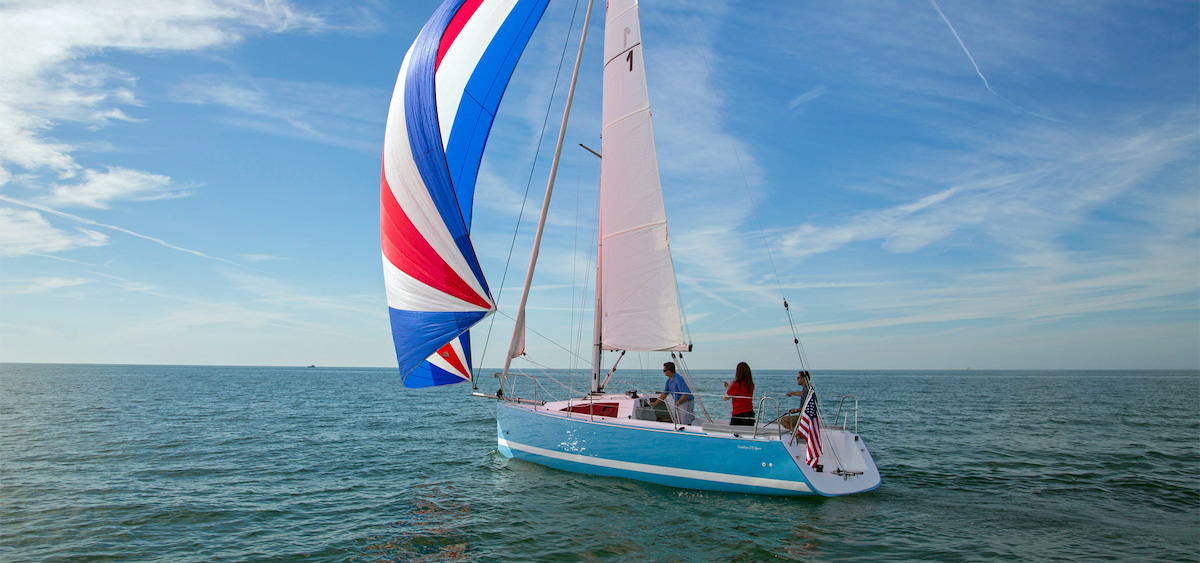
Join Our Newsletter!
Get community news, buying bargains, and how-to guides at your fingertips.

The Different Types Of Sails And When To Use Them – Complete Guide

Sail forms an integral part of a sailboat. When you sail on the open water and observe other boats (in various sizes), you’d have noticed how each boat type has a specific model of sail. If you’re a beginner in boating, you must know that there are a ton of different sails and they each have their own purpose.
As a general setup, sailboats will use three common sails, including headsail, mainsail, and specialty sail. Due to the varying wind conditions and the model of the sailboat, there are many types of sails including jib, genoa, trysail, storm jib, code zero, gennaker, and spinnaker.
While that sounds like too many models of sails, you can easily differentiate between them and choose the ideal model based on your purpose. This article guides you on this aspect. Let’s begin!
Different Types of Sails & When To Use Them
1. mainsail.
Mainsail is by far the most widely spotted sail model, and it’s usually fixed to the boom and fitted behind the mast. This offers the highest mileage to your sailboat, thereby maximizing speed and performance.
You can use a mainsail if:
- You’re concerned about the performance
- You need to go faster and utilize all wind power
- You need to steer your boat irrespective of the wind’s status
- You’ve a large boat and can offer adequate space to this sail.
This mainsail displays a wide surface area to make the most out of the available wind condition. As a result, you can steer your boat quite easily. However, the downside is its size. It is very large and hard to store if you need to take it down for some reason.
Check out my other article all about maintaing sails!
2. Headsail
Similar to a mainsail, it’s very easy to spot a head sail. Just look at the bow of the boat and see if there is a sail. If you see one then yes that’s a headsail. Also called a jib or genoa, a headsail is smaller in size compared to a mainsail and attaches in front of the mast to the forestay. The Foresail will not have a boom for the clew of the sail to attach to. The clew will be attached to the foresails sheet. It can be used without the mainsail in certain conditions but for the most part the two sails are used together. The foresail is always forward of the main.
The headsail comes in many different forms such as a jib, genoa, spinnaker or storm jib. The most common headsail is a jib or genoa.
You can use a headsail if:
- Your sailboat is set up for it.
- You don’t want to use the mainsail at this time.
- Your mainsail is not usable.
The biggest advantage of a headsail is the option to protect yourself even if the wind turns unpredictable or wild. This all depends on the type of headsail you are using.
So, what are the different types of headsails? Let’s take a look!
As more boaters chose to use a headsail for their boats, the jib was introduced as one of its forms. The Jib is a form of headsail that is attached to a shackle present on the deck’s front region.
The Jib is a sail that does not go past the mast when it is raised and in use. If it goes past the mast then you probably have a genoa.
You can use a jib if:
- You are out for a normal day of sailing in moderate wind speeds
- You have a roller furling. Which is a sail that wraps up around itself.
Some weather conditions can make maneuvering harder or tighter than usual. As a result, it’s essential to use a jib in such cases. It functions well with boats containing a roller furling as the jib handles different positions and tackles the movement of the boat at ease.
2.2 Genoa
Just when you’ve got acquainted with the jib, genoa comes into the picture as a larger version of the jib. If you’re boating along a coastal region, the genoa sail is the one widely used and is attached to the front area of the deck as well.
Here’s a quick trick to find out if a boat has a genoa sail. This genoa is usually larger than a Jib. This means that the genoa effortlessly overlaps and extends itself beyond the mast, thereby covering the mainsail as well.
You should use a genoa sail if:
- You’re planning to sail in minimum wind conditions. Less wind means you need more sail.
- You find the wind to originate from the rear area.
- You own a large boat. Remember that genoa can partially or completely cover the mainsail too. Larger sails for larger boats!
While it’s great for sailing in regular conditions, there are downsides associated with it. A genoa can put you in a dangerous situation if you are sailing in high wind conditions and don’t have the ability to furl in the sail. Furling in the sail will reduce the area of the sail and catch less wind.
Genoas do come in many sizes as well such as 110% or 120%.
The next section of the sail list are ones that aren’t necessary but can be helpful in certain situations. Let’s look at specialty sails!
3. Specialty Sail
While headsails and mainsails are quite commonly used, there are also specialty sails in the market to address specific requirements. Some of the widely seen specialty sails are spinnakers, storm jibs, and code zeros.
3.1 Spinnakers
Spinnaker is a sail dedicated to downwind and is quite large. Think of a beautifully covered parachute.
It’s easy to spot spinnakers as they resemble kites or parachutes. However, it crosses the bow of the boat and isn’t attached to the forestay.
Unlike the genoa sail that covers the mast, a spinnaker fails to do so. The advantage of a spinnaker is the surface area. When the wind is light, the spinnaker can catch a lot more wind giving you more speed. The Spinnaker is usually fixed to three points – pole, halyard, and sheet.
You should use a spinnaker if:
- You have minimal wind on a run.
- You are trying to harness as much wind power as you can.
While it has a wide surface area, the downside is its inability to steer the boat during strong wind conditions. It can even put the passengers at risk when the wind is at high speeds.
Make sure you have experience before trying out the spinnaker.
3.2 Storm Jibs
Storm jib is another type of specialty sail meant exclusively for rough weather. It’s a tiny, triangular structure that helps during offshore racing or cruising. Just think of it as a smaller jib.
You should use a storm jib if:
- You’re going to sail in heavy weather conditions.
- You anticipate high wind speeds.
- You’re going to be in an offshore race and they are an approved sail type.
Note: In the case of an offshore racing requirement, it’s critical to take prior permission from the regulatory authority for using a storm jib.
3.3 Code Zeros
Code zero is another updated version of a spinnaker that’s meant to be a combination of genoa and gennaker sails. It resembles the look of a genoa but is a lot bigger.
You should use a code zero if:
- You’re looking for an overlapping flying headsail.
- You’re sailing only in light air conditions.
- You’re looking for an alternative to a Genoa.
Having said that, a code zero or a screecher does the job of a genoa with better efficiencies.
3.4 Trysail
Trysail is another type of specialty sail that’s tiny, triangular, and can be fixed right above a gooseneck on the sailboat.
The Trysail is less known in the market as most boaters go ahead with common mainsails and headsails. It’s essential to acknowledge trysail as a front-and-aft mainsail model. It offers excellent performance and contains a permanent pennant in it.
You should use a trysail if:
- You’re sailing in heavy weather conditions.
- You’re looking for a storm replacement.
- You are experienced with using them.
The quadrilateral sail in a trysail is usually turned and bent to a mast, and this helps in heading the vessel during windy conditions.
3.5 Gennakers
If you’ve been able to spot genoa and spinnaker in the past, identifying a gennaker is incredibly easy. A gennaker is a hybrid sail form that is small, slow, and requires no pole attached to the mast.
You should use a gennaker if:
- You’re looking for a smaller version of a spinnaker.
- You’ve no space to fix a pole to the mast.
- You require the sail to be easily manageable.
- You’re sailing in a region requiring minimum downwind levels.
Choosing a hybrid sail has a lot of benefits as it combines the usefulness of 2 sail models. However, being aware of their cons is critical to planning a safe sail.
As you begin using these sails, you can also look for better customizations. There are drifters, wind seekers, and other jib types that are meant to handle different wind conditions.
How Many Sails On A Sailboat ?
In general, a sailboat contains two sails. Two sails is the typical setup for the best performance of the boat during different wind conditions. It’s essential to pick your two sails based on your sailing plan.
Why Are There Two Sails On A Sailboat?
A sailboat uses two sails because the wind left over by the first sail is easily caught by the second sail. This helps in steering the sailboat to a better extent and gives the sailboat more power.
Final Thoughts
Sails are one of the major assets of a sailboat. From managing wind to maximizing the performance and longevity of a sailboat, the type of sails you use, plays a huge role. From the various sail types listed in this article, you can choose the best model that fits your sailing routine. Just make sure to remember to check and make sure they are the correct size for your vessel.
Make sure to plan ahead and have the right sails for your sailing weekend. Cheers!
Boatlifehq owner and author/editor of this article.
Recent Posts
Sailboat Racing - Rules & Regulations Explained
Sailboat racing, a blend of skill, strategy, and adherence to intricate rules and regulations, offers a thrilling and intellectually stimulating experience on the water. Navigating through the...
What is the best sailboat to live on? Complete Guide
Embarking on the journey of living aboard a sailboat requires careful consideration of your budget, desired amenities, and storage options. This guide offers a concise, step-by-step approach to...

A Guide to Sail Anatomy: Exploring the Different Parts of a Sail
Alex Morgan
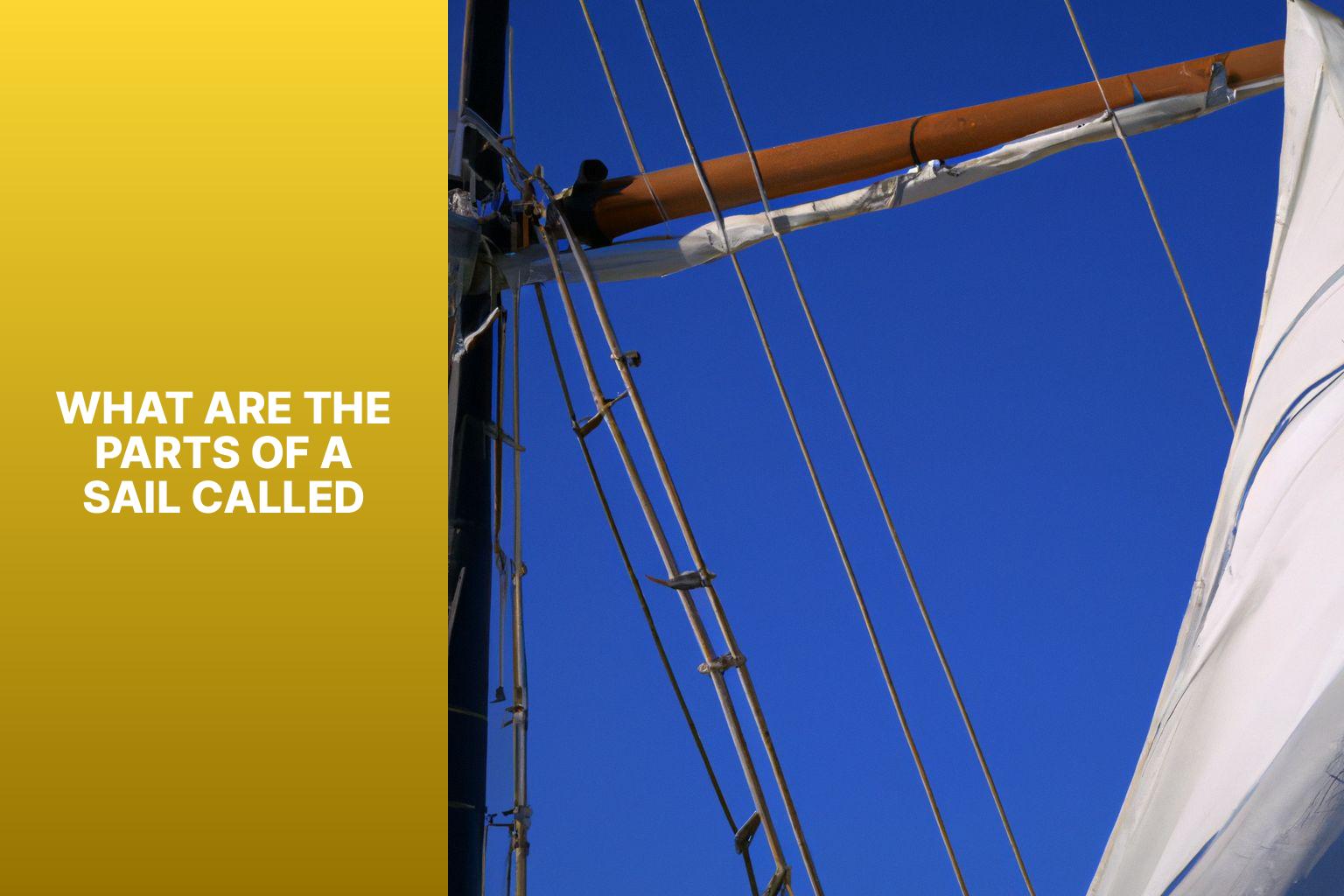
Introduction: What Are the Parts of a Sail?
Sails are the primary source of propulsion for sailboats, harnessing the power of the wind to propel the vessel through the water. To understand how sails work and how to effectively maneuver a sailboat, it is essential to have knowledge of the various parts of a sail.
1. Main Parts of a Sail
The main parts of a sail include the luff, leech, and foot. The luff is the leading edge, or the part of the sail that faces into the wind. The leech is the trailing edge of the sail, opposite the luff. The foot is the bottom edge of the sail that is attached to the boom.
2. Other Components of a Sail
In addition to the main parts, there are several other components that make up a sail. These include the head, tack, clew, battens, and sailcloth. The head is the top corner of the sail that connects to the top of the mast. The tack is the bottom forward corner of the sail, and the clew is the bottom aft corner of the sail. Battens are stiff rods or strips that are inserted into pockets on the sail to help maintain its shape. Sailcloth refers to the material used to construct the sail.
3. Specialized Sails and Their Parts
Depending on the type of sailboat and sailing conditions, there are specialized sails that may be used. Some examples include the genoa, spinnaker, and mainsail. Each of these sails has its own specific parts and components.
4. The Function of Each Sail Part
Each part of a sail plays a crucial role in its overall function and performance. The luff provides forward tension, allowing the sail to catch and utilize the wind. The leech helps control the twist and shape of the sail, ensuring optimal aerodynamic efficiency. The foot controls the power and draft of the sail, providing the necessary balance between power and control. The head connects the sail to the mast, providing stability and support. The tack and clew are attachment points that secure the sail to the boat, allowing for adjustments and control. Battens reinforce and maintain the shape of the sail, enhancing its performance. The sailcloth, which can vary in its composition, determines the strength, durability, and overall performance characteristics of the sail.
By understanding the different parts of a sail and their functions, sailors can effectively utilize their sails and optimize the performance of their sailboats.
Key takeaway:
- Main parts of a sail: The luff, leech, and foot are the primary components of a sail that play crucial roles in providing tension, controlling twist and shape, and determining power and draft.
- Other components of a sail: The head, tack, clew, battens, and sailcloth are additional elements that contribute to the overall performance and construction of a sail.
- Specialized sails and their parts: Sails like the genoa, spinnaker, and mainsail have their own unique design and components that serve specific purposes in different sailing conditions.
When it comes to sailing, understanding the different parts of a sail is essential . In this section, we’ll dive into the main components that make up a sail: the luff , the leech , and the foot . Each sub-section will take us on a journey exploring the significance and role of these sail parts. So, buckle up and get ready to navigate the seas of sail anatomy like a true sailor .
Table: Main Components of the Sail and Their Functions
The luff is a crucial part of the sail. It runs vertically along the mast and provides forward tension to prevent flapping and improve control. The luff shapes the leading edge of the sail, optimizing its aerodynamics and performance in different wind conditions.
Sailors must understand the function of each sail part, including the luff, to effectively use the power of the wind and maneuver their vessels with precision and speed.
Fact: The luff of a sail is reinforced with a luff tape or rope to enhance strength and durability, allowing it to endure the forces exerted by the wind.
The leech is a vital part of a sail that controls its twist and shape, contributing to its overall performance. It is located on the trailing edge of the sail. The leech is curved to allow smooth wind flow over the sail, reducing drag and increasing efficiency.
True story: Once, I went sailing with an experienced sailor who explained the significance of each sail component. As we set sail, he demonstrated how adjusting the leech tension could improve our speed by altering the sail’s twist. It was fascinating to see how such a small adjustment could make a big difference in performance. This experience reinforced my understanding of the leech’s crucial role in controlling the sail’s shape and optimizing efficiency on the water.
The “ 1.3 Foot ” of a sail is important for controlling power and draft. It refers to the bottom edge of the sail that runs parallel to the water surface. The foot determines the amount of power and draft generated by the sail. Power propels the sailboat forward, while draft refers to the curve or depth of the sail.
Adjusting the foot can flatten or increase the curvature of the sail, thus affecting power and maneuverability. Factors like wind conditions, boat size, and crew experience should be considered when adjusting the foot. For example, in light winds, a flatter foot may be preferable to maintain speed, while in strong winds, a deeper foot can provide stability.
By understanding and fine-tuning the foot, sailors can optimize their sail’s performance and sail safely and efficiently. Personal experience in a regatta highlighted the importance of adjusting the foot for control and speed. This experience demonstrated how understanding and utilizing the different parts of a sail can lead to optimal performance. So, the next time you set sail, pay attention to the foot and its impact on power and draft for a smooth and enjoyable sailing experience.
When it comes to sails, there’s more than meets the eye. In this section, we’ll take a closer look at the other components that make up a sail. From the head to the tack , the clew to the battens , and the sailcloth that holds it all together, we’ll explore the fascinating anatomy of a sail and how each of these parts plays a crucial role in harnessing the power of the wind. So, get ready to set sail on this informative journey!
The head is an essential part of a sail that connects to the mast. It maintains the stability and balance of the sail.
Here is a table summarizing the characteristics of the head :
The head of a sail is designed to withstand wind forces and keep the sail secure. It is reinforced with webbing or additional fabric layers to enhance strength. The attachment method varies, but it is always securely fastened to ensure the sail stays in place while sailing.
The head also serves as a reference point for controlling the sail. Sailors use lines and fittings, such as halyards and shackles, to adjust tension and position. These adjustments optimize the sail’s performance in different wind conditions.
Tack , the bottom forward corner of the sail, plays a crucial role in the sail’s performance. It is the part that connects the sail to the boat at the front, or bow.
The tack bears the greatest strain and tension from the wind pushing against the sail. Improperly aligned tack can greatly affect the overall shape and efficiency of the sail, leading to reduced performance.
To adjust the tack , its position on the boat can be moved or the lines connected to it can be tensioned. Having a well-positioned and properly tensioned tack is vital for maintaining control and maximizing the sail’s performance.
The 2.3 clew is a crucial part of a sail, located at the bottom aft corner of the sail. It connects the sail to the boom and plays a key role in controlling the shape , power , and twist of the sail. The clew has multiple functions that contribute to the sail’s overall performance.
In terms of shape control , the 2.3 clew maintains proper tension along the foot of the sail, affecting the draft and power . Sailors can adjust the clew’s position to fine-tune performance for different wind conditions and sailing angles.
The 2.3 clew also helps control the twist of the sail, which is the difference in angle between the top and bottom of the sail. By adjusting the tension on the clew, sailors can optimize efficiency and lift by controlling the amount of twist.
Pro Tip: When adjusting the 2.3 clew , pay attention to the sail’s overall balance and trim. Small adjustments can have a significant impact on performance, so experimenting with different clew positions can help find the optimal spot for sailing.
Using a table, the information can be visually organized as follows:
2.4 Battens
Battens reinforce and maintain a sail’s shape. They are long strips made of materials like fiberglass or carbon fiber and are inserted into pockets or sleeves along the length of the sail.
Battens provide structural support to the sail, preventing it from sagging or flapping in the wind. They help maintain the desired aerodynamic shape, which is crucial for efficient sailing.
By reinforcing the trailing edge of the sail, battens help reduce flogging or fluttering. This improves the sail’s performance by maintaining a smooth airflow over the surface.
Battens add stiffness and stability to the sail, aiding in sail control. They help adjust the sail’s performance for different wind conditions and points of sail.
Battens distribute loads and stresses evenly across the sail, reducing wear and tear on the sailcloth. They can also minimize the risk of chafing or damage caused by friction with the mast or rigging.
2.5 Sailcloth
Sailcloth is crucial for sails as it determines performance and durability. It is made from synthetic fibers like polyester, aramid, or carbon, woven in specific patterns for strength and lightness.
Here is a table showing different types of sailcloth and their characteristics:
Understanding the characteristics of different sailcloth options is important when choosing the right material. Consider factors such as budget, intended use, and desired performance.
Pro tip: Consult with sailmakers or experienced sailors for guidance based on your specific needs and sailing conditions. Consider wind conditions, boat type, and sailing goals when selecting sailcloth.
Specialized sails play a crucial role in the performance of a sailboat. In this section, we’ll explore three key types: the Genoa , the Spinnaker , and the Mainsail . Each sub-section will unravel the distinct characteristics and functions of these sails, shedding light on how they enhance the sailing experience. So, let’s hoist our curiosity and set sail to discover the fascinating world of these specialized sails and their intricate parts!
The “ 3.1 Genoa ” sub-topic focuses on the main components of a genoa sail and their function.
The genoa sail is vital for modern sailing vessels, providing power and maneuverability. Understanding the different parts and their functions can help sailors optimize their performance and make necessary adjustments based on wind conditions and desired outcomes.
3.2 Spinnaker
Below is a table that shows the components of a spinnaker :
A spinnaker is a sail used for downwind sailing. It is large and full, designed to catch wind and propel the boat forward. The luff, leech, and foot of the spinnaker are the main edges that determine its shape and size. The head, tack, and clew are the corners of the sail that attach to the boat. Battens are inserted into pockets to maintain the sail’s shape. The sailcloth is the material that the sail is made of, and its strength and weight can vary depending on the intended use of the spinnaker.
Pro-tip: Properly trim and control the spinnaker to maximize its performance. Experiment with different settings and learn how to adjust the luff, leech, and foot to achieve the desired speed and stability. Regular maintenance of the sailcloth and battens will prolong the lifespan of the sail and keep it in optimal condition.
3.3 Mainsail
The mainsail is a vital component of a sailboat, providing propulsion and control. It is attached to the main mast and generates forward thrust. The mainsail consists of various components that play a crucial role in shaping the sail and optimizing its performance.
One of the main components of the mainsail is the luff , which provides forward tension and maintains the shape of the leading edge of the sail. The leech controls the twist of the sail and shapes the trailing edge. The foot is responsible for controlling the power and draft of the sail, affecting its performance in different wind conditions. The head connects the sail to the top of the mast and provides support. The tack forms the bottom forward corner of the sail and attaches it to the boom or other hardware. The clew forms the bottom aft corner of the sail and controls its shape and tension. To reinforce and maintain the shape of the sail, battens are used, which provide stability and optimize performance. The sailcloth , chosen for durability, weight, and performance, is the material used to construct the sail.
The mainsail is essential for maneuvering and controlling the sailboat. It allows sailors to adjust the sail’s shape and adapt to changing wind conditions. When the wind fills the surface of the mainsail, it generates lift and propulsion. Having a good understanding of the different components of the mainsail enables sailors to best optimize their sailing experience and maximize the boat’s performance on the water.
For thousands of years, sails have been used to harness the power of the wind and explore the world. The mainsail has always been a fundamental part of sailing vessels, providing propulsion and control. Over time, advancements in sail design and technology have greatly improved the efficiency and performance of mainsails. This has enabled sailors to navigate the seas with greater speed and precision. Today, the mainsail remains an integral component of sailboats, allowing sailors to embark on new adventures and experience the thrill of harnessing the wind’s power.
Discover the fascinating world of sail anatomy as we explore the function of each sail part. From the luff that provides forward tension to the clew that anchors the sail, we’ll uncover the integral roles of these components. Learn how the leech controls twist and shape, while the foot governs power and draft. Dive into the details of the head , tack , battens , and sailcloth , as we unravel the secrets behind constructing sails. Get ready to set sail on an informative journey!
4.1 Luff: Provides Forward Tension
The luff , which is a crucial part of a sail that provides forward tension, plays an essential role in maintaining the proper shape and positioning of the sail. It is located at the leading edge of the sail and attaches to the mast. The luff consists of components such as the mast groove , mast track , hanks , or slides , depending on the specific sail and rigging system.
One of the primary functions of the luff is to ensure optimal aerodynamic performance of the sail. By creating tension along the leading edge, it enables the sail to effectively harness the power of the wind and generate forward propulsion. This is key to achieving efficient sailing and maximizing speed.
The amount of tension in the luff is crucial as it directly impacts the shape and overall performance of the sail. If the luff is too loose, the sail may twist excessively or flap, resulting in a loss of power. On the other hand, if the luff is too tight, the sail may become flat, leading to reduced lift and speed.
Properly tensioning the luff plays a vital role in effectively harnessing the power of the wind. Sailors must adjust the sail’s halyard and luff tension to find the desired balance between power and control.
Understanding the importance of the luff and how it provides forward tension can help sailors make informed decisions about rigging and sail choices. It ultimately contributes to optimizing performance and ensuring a successful sailing experience.
4.2 Leech: Controls Twist and Shape
The leech , which controls the twist and shape of the sail, is a crucial element in sailing. It runs from the head to the clew, forming the aft edge of the sail. Sailors have the ability to adjust the tension along the leech , which directly affects the amount of twist in the sail. Twist , defined as the angle between the leech and the luff of the sail, plays a vital role in achieving balance and optimal performance in different wind conditions.
Maintaining the correct amount of twist is essential, and to achieve this, sailors must properly control the tension along the leech . By increasing leech tension, the twist reduces, resulting in a more powerful sail. In gusty winds, this may make the sail less forgiving. On the other hand, decreasing leech tension allows for increased twist , enabling excess wind to spill out and maintaining control of the sail.
To effectively control the twist and shape using the leech , sailors must regularly check and adjust the tension based on the prevailing wind conditions. Experimentation with different settings and closely observing sail performance will aid in determining the ideal leech tension for various sailing scenarios. Although fine-tuning leech tension may require some experience and practice, doing so greatly enhances a sailor’s ability to optimize their sail’s overall performance and efficiency.
4.3 Foot: Controls Power and Draft
The foot of a sail, also known as the “lower edge,” plays a crucial role in controlling power and draft. It is responsible for maintaining the sail’s shape and optimizing its performance. To better understand its importance, envision a table that represents key components of a sail.
Among these components, the foot sits at the bottom edge and is primarily responsible for controlling power and draft. By adjusting tension in the foot , sailors can effectively shape the sail. A tighter foot flattens the sail, reducing power but increasing speed. On the other hand, a looser foot allows for more power and draft, which is particularly advantageous in lighter wind conditions or when sailing downwind .
Achieving the right balance between power and draft is crucial for maximizing speed and maneuverability. Therefore, sailors must carefully adjust the tension in the foot to optimize the sail’s performance. This requires a keen understanding of the sail’s behavior and how it responds to adjustments in tension.
The foot is just one of many components that contribute to the overall performance of a sail. Other vital components include the luff , leech , head , tack , clew , battens , and sailcloth . Each component has a unique function in ensuring the sail operates at its best.
4.4 Head: Connects to the Top of the Mast
The head of a sail is crucial. It connects to the top of the mast and provides stability and control to the entire sail, impacting its performance and overall sailing experience.
The head allows adjustments to the angle and shape of the sail, which can greatly affect speed and maneuverability . It also needs to withstand the forces exerted by the wind, so it must be securely attached to the mast with reinforcements and specific materials for durability .
The placement of the head affects the sail’s balance and allows for better weight distribution in different wind conditions. This optimization enhances the sail’s performance.
Sails have been used for thousands of years, enabling humans to harness the power of the wind for transportation and exploration. The design and construction of sails have evolved over time to optimize their functionality. Each part of a sail serves a specific purpose, and the head, connecting to the top of the mast, is essential for successful sailing endeavors.
4.5 Tack: Bottom Forward Corner of the Sail
The tack , located at the bottom forward corner of the sail, is a crucial part of the sail’s rigging. It serves multiple functions that are essential for safe and efficient sailing.
The tack acts as the attaching point, connecting the sail to the boat’s deck or a fitting known as a tack fitting . This secure attachment is vital to withstand the significant forces experienced, especially when sailing upwind.
The tack helps control the shape of the sail, which directly impacts its overall performance. By adjusting the tension at the tack , sailors can optimize the sail shape to suit different sailing conditions.
The position of the tack plays a significant role in the sail’s responsiveness. By adjusting the tack position, sailors can effectively change the angle of attack and enhance the sail’s ability to react to changes in wind direction.
In addition to shape and responsiveness, the tack also contributes to sail control maneuvers like tacking . During a tack , the sail is released from one side and set on the other side at the tack point. This maneuver is vital for changing sailing direction smoothly.
The tack’s position also affects the overall balance of both the sail and the boat. Fine-tuning the tack allows sailors to maintain optimal balance, ensuring stability and maximizing performance.
The tack is involved in determining the sail’s total area. Along with other corners like the head and clew, adjustments to the tack can impact the amount of sail area exposed to the wind. This, in turn, influences the overall sail area and performance.
In summary, the tack , located at the bottom forward corner of the sail, is an integral part of sailing. It fulfills various important functions, including attaching the sail securely, controlling sail shape, enhancing responsiveness, facilitating sail control maneuvers, maintaining sail and boat balance, and influencing sail area. Mastering the proper handling and adjustment of the tack is crucial for safe and efficient sailing.
4.6 Clew: Bottom Aft Corner of the Sail
The clew , also known as the bottom aft corner of the sail, plays a crucial role in the function and performance of the sail. There are several key aspects to consider regarding the clew attachment point. The clew attaches the sail to the boom , which is a horizontal spar along the bottom of the sail. This attachment is secured with a clew eye or clew grommet specifically designed for this purpose.
In addition to attachment, the clew also controls the shape and tension of the sail. By adjusting the tension at the clew , sailors can optimize airflow and enhance the sail’s performance. The positioning and tension of the clew have a significant influence on the sail’s power and speed. By adjusting the clew position along the boom , sailors can fine-tune the sail’s draft and effectively control power output.
The clew also plays a role in sail handling and maneuverability. Proper clew control allows sailors to effectively trim the sail in different wind conditions, maximizing efficiency and control. It is worth noting that some sails have reinforcements specifically focused on the clew area, such as clew patches or straps. These reinforcements distribute the load and strengthen the sail’s structure at this critical corner.
Understanding the importance of the clew and its impact on sail performance helps sailors make informed decisions when adjusting sail trim and optimizing their sailing experience.
4.7 Battens: Reinforce and Maintain Sail Shape
Battens are essential for reinforcing and maintaining the shape of a sail . To properly incorporate battens, follow these steps:
1. Carefully insert long, thin battens into pockets or sleeves located along the trailing edge of the sail.
2. The number and placement of the battens will vary depending on the type and size of the sail.
3. By preventing curling or flapping, battens play a crucial role in maintaining the efficiency and performance of the sail.
4. Battens contribute rigidity and structure to the sail, effectively controlling its shape and reducing wrinkles or distortion.
5. Another benefit of battens is that they stabilize the sail, effectively resisting any twisting and enhancing the sail’s aerodynamic profile.
6. When it comes to choosing the batten material, sailors have the option of selecting from solid fiberglass, carbon fiber, or flexible materials , allowing for adjustable batten systems.
7. It is important to carefully and securely insert and secure the battens into the designated pockets or sleeves to ensure a safe and stable sailing experience.
8. It is crucial to regularly inspect and maintain the battens to address any damages or signs of wear, ensuring their effectiveness in maintaining sail shape.
Did you know? Battens have been utilized in sailing for thousands of years, with their origins dating back to ancient Egyptian and Phoenician ships. Over time, advancements in material technology have led to the development of lighter and more flexible battens, ultimately enhancing the efficiency and durability of modern sails.
4.8 Sailcloth: Material Used to Construct Sails
Sailcloth, the material used to construct sails, is crucial for sail performance and durability. Different sailcloth types, such as polyester , nylon , or a combination of both, have varying characteristics including strength , weight , and flexibility .
The choice of sailcloth depends on specific sailing requirements. For racing sails, lightweight and high-performance materials like carbon fiber or aramid fibers are popular due to their excellent strength-to-weight ratios , which enhance speed and maneuverability .
On the other hand, cruising sails prioritize durability and longevity , often utilizing Dacron , a type of polyester. Dacron is affordable, durable, and can withstand prolonged exposure to sunlight and harsh weather conditions .
High-quality sailcloth directly impacts a sail’s shape-holding ability , which in turn affects performance and efficiency on the water. With better-shaped sailcloth, improved control and power delivery can be achieved.
When selecting sailcloth, important factors to consider include sail size, sailing conditions, and budget. Consulting with a sailmaker or experienced sailor can help in choosing the appropriate sailcloth for specific needs.
Keep <table> tags intact, if found.
Some Facts About What Are The Parts Of A Sail Called:
- ✅ The highest point of a sail is called the head. (Source: https://www.1066.co.nz/Mosaic%20DVD/text/boats/Parts%20of%20a%20sail.htm)
- ✅ The lower two corners of a sail are called the tack (forward) and clew (aft). (Source: https://www.1066.co.nz/Mosaic%20DVD/text/boats/Parts%20of%20a%20sail.htm)
- ✅ On a square sail or symmetrical spinnaker, each of the lower corners is a clew, but the corner to which the sheet is attached is called the clew. (Source: https://www.1066.co.nz/Mosaic%20DVD/text/boats/Parts%20of%20a%20sail.htm)
- ✅ The foot of a sail is its lowest edge, bounded by the clew and the tack. (Source: https://www.1066.co.nz/Mosaic%20DVD/text/boats/Parts%20of%20a%20sail.htm)
- ✅ The shape of a sail often includes an arc of extra material on the leech called the roach, which is supported by battens. (Source: https://en.wikipedia.org/wiki/Sail_components)
Frequently Asked Questions
What are the parts of a sail called.
The parts of a sail are called the head, luff, leech, foot, tack, and clew. The head is the top of the sail, the luff is the front leading edge, the leech is the aft edge, the foot is the bottom edge, the tack is the forward lower corner, and the clew is the aft lower corner.
What is the purpose of battens in a sail?
Battens are long thin strips made of fiberglass or wood that support the sail. They help maintain the shape and stability of the sail, especially in moderate winds.
What is a roach in a sail?
A roach is the curved area on the leech of a sail that extends beyond the line between the head and clew. It provides extra power and performance to the sail.
How does a sail change course?
When changing course, a sail undergoes tacking, which means turning the boat’s head into and through the wind. This allows the boat to change direction as the wind comes over the opposite side of the sail.
What are tell tales in a sail used for?
Tell tales are light strips of material attached to the sail to indicate whether the air stream on the sail surface is smooth or turbulent. They help sailors determine if the sails are properly trimmed and provide valuable feedback on the performance of the sail.
What is the purpose of a sail track?
A sail track is a slot on the mast that is used for attaching the sail. It allows the sail to be raised and lowered easily and also provides a secure attachment point for the sail. The sail track ensures proper alignment and tension of the sail.
About the author
Leave a Reply Cancel reply
Your email address will not be published. Required fields are marked *
Save my name, email, and website in this browser for the next time I comment.
Latest posts

The history of sailing – from ancient times to modern adventures
History of Sailing Sailing is a time-honored tradition that has evolved over millennia, from its humble beginnings as a means of transportation to a beloved modern-day recreational activity. The history of sailing is a fascinating journey that spans cultures and centuries, rich in innovation and adventure. In this article, we’ll explore the remarkable evolution of…

Sailing Solo: Adventures and Challenges of Single-Handed Sailing
Solo Sailing Sailing has always been a pursuit of freedom, adventure, and self-discovery. While sailing with a crew is a fantastic experience, there’s a unique allure to sailing solo – just you, the wind, and the open sea. Single-handed sailing, as it’s often called, is a journey of self-reliance, resilience, and the ultimate test of…

Sustainable Sailing: Eco-Friendly Practices on the boat
Eco Friendly Sailing Sailing is an exhilarating and timeless way to explore the beauty of the open water, but it’s important to remember that our oceans and environment need our protection. Sustainable sailing, which involves eco-friendly practices and mindful decision-making, allows sailors to enjoy their adventures while minimizing their impact on the environment. In this…

Most Popular Types of Sails on a Sailboat
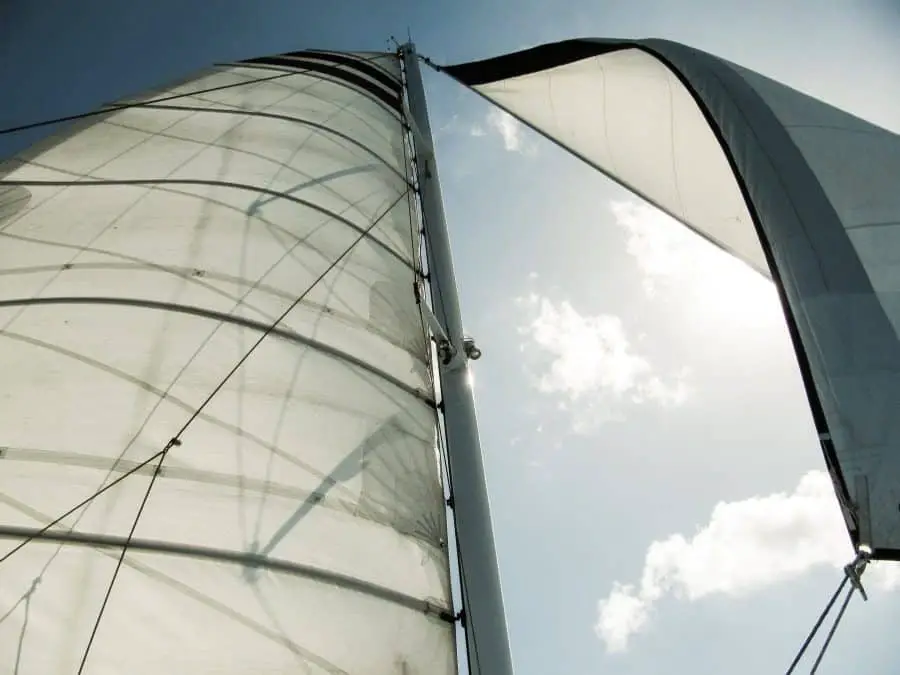
Learning about how there were different types of sails on sailboats for me was a bit strange at first. I thought something along the lines of “Don’t you just need to put some fabric on some polls and grab the wind?” Obviously, there’s far more to it than that.
So what are the most popular types of sails on sailboats? The mainsail, headsail (or jib), genoa, spinnaker, and gennaker are the most popular types of sails on sailboats. There are also a number of different configurations when considering the type of sail and mast in use including a sloop, fractional rig sloop, cutter, ketch, schooner, yawl, and cat.
Simply put, different sailboat sails serve different purposes when out on the water.
The sail is kind of like the “engine” of your sailboat (of course, sailboats can have actual engines) in that it’s the main source of forward propulsion.
So, it’s important to know when best to use either type of sail and why including the many different names of sails on a ship.
Types of Sails
There are a number of reasons why you’d want to use one sail over another, but the most important points to consider have to do with the point of sail you’re sailing in and the wind strength.
Maybe you need downwind sails, square sails, or a triangular sail. Maybe a unique sail shape, sail cloth, or sail area. With that in mind, let’s check out the different sail types!
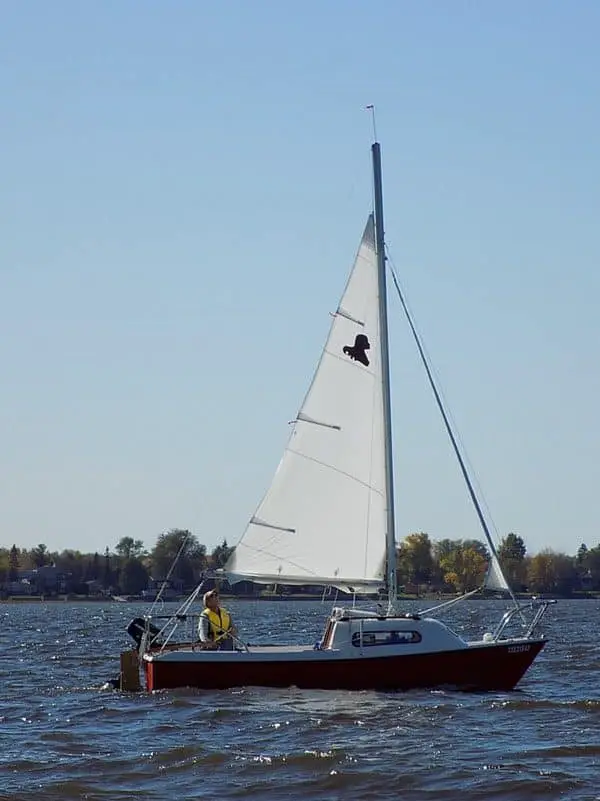
The mainsail is by far the most popular type of sail on sailboats and is often the first image that comes to mind when thinking about a sailboat.
Mainsails are found behind the mast and attached to the boom, which makes it a common part of the sailboat to keep an eye on as it takes up a lot of real estate on a boat with sails especially during a sail tack.
Mainsails are able to cover a lot of surface area with respect to incoming winds, especially since they’re attached to the boom.
The fact that they have a large surface area means they don’t require very strong winds to provide good forward propulsion on a sailboat.
Also, since the position of the mainsail can be easily configured thanks to the boom, all points of sail are achievable.
Headsail/Jib

The headsail (or jib) is probably the second most popular type of sail on sailboats since it usually accompanies the mainsail.
The headsail is always placed at the front of the mast and can cover a good amount of the bow of the sailboat. It’s also smaller than a mainsail, making it more portable and easy to work with.
Headsails aren’t as big as mainsails, therefore they have a smaller surface area which results in the fact that they’re not capable of catching as much wind as a mainsail.
This is an important point though since if the current wind is exceptionally strong and your mainsail has been trimmed as much as possible, being able to put away your mainsail and depend on your headsail alone is an excellent strategy to reduce speed.
When the wind is just too strong to keep your mainsail out, putting it away and using only your headsail is a great option.
You won’t be grabbing as much wind as with the mainsail and you’ll be able to have a much more enjoyable (and safer!) sailing experience.
One of the most picturesque sailing images one can conjure up is the one with a sailboat using a genoa sail (see the image above on the right).
A genoa is a type of large jib that’s attached to the front of the forestay just like a headsail.
One of the main differences with the genoa sail is that it’s bigger than the normal headsail and oftentimes extends behind the mast partially or completely covering the mainsail. It actually used to be called an “overlapping jib”.
Using a genoa sail means you have light to medium winds and your sailboat is more or less in a dead run point of sail (wind coming directly from the rear or sailing downwind).
Since the surface area of a genoa sail is so large, it’s important only to use it when winds are relatively low. Otherwise, you’ll be moving exceptionally fast resulting in a potentially risky situation.
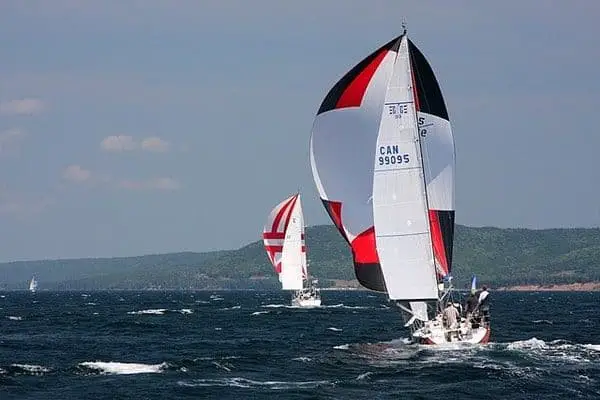
A spinnaker sail is a fun sail to use since it’s quite large, colorful, and can pick up a lot of wind.
Unlike a genoa sail, they’re often symmetrical making them more sensitive to the reaching points of sail and thus more appropriate for the running point of sail. They’re also lighter and have a “kite” kind of feel to them.
The reason they resemble a “kite” is not only that they’re generally lighter and more colorful than other types of jibs, but also they don’t cover the mast like a genoa sail.
Instead, they don’t attach to the forestay and stretch out toward and past the bow of a sailboat. Since they’re bigger than genoa sails, you want to be even more careful to only use them in relatively low and non-volatile wind environments.
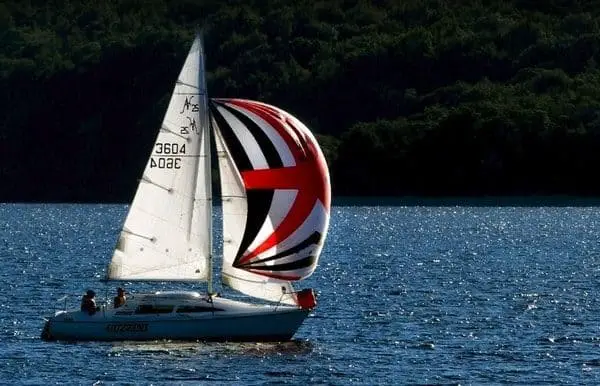
A gennaker sail is a more recent type of sail on sailboats since they were developed around 1990.
Gennakers are a cross between genoa and spinnaker sails (as the name might suggest), which are big like a spinnaker, aren’t as symmetric as a spinnaker, and aren’t attached to the forestay like a genoa sail or headsail.
The reason for the invention of the gennaker is that sailors wanted to take advantage of lighter winds without having to resort to using a spinnaker if the winds change from a pure dead run to more of a reaching point of sail.
All in all, the gennaker sail is able to bridge the performance gap between a genoa and spinnaker sail in terms of being able to take on a more flexible point of sail while taking advantage of relatively softer winds.
Popular Sail and Mast Configurations
Now that you’re familiar with the most popular types of sails on a sailboat, it’s good to get an idea of how these sail types relate to the configuration of a sailboat’s mast.
There are a huge number of combinations when it comes to sails and mast configurations, so I thought I’d lay out the most popular ones you’ll likely run into out on the water.
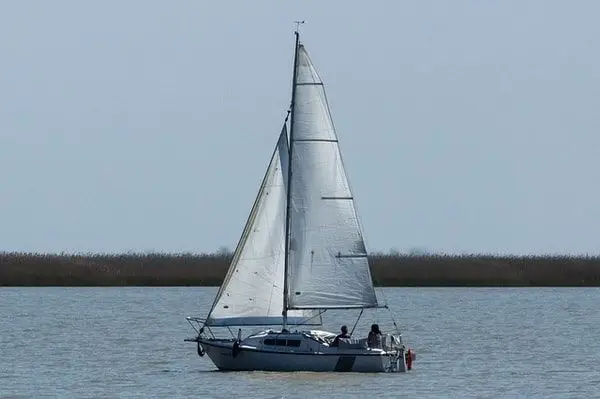
A sloop is the most common type of sail and mast configuration for sailboats. The sloop is the classic single mast, double sail setup.
The sails on a sloop consist of a mainsail and a headsail. The headsail can be different types of jibs, including the genoa, spinnaker, or gennaker sails. The headsail is connected to the forestay on the mast and runs all the way to the top of the mast.
Fractional Rig Sloop
Similar to a sloop, a fractional rig sloop has a single mast, double sail setup. The only difference, however, is that the forestay doesn’t reach the top of the mast, resulting in the headsail being restricted to a fractional amount of space a normal sloop would allow for.
This reduction of surface area for the headsail means that less wind can be captured and, thus, reduced sailboat speed.
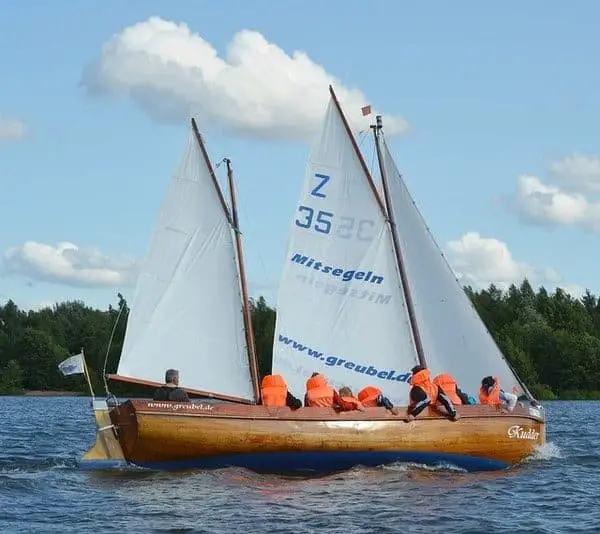
A cutter is an interesting setup since it’s just like the sloop and fractional rig sloop setup, but instead of one forestay it has two. With two forestays on the mast, cutters are able to house two headsails.
This can be a preferred setup because it allows for easy cruising due to it offering a diverse combination of points of sail for different strengths of wind.
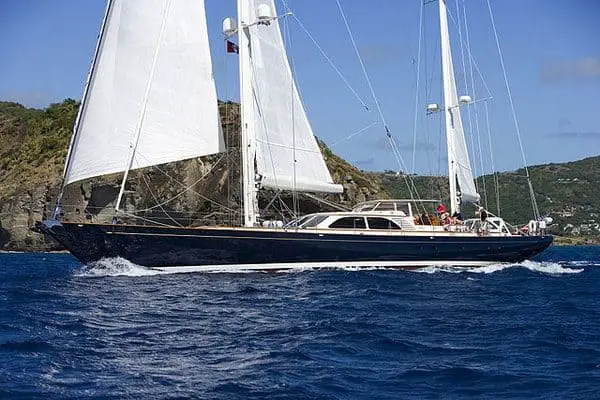
A ketch is a less common setup when compared to the previous setups since it has two masts.
Just like a sloop, it has a mast that allows for a mainsail and headsail with a full range forestay, but it also has a smaller sized mast between the mainmast and the stern of the sailboat.
This mast configuration was commonly used in Northern European freighter and fishing boats and is called the mizzen mast.
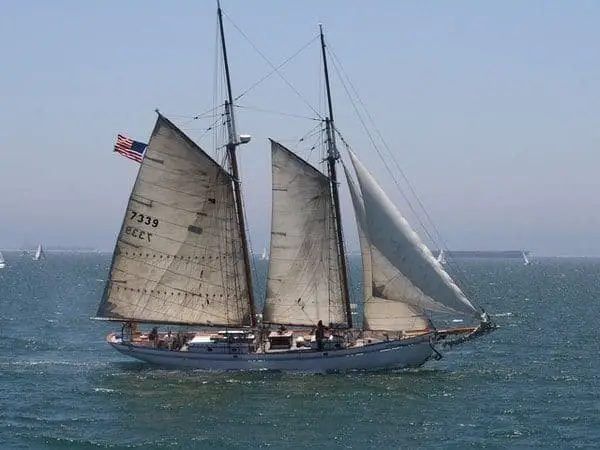
If you’ve ever seen Pirates of the Carribean, you’ll have seen almost nothing but schooners. A schooner is when a sailboat has two or more masts, similar to a ketch, while having a number of sails to manage.
The main differences between a ketch and a schooner are that a schooner’s aft mast (the rear mast) is taller than the forward mast and a schooner can have up to six masts some including a square sail or two. This makes names of sails on a schooner the fore and aft sail (or fore and aft rig).
A yawl is almost identical to a ketch with the only difference being that the mizzen mast is located directly behind the sailboat’s rudder post. In terms of a ketch vs yawl, the mizzen sail is also much smaller than the mizzen sail on a ketch due to its position on the sailboat.
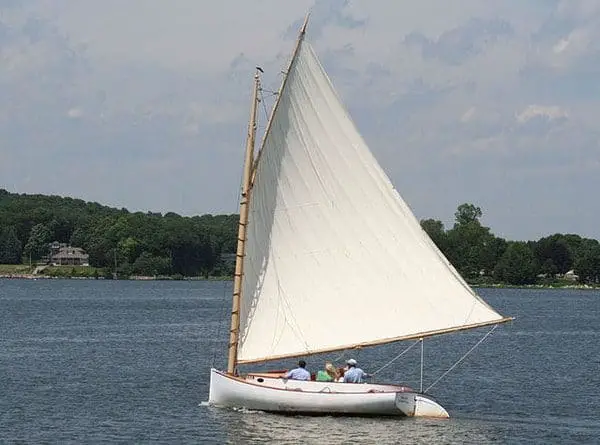
A cat has one mast and one sail with the mast being positioned at the bow of the sailboat. This mast configuration is most commonly found on smaller sailboats, especially dingy sailboats. These types of sailboats are colloquially called “catboats”.
Get the very best sailing stuff straight to your inbox
Nomadic sailing.
At Nomadic Sailing, we're all about helping the community learn all there is to know about sailing. From learning how to sail to popular and lesser-known destinations to essential sailing gear and more.
Quick Links
Business address.
1200 Fourth Street #1141 Key West, FL 33040 United States
Copyright © 2024 Nomadic Sailing. All rights reserved. Nomadic Sailing is a participant in the Amazon Services LLC Associates Program, an affiliate advertising program designed to provide a means to earn fees by linking to Amazon.com and affiliated sites.

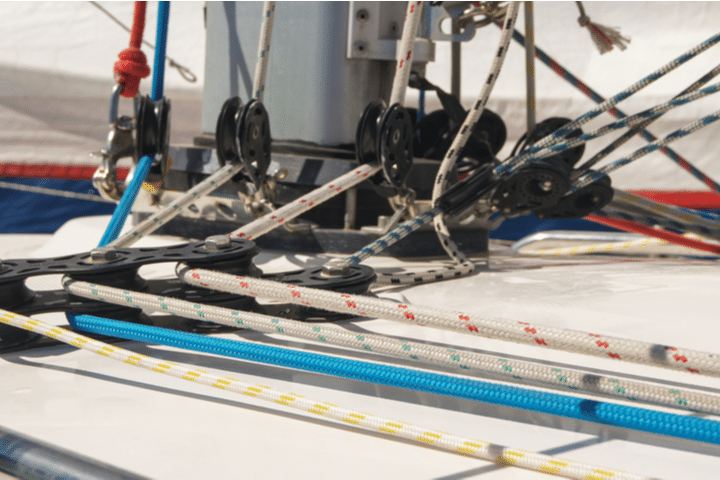
A Guide to the Different Parts of a Sailboat

Table of Contents
When you use Boatsetter, you have the opportunity to choose from a myriad of different sailboat rentals from all over the United States and beyond . A sailboat is a perfect way to relax on the water, either on a solo adventure or on an excursion with friends and family.
When you rent a sailboat with Boatsetter, you will have the option to book a captained sailboat to enjoy your day out on the water or book bareboat to hone your sailing skills. Either way, you may be interested in the intricacies of a sailboat and its different parts. If this sounds like you, you have come to the right place. In this article, we go in-depth about the different parts of a sailboat so that you can be more knowledgeable about whatever boat you may choose and come away from reading this feeling more confident about the whole sailing experience.
A basic sailboat is composed of at least 12 parts: the hull , the keel , the rudder , the mast, the mainsail, the boom, the kicking strap (boom vang), the topping lift, the jib, the spinnaker, the genoa, the backstay, and the forestay. Read all the way through for the definition of each sailboat part and to know how they work.
Explore sailboats for rent near you or wherever you want to go
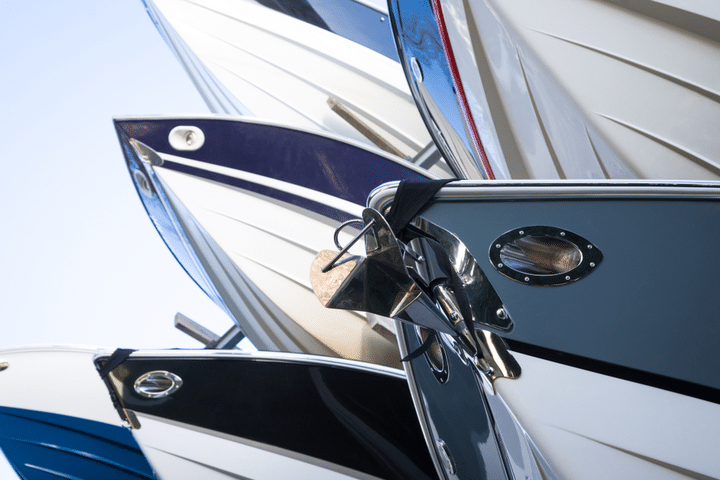
In short, the hull is the watertight body of the ship or boat. There are different types of hulls that a sailboat may have, and these different hulls will often affect the speed and stability of the boat.
Displacement Hulls
Most sailboats have displacement hulls , like round bottom hulls, which move through the water by pushing water aside and are designed to cut through the water with very little propulsion. The reason these are called displacement hulls is that if you lower the boat into the water, some of the water moves out of the way to adjust for the boat, and if you could weigh the displayed water, you would find that it equals the weight of the boat, and that weight is the boat’s displacement. One thing to know about displacement hulls is that boats with these hulls are usually limited to slower speeds.
Planing Hull
Another type of hull is a planing hull. These hulls are designed to rise and glide on top of the water when enough power is supplied. When there is not enough power behind the boat, these boats often act as displacement hulls, such as when a boat is at rest. However, they climb to the surface of the water as they begin to move faster. Unlike the round bottom displacement hulls, these planing hulls will often have flat or v-shaped bottoms. These are very common with motor-driven water vessels, such as pontoon boats, but they can also be found on smaller sailboats which allow them to glide quickly over the water.
Finally, sailboats can differ depending on the number of hulls that they have. There are three options: monohulls (one hull), catamarans (two hulls), and trimarans (three hulls).
Monohulls , which have only a single hull, will usually be the typical round bottom displacement hull or occasionally the flat bottomed or v-shaped planning hull. Catamarans have two hulls with a deck or a trampoline in between, with the extra hulls providing increased stability. Finally, trimarans have three hulls — a main hull in the middle and two side hulls used for stability. These trimarans have gained popularity because of their excellent stability and ability to go at high speeds.
When evaluating a sailboat , it is important to pay attention to the type of hull that the boat has because the type of hull a sailboat has can drastically change the sailing experience, especially when it comes to stability and speed.
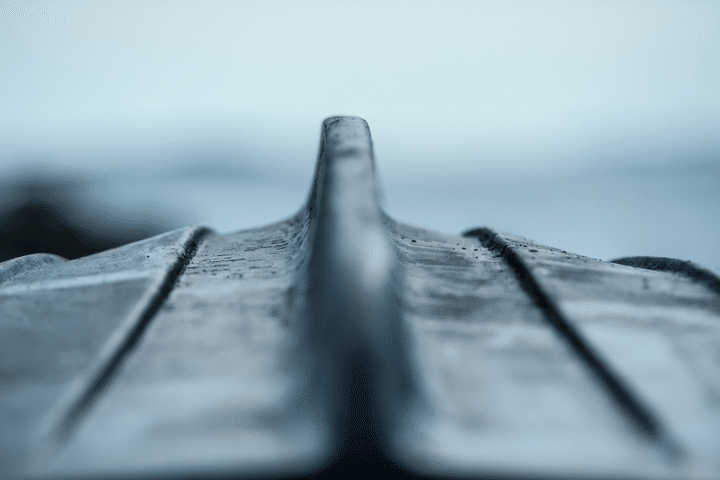
All sailboats have a keel, a flat blade sticking down into the water from the sailboat’s hull bottom. It has several functions: it provides counterbalance, life, controls sideways movement, holds the boat’s ballast , and helps prevent the boat from capsizing. When a boat leans from one side to the other, the keel and its ballast counteract the movement and prevent the boat from completely tipping over.
As with hulls, there are a number of different types of keels, though the two most common types of keels on recreational sailboats are the full keel or the fin keel. A full keel is larger than a fin keel and is much more stable. The full keel is generally half or more of the length of the sailboat. However, it is much slower than the fin keel. A fin keel, which is smaller than the full keel, offers less water resistance and therefore affords higher speeds.
A more recent feature on sailboats is the “winged keel,” which is short and shallow but carries a lot of weight in two “wings” that run sideways from the keel’s main part. Another more recent invention in sailing is the concept of the canting keels, which are designed to move the weight at the bottom of the sailboat to the upwind side. This invention allows the boat to carry more sails.
The Rudder
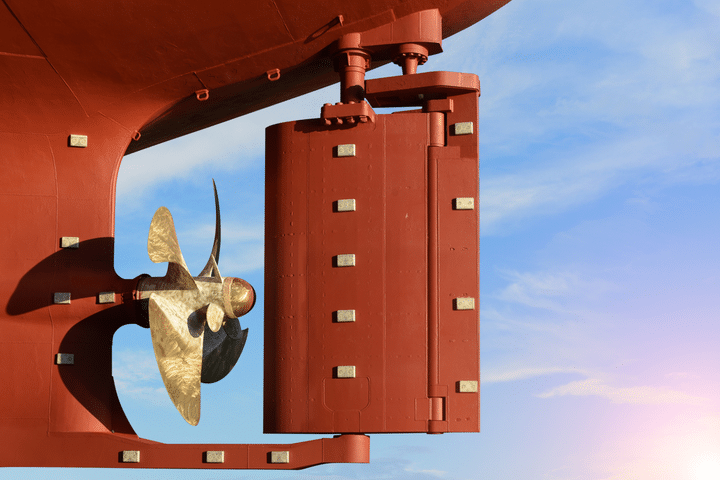
A rudder is the primary control surface used to steer a sailboat. A rudder is a vertical blade that is either attached to the flat surface of the boat’s stern (the back of the boat) or under the boat. The rudder works by deflecting water flow. When the person steering the boat turns the rudder, the water strikes it with increased force on one side and decreased force on the other, turning the boat in the direction of lower pressure.
On most smaller sailboats, the helmsman — the person steering the boat — uses a “ tiller ” to turn the rudder. The “tiller” is a stick made of wood or some type of metal attached to the top of the rudder. However, larger boats will generally use a wheel to steer the rudder since it provides greater leverage for turning the rudder, necessary for larger boats’ weight and water resistance.
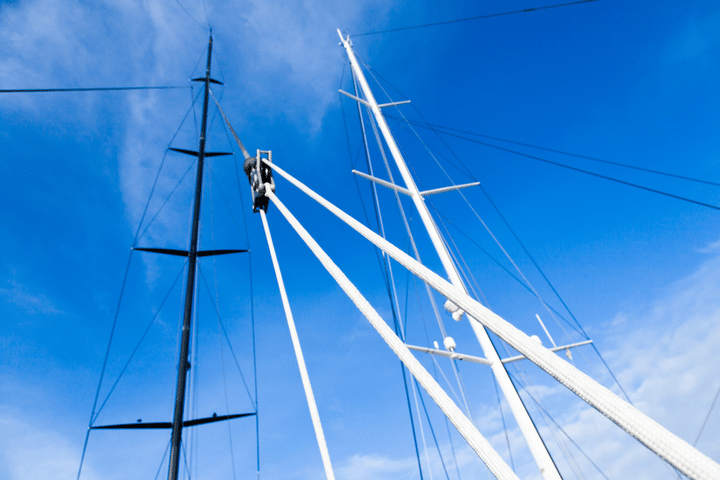
The mast of a sailboat is a tall vertical pole that supports the sails. Larger ships often have multiple masts. The different types of masts are as follows:
(1) The Foremast — This is the first mast near the bow (front) of the boat, and it is the mast that is before the mainmast.
(2) The Mainmast — This is the tallest mast, usually located near the ship’s center.
(3) The Mizzen mast — This is the third mast closest to the stern (back), immediately in the back of the mainmast. It is always shorter than the mainmast and is typically shorter than the foremast.
The Main Sail
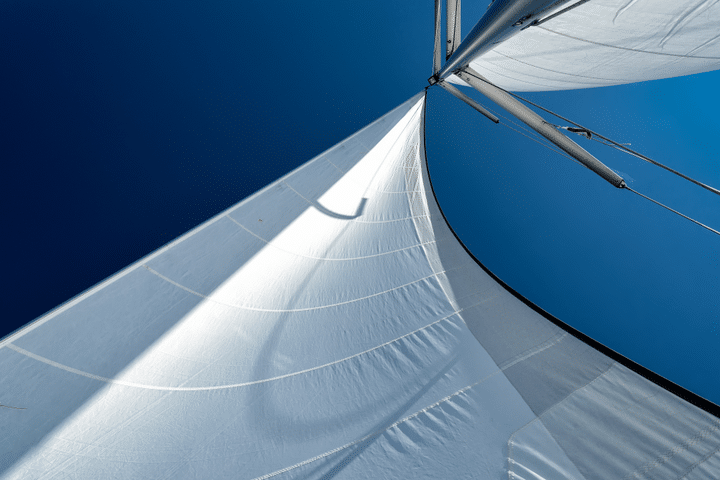
The mainsail is the principal sail on a sailboat, and it is set on the backside of the mainmast. It is the main source that propels the boat windward.
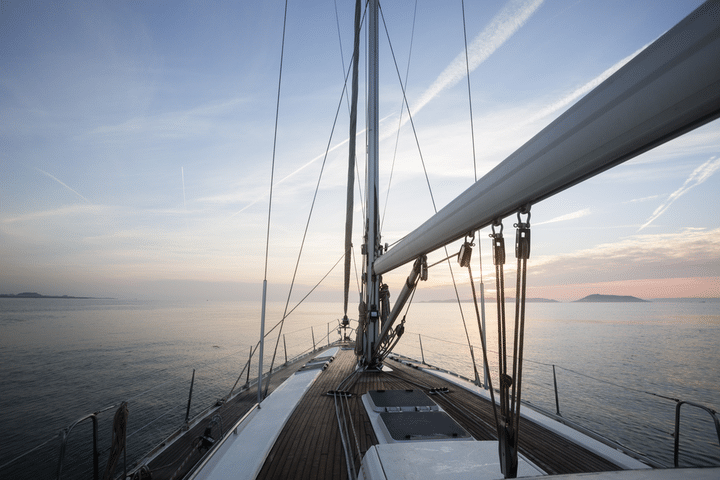
A boom is a spar (a pole made of wood or some other type of lightweight metal) along the bottom of a fore-and-aft rigged sail, which greatly improves the control of the angle and the shape of the sail, making it an indispensable tool for the navigation of the boat by controlling the sailes. The boom’s primary action is to keep the foot (bottom) of the sail flatter when the sail angle is away from the centerline of the sailboat.
The Kicking Strap (Boom Vang)
The boom vang is the line or piston system on a sailboat used to exert a downward force on the boom, enabling one to control the sail’s shape. The vang typically runs from the base of the mast to a point about a third of the way out the boom. It holds the boom down, enabling it to flatten the mainsail.
The Topping Lift
The topping lift is a line that is a part of the rigging on a sailboat, which applies an upward force on a spar (a pole) or a boom. Topping lifts are also used to hold a boom up when it’s sail is lowered. This line runs from the free end of the boom forward to the top of the mast. The line may run over a block at the top of the mast and down the deck to allow it to be adjusted.
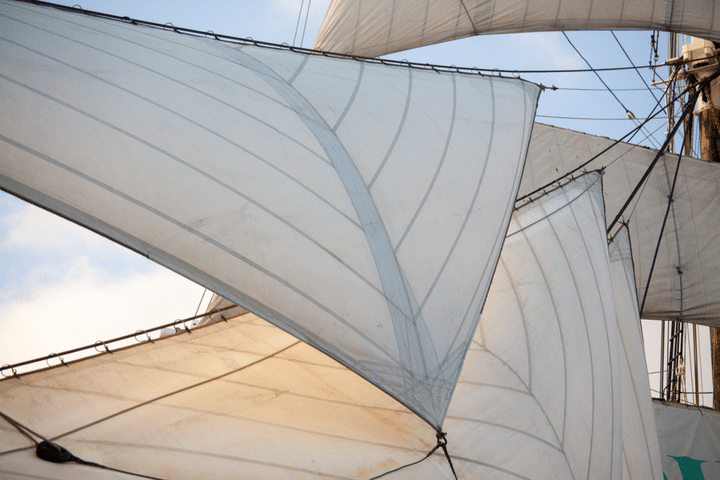
A jib is a triangular staysail set ahead of the foremost mast of a sailboat. Its tack is fixed to the bowsprit, the bow, or the deck between the bowsprit and the foremost mast. Jibs and spinnakers are the two main types of headsails on modern boats.
The Spinnaker
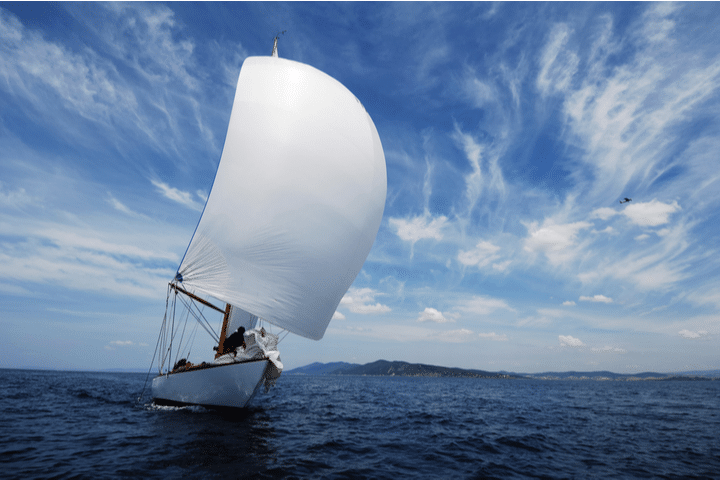
A spinnaker is a type of sail designed specifically for sailing off the wind from a reaching downwind course. The spinnaker fills up with wind and balloons out in front of the sailboat when it is deployed. This maneuver is called “flying.” The spinnaker is constructed of very lightweight material, such a nylon fabric and on many sailing vessels, it is very brightly colored.
Another name for the spinnaker is the “chute” because it often resembles a parachute, both in the material it is constructed from and its appearance when it is full of wind.
People often use the term genoa and jib as if they were the same thing, but there is a marked difference between these two types of sails. A job is no larger than a foretriangle, the triangular area formed by the mast, the deck or bowsprit, and the forestay. On the other hand, a genoa is larger than the jib, with part of the sail going past the mast and overlapping the mainsail. These two sails, however, serve very similar purposes.
The Backstay
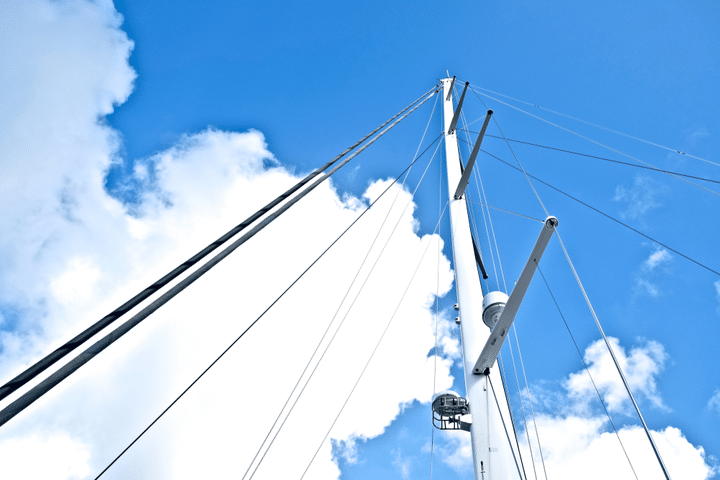
The backstay is a standing rigging that runs from the mast to the transom (the vertical section at the back of the boat), counteracting the forestay and the jib. The backstay is an important sail trip, control and directly affects the mainsail’s shape and the headsail.
There are two general categories of backstays:
1) A permanent backstay is attached to the top of the mast and may or may not be readily adjustable.
2) A running backstay is attached about two-thirds up the mast and sometimes at multiple locations along the mast. Most modern sailboats will have a permanent backstay, and some will have permanent backstays combined with a running backstay.
The Forestay
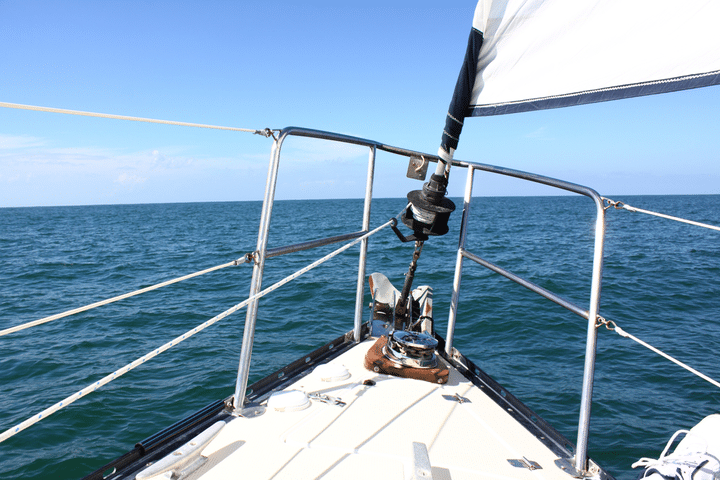
A forestay is a piece of standing rigging that keeps the mast from falling backward. It is attached at the very top of the mast, or at certain points near the top of the mast, with the other end of the forestay being attached to the bow (the front of the boat). Often a sail, such as a jib or a genoa, is attached to the forestay.
A forestay might be made from stainless steel wire, stainless steel rod or carbon rod, or galvanized wire or natural fibers.
Parts of a sail
Sails are vital for sailboats, made up of complex parts that improve performance and maneuverability. In this section, we’ll take a closer look at the different parts of that make up the sails.
Luff – The luff is a vertical sail part that maintains its shape and generates lift by interacting with the wind. It attaches securely with a bolt rope or luff tape for easy hoisting.
Leech – The leech controls air flow and reduces turbulence. Battens or leech lines are used to maintain shape and prevent fluttering.
Foot – The foot of a sail connects the luff and leech at the bottom edge. It helps define the sail’s shape and area. The outhaul is used to adjust its tension and shape.
Head – The sail’s head is where the luff and leech meet. It has a reinforced section for attaching the halyard to raise the sail.
Battens -The b attens are placed horizontally in sail pockets to maintain shape and optimize performance in varying wind conditions. They provide structural support from luff to leech.
Telltales – Sailors use telltales to adjust sail trim and ensure optimal performance.
Clew – The clew is important for shaping the sail and connecting the sheet, which regulates the angle and tension, producing energy. It’s located at the lower back corner of the sail.
Sailing is a favorite pastime for millions of Americans across the country. For some, there is nothing better than gliding across the water propelled by nothing more than the natural force of the wind alone. For both experienced and non-experienced sailors alike, Boatsetter is the perfect place to get your ideal sailboat rental from the mouthwatering Florida keys to the crystal blue waters of the Caribbean .
Smaller sailing boats are perfect for a single day out on the water, either by yourself or with friends and family. In comparison, larger sailing boats and sailing yachts can allow you days of luxury on longer excursions full of adventure and luxury.
Whatever your sailing dreams are, it is always good to know, for both the experienced sailor and the novice, all about the sailboat’s different parts. In this article, we learned all about the boat’s hull, the keel, the rudder, the mast, the mainsail, the boom, the kicking strap (boom vang), the topping lift, the jib, the spinnaker, the genoa, the backstay, and the forestay, which make up the basic parts of any sailboat you might find yourself on.
About us
Boatsetter is the go-to app for boat rentals and on-water experiences. Whatever the adventure, we’ve got a boat for that—Set sail , start the party , go yachting , make your trophy catch , and hone your watersports skills! Download the Boatsetter app ( App Store | Google Play ). Make sure to follow @boatsetter on Instagram, and tag us in all your boat day pictures for the chance to be featured.
Rent. List. Share—Only at Boatsetter

Boatsetter empowers people to explore with confidence by showing them a world of possibility on the water. Rent a boat, list your boat, or become a Boatsetter captain today.
Browse by experience

Explore articles
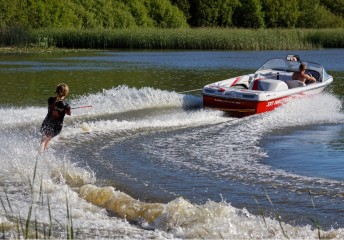
Water Skiing 101: For The Novice
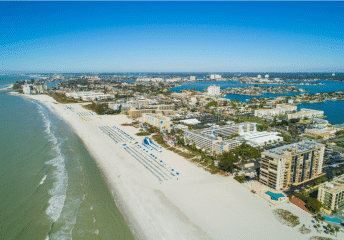
5 Best Beaches in St. Petersburg, FL to Explore By Boat

Dock 'n' Dine: Best Waterfront Restaurants in San Diego to Get to by Boat
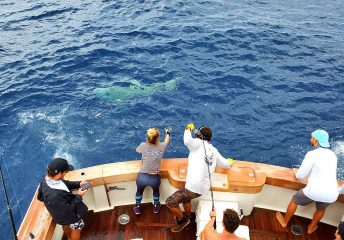
Fishing in Fort Lauderdale Guide
Last Updated on April 6, 2022 by Kim Koditek

Types of Sailboats: A Complete Guide

Last Updated by
Daniel Wade
June 15, 2022
Learning the different types of sailboats can help you identify vessels and choose the right boat.
In this article, we'll cover the most common kinds of sailboats, their origins, and what they're used for. We'll also go over the strengths and weaknesses of each design, along with when they're most useful.
The most common kind of sailboat is the sloop, as it's simple to operate and versatile. Other common sailboat types include the schooner, cutter, cat, ketch, schooner, catamaran, and trimaran. Other sailboat variations include pocket cruisers, motorsailers, displacement, and shoal-draft vessels.
The information found in this article is sourced from boat reference guides, including A Field Guide to Sailboats of North America by Richard M. Sherwood and trusted sources in the sailing community.
Table of contents
Distinguishing Types of Sailboats
In this article, we'll distinguish sailboats by traits such as their hull type, rig, and general configuration. Some sailboats share multiple characteristics with other boats but fall into a completely different category. For example, a sailboat with a Bermuda rig, a large engine, and a pilothouse could technically be called a sloop, but it's more likely a motorsailer.
When discerning sailboat type, the first most obvious place to look is the hull. If it has only one hull, you can immediately eliminate the trimaran and the catamaran. If it has two or more hulls, it's certainly not a typical monohull vessel.
The next trait to consider is the rig. You can tell a lot about a sailboat based on its rig, including what it's designed to be used for. For example, a long and slender sailboat with a tall triangular rig is likely designed for speed or racing, whereas a wide vessel with a complex gaff rig is probably built for offshore cruising.
Other factors that determine boat type include hull shape, overall length, cabin size, sail plan, and displacement. Hull material also plays a role, but every major type of sailboat has been built in both wood and fiberglass at some point.
Sailboat vs. Motorsailer
Most sailboats have motors, but most motorized sailboats are not motorsailers. A motorsailer is a specific kind of sailboat designed to run efficiently under sail and power, and sometimes both.
Most sailboats have an auxiliary engine, though these power plants are designed primarily for maneuvering. These vessels cannot achieve reasonable speed or fuel-efficiency. Motorsailers can operate like a powerboat.
Motorsailers provide great flexibility on short runs. They're great family boats, and they're popular in coastal communities with heavy boat traffic. However, these features come at a cost. Motorsailers aren't the fastest or most efficient powerboats, and they're also not the most agile sailboats. That said, they make an excellent general-purpose sailing craft.
Monohull vs. Multi-hull: Which is Better?
Multihull sailboats are increasingly popular, thanks to advances and lightweight materials, and sailboat design. But are they better than traditional sailboats? Monohulls are easier to maintain and less expensive, and they offer better interior layouts. Multihulls are more stable and comfortable, and they're significantly easier to control. Multihull sailboats also have a speed advantage.
Monohull Sailboats
A monohull sailboat is a traditionally-shaped vessel with a single hull. The vast majority of consumer sailboats are monohulls, as they're inexpensive to produce and easy to handle. Monohull sailboats are proven and easy to maintain, though they lack the initial stability and motion comfort of multi-hull vessels.
Monohull sailboats have a much greater rig variety than multi-hull sailboats. The vast majority of multihull sailboats have a single mast, whereas multi-masted vessels such as yawls and schooners are always monohulls. Some multi-hull sailboats have side-by-side masts, but these are the exception.
Catamaran Sailboats
The second most common sailboat configuration is the catamaran. A catamaran is a multihull sailboat that has two symmetrical hulls placed side-by-side and connected with a deck. This basic design has been used for hundreds of years, and it experienced a big resurgence in the fiberglass boat era.
Catamarans are fast, efficient, and comfortable. They don't heel very much, as this design has excellent initial stability. The primary drawback of the catamaran is below decks. The cabin of a catamaran is split between both hulls, which often leaves less space for the galley, head, and living areas.
Trimaran Sailboats
Trimarans are multi-hull sailboats similar to catamarans. Trimarans have three hulls arranged side-by-side. The profile of a trimaran is often indistinguishable from a catamaran.
Trimarans are increasingly popular, as they're faster than catamarans and monohulls and considerably easier to control. Trimarans suffer from the same spatial limitations as catamarans. The addition of an extra hull adds additional space, which is one reason why these multi-hull vessels are some of the best-selling sailboats on the market today.
Sailboat Rig Types
Rigging is another way to distinguish sailboat types. The rig of a sailboat refers to it's mast and sail configuration. Here are the most common types of sailboat rigs and what they're used for.
Sloops are the most common type of sailboat on the water today. A sloop is a simple single-mast rig that usually incorporates a tall triangular mainsail and headsail. The sloop rig is easy to control, fun to sail, and versatile. Sloops are common on racing sailboats as they can sail quite close to the wind. These maneuverable sailboats also have excellent windward performance.
The sloop rig is popular because it works well in almost any situation. That said, other more complex rigs offer finer control and superior performance for some hull types. Additionally, sloops spread their entire sail area over just to canvases, which is less flexible than multi-masted rigs. The sloop is ideal for general-purpose sailing, and it's proven itself inland and offshore.
Sloop Features:
- Most popular sailboat rig
- Single mast
- One mainsail and headsail
- Typically Bermuda-rigged
- Easy to handle
- Great windward performance
- Less precise control
- Easier to capsize
- Requires a tall mast
Suitable Uses:
- Offshore cruising
- Coastal cruising
Cat (Catboat)
The cat (or catboat) is a single-masted sailboat with a large, single mainsail. Catboats have a thick forward mast, no headsail, and an exceptionally long boom. These vessels are typically gaff-rigged, as this four-edged rig offers greater sail area with a shorter mast. Catboats were popular workboats in New England around the turn of the century, and they have a large following today.
Catboats are typically short and wide, which provides excellent stability in rough coastal conditions. They're hardy and seaworthy vessels, but they're slow and not ideal for offshore use. Catboats are simple and easy to control, as they only have a single gaff sail. Catboats are easy to spot thanks to their forward-mounted mast and enormous mainsail.
Catboat Features:
- Far forward-mounted single mast
- Large four-sided gaff sail
- Short and wide with a large cockpit
- Usually between 20 and 30 feet in length
- Excellent workboats
- Tough and useful design
- Great for fishing
- Large cockpit and cabin
- Not ideal for offshore sailing
- Single sail offers less precise control
- Slow compared to other rigs
- Inland cruising
At first glance, a cutter is difficult to distinguish from a sloop. Both vessels have a single mast located in roughly the same position, but the sail plan is dramatically different. The cutter uses two headsails and often incorporates a large spar that extends from the bow (called a bowsprit).
The additional headsail is called a staysail. A sloop only carries one headsail, which is typically a jib. Cutter headsails have a lower center of gravity which provides superior performance in rough weather. It's more difficult to capsize a cutter, and they offer more precise control than a sloop. Cutters have more complex rigging, which is a disadvantage for some people.
Cutter Features:
- Two headsails
- Long bowsprit
- Similar to sloop
- Gaff or Bermuda-rigged
- Fast and efficient
- Offers precise control
- Superior rough-weather performance
- More complex than the sloop rig
- Harder to handle than simpler rigs
Perhaps the most majestic type of sailboat rig, the schooner is a multi-masted vessel with plenty of history and rugged seaworthiness. The schooner is typically gaff-rigged with short masts and multiple sails. Schooners are fast and powerful vessels with a complex rig. These sailboats have excellent offshore handling characteristics.
Schooners have a minimum of two masts, but some have three or more. The aftermost large sail is the mainsail, and the nearly identical forward sail is called the foresail. Schooners can have one or more headsail, which includes a cutter-style staysail. Some schooners have an additional smaller sale aft of the mainsail called the mizzen.
Schooner Features:
- At least two masts
- Usually gaff-rigged
- One or more headsails
- Excellent offshore handling
- Precise control
- Numerous sail options (headsails, topsails, mizzen)
- Fast and powerful
- Complex and labor-intensive rig
- Difficult to adjust rig single-handed
- Offshore fishing
Picture a ketch as a sloop or a cutter with an extra mast behind the mainsail. These vessels are seaworthy, powerful, excellent for offshore cruising. A ketch is similar to a yawl, except its larger mizzen doesn't hang off the stern. The ketch is either gaff or Bermuda-rigged.
Ketch-rigged sailboats have smaller sails, and thus, shorter masts. This makes them more durable and controllable in rough weather. The mizzen can help the boat steer itself, which is advantageous on offshore voyages. A ketch is likely slower than a sloop or a cutter, which means you aren't likely to find one winning a race.
Ketch Features:
- Headsail (or headsails), mainsail, and mizzen
- Mizzen doesn't extend past the rudder post
- Good offshore handling
- Controllable and mild
- Shorter and stronger masts
- Easy self-steering
- Slower than sloops and cutters
- Less common on the used market
A dinghy is a general term for a small sailboat of fewer than 28 feet overall. Dinghys are often dual-power boats, which means they usually have oars or a small outboard in addition to a sail. These small boats are open-top and only suitable for cruising in protected waters. Many larger sailboats have a deployable dinghy on board to get to shore when at anchor.
Dinghy Features:
- One or two people maximum capacity
- Easy to sail
- Works with oars, sails, or an outboard
- Great auxiliary boat
- Small and exposed
- Not suitable for offshore use
- Going from anchor to shore
- Protected recreational sailing (lakes, rivers, and harbors)
Best Sailboat Type for Stability
Stability is a factor that varies widely between sailboat types. There are different types of stability, and some sailors prefer one over another. For initial stability, the trimaran wins with little contest. This is because these vessels have a very high beam-to-length ratio, which makes them much less prone to rolling. Next up is the catamaran, which enjoys the same benefit from a wide beam but lacks the additional support of a center hull section.
It's clear that in most conditions, multihull vessels have the greatest stability. But what about in rough weather? And what about capsizing? Multihull sailboats are impossible to right after a knockdown. This is where full-keel monohull sailboats excel.
Traditional vessels with deep displacement keels are the safest and most stable in rough weather. The shape, depth, and weight of their keels keep them from knocking over and rolling excessively. In many cases, these sailboats will suffer a dismasting long before a knockdown. The primary disadvantage of deep-keeled sailboats is their tendency to heel excessively. This characteristic isn't hazardous, though it can make novice sailors nervous and reduce cabin comfort while underway.
Best Sailboat Type for Offshore Cruising
The best sailboat type for offshore cruising is the schooner. These graceful aid robust vessels have proven themselves over centuries as durable and capable vessels. They typically use deep displacement keels, which makes them stable in rough weather and easy to keep on course.
That said, the full answer isn't quite so simple. Modern multihull designs are an attractive option, and they have also proven to be strong and safe designs. Multihull sailboats are an increasingly popular option for offshore sailors, and they offer comfort that was previously unknown in the sailing community.
Many sailors cross oceans in basic Bermuda-rigged monohulls and take full advantage of a fin-keel design speed. At the end of the day, the best offshore cruising sailboat is whatever you are comfortable handling and living aboard. There are physical limits to all sailboat designs, though almost any vessel can make it across an ocean if piloted by a competent skipper and crew.
Best Sailboat Type for Racing The modern lightweight Bermuda-rigged sailboat is the king of the regatta. When designed with the right kind of hull, these vessels are some of the fastest sailboats ever developed. Many boats constructed between the 1970s and today incorporate these design features due to their favorable coastal and inland handling characteristics. Even small sailboats, such as the Cal 20 and the Catalina 22, benefit from this design. These boats are renowned for their speed and handling characteristics.
Related Articles
I've personally had thousands of questions about sailing and sailboats over the years. As I learn and experience sailing, and the community, I share the answers that work and make sense to me, here on Life of Sailing.
by this author
Learn About Sailboats
Most Recent

What Does "Sailing By The Lee" Mean?
October 3, 2023

The Best Sailing Schools And Programs: Reviews & Ratings
September 26, 2023
Important Legal Info
Lifeofsailing.com is a participant in the Amazon Services LLC Associates Program, an affiliate advertising program designed to provide a means for sites to earn advertising fees by advertising and linking to Amazon. This site also participates in other affiliate programs and is compensated for referring traffic and business to these companies.
Similar Posts

Affordable Sailboats You Can Build at Home
September 13, 2023

Best Small Sailboat Ornaments
September 12, 2023


Discover the Magic of Hydrofoil Sailboats
December 11, 2023
Popular Posts

Best Liveaboard Catamaran Sailboats
December 28, 2023

Can a Novice Sail Around the World?
Elizabeth O'Malley

4 Best Electric Outboard Motors

How Long Did It Take The Vikings To Sail To England?

10 Best Sailboat Brands (And Why)
December 20, 2023

7 Best Places To Liveaboard A Sailboat
Get the best sailing content.
Top Rated Posts
Lifeofsailing.com is a participant in the Amazon Services LLC Associates Program, an affiliate advertising program designed to provide a means for sites to earn advertising fees by advertising and linking to Amazon. This site also participates in other affiliate programs and is compensated for referring traffic and business to these companies. (866) 342-SAIL
© 2024 Life of Sailing Email: [email protected] Address: 11816 Inwood Rd #3024 Dallas, TX 75244 Disclaimer Privacy Policy

- Find A School
- Certifications
- North U Sail Trim
- Inside Sailing with Peter Isler
- Docking Made Easy
- Study Quizzes
- Bite-sized Lessons
- Fun Quizzes
- Sailing Challenge

The Anatomy of a Boat
By: Zeke Quezada, ASA Equipment , Learn To Sail , Sailboats
Do You Know the Parts of a Boat
Learning to sail is not just about feeling the wind in your sails. You also become familiar with the vessel that will be part of your new lifelong adventure. A sailboat can seem daunting with all its moving parts, but it is quite simple.
I recently learned the term Keel Hauling, and I was a bit shocked at not knowing the reference. When you sail, you take on an entirely new language of words, sayings, and jargon. A few of us sailors even embrace the same Jimmy Buffet songs as part of our perennial sailing playlist. (that is another story for a different time)
My wife, who has sailed for over 20 years, is competent under most conditions at sail and knows her way around our vessel, but I was surprised that she didn’t know some of the simple terms that we sailors use daily. There are some fundamental terms that all sailors learn as they begin their sailing career and the rest of the information follows along as you spend more time on the water.
When you embark on a sailing education in ASA 101 Basic Keelboat Sailing, you learn about the anatomy of a boat. These are part of the fundamentals of sailing. While these few terms are interchangeable among boats, they certainly are not the only terms you’ll learn, but they are the beginning of a new language when you become an ASA certified sailor.

This is a keelboat. It is different from a dinghy in that it is larger than 20 feet and has a keel. Keelboats start at around 20 feet with no upper limit in length. A 200-foot megayacht is considered a keelboat.
Sailboat Terminology

Dinghy – A small sailboat usually under 20 feet long and open for most of its length.

Keel – A fixed appendage on the bottom of the hull that provides sideways resistance needed to counter the force of the wind on the sails. The keel also carries ballast , usually iron or lead, the weight of which counteracts the force of the wind that causes a sailboat to heel , or lean over.
Hull – The watertight structural shell of a boat.
Bow – The forward part of a boat
Stern – The aft part of the boat.
Transom – The more or less flat surface that closes the hull at the stern
Rudder – The sailboat is steered by a fin-shaped appendage attached beneath the boat toward the stern which can be rotated to change the angle at which the water strikes it. Water must flow past the rudder in order fo rit to work so it will not turn the boat while at rest.
The rudder is controlled by a wheel or a tiller at the helm of the boat. The person steering the boat is the helmsman .
Cockpit – The area of the boat, usually recessed into the deck , from which the boat is steered and sailed.
Deck – The generally horizontal surface that encloses the top of the hull.
Companionway – The entrance from the cockpit or deck to the cabin.
Stanchion – A metal post that supports lifelines .
Lifeline – A wire supported on stanchions around the perimeter of the deck to prevent crew from falling overboard.
Pulpit – A guardrail at the bow or stern of a boat to which (usually) the lifelines are connected.
Learning to Sail
- ASA 101: What You’ll Learn ASA 101 is your introduction to Basic Keelboat Sailboat and is your key to a lifetime of sailing.
- How To Sail Sailing a boat is part art and part skill but few activities offer such a variety of pleasures as sailing. Something special occurs when you cast off the lines and leave your cares at the dock.
- 7 Tips For The Beginning Sailor There are the obvious things you need when you go sailing, sunscreen, a hat, a windbreaker, non-skid shoes, and wind. However, what do you really need to be ready to head out on the water?
- How To Learn To Sail You won’t have to buy a boat or learn a new language or buy a new wardrobe to get a taste for sailing. You can dictate how much you want to experience.
- Learning To Sail Is Just The Beginning Sailing means different things to different people. At ASA we understand that learning to sail is just the beginning of a relationship with a lifestyle that is infectious. Where will sailing take you? We have a few ideas but how you view sailing is the most important.
- What Is Your Role on a Boat? What type of sailor are you and what role do you take on the boat? Your ASA sailing education will prepare you to be a skipper on a sailing vessel and with that comes the responsibility of keeping your crew safe and ensuring the safety of the vessel you are sailing.
Related Posts:

- Learn To Sail
- Mobile Apps
- Online Courses
- Upcoming Courses
- Sailor Resources
- ASA Log Book
- Bite Sized Lessons
- Knots Made Easy
- Catamaran Challenge
- Sailing Vacations
- Sailing Cruises
- Charter Resources
- International Proficiency Certificate
- Find A Charter
- All Articles
- Sailing Tips
- Sailing Terms
- Destinations
- Environmental
- Initiatives
- Instructor Resources
- Become An Instructor
- Become An ASA School
- Member / Instructor Login
- Affiliate Login
17 Sailboat Types Explained: How To Recognize Them
Ever wondered what type of sailboat you're looking at? Identifying sailboats isn't hard, you just have to know what to look for. In this article, I'll help you.
Every time I'm around a large number of sailboats, I look around in awe (especially with the bigger ones). I recognize some, but with most of them, I'll have to ask the owner. When they answer, I try to hide my ignorance. The words don't make any sense!
So here's a complete list with pictures of the most common sailboat types today. For each of them, I'll explain exactly where the name comes from, and how you can recognize it easily.

So here's my list of popular sailboat types, explained:
Bermuda sloop, sailing hydrofoil, dutch barge, chinese junk, square-rigged tall ship, in conclusion, how to recognize any sailboat.
Before we get started, I wanted to quickly explain what you should look for when you try to identify a sailboat.
The type of sailboat is always determined by one of these four things:
- The type of hull
- The type of keel
- The number of masts
- And the type of sails and rig
The hull is the boat's body. There are basically three hull types: monohull, catamaran, and trimaran. Simply said: do I see one hull, two hulls (catamaran) or three hulls (trimaran)? Most sailboats are monohulls.
Next, there is the keel type. The keel is the underwater part of the hull. Mostly, you won't be able to see that, because it's underwater. So we'll leave that for now.
The sail plan
The last factor is the number of masts and the sail plan. The sail plan, simply put, is the number of sails, the type of sails, and how the sails are mounted to the masts (also called rigging ).
Sailboat are mostly named after the sail plan, but occasionally, a sail type is thrown in there as well.
So now we know what to pay attention to, let's go and check out some sailboats!

Dinghies are the smallest and most simple sailboats around.
They are your typical training sailboats. Small boats with an open hull, with just one mast and one sail. Perfect for learning the ways of the wind.
On average, they are between 6 and 20 ft long. Mostly sailed single-handed (solo). There's no special rigging, just the mainsail. The mainsail is commonly a Bermuda (triangular) mainsail. Dinghies have a simple rudder stick and no special equipment or rigging.
Dinghies are great for learning how to sail. The smaller the boat, the better you feel the impact of your trim and actions.
How to recognize a sailing dinghy:
- short (8ft)
- one Bermuda sail
- open hull design
- rudder stick
Common places to spot them: lakes, near docks

If you'd ask a kid to draw a sailboat, she'll most probably draw this one. The Bermuda Sloop is the most popular and most common sailboat type today. You'll definitely recognize this one.
How to recognize a Bermuda Sloop:
- triangular mainsail (called a Bermuda sail)
- a foresail (also called the jib)
- fore-and-aft rigged
- medium-sized (12 - 50 ft)
Fore-and-aft rigged just means "from front to back". This type of rigging helps to sail upwind.
Any sailboat with one mast and two sails could still be a sloop. Even if the sails are another shape or rigged in another way. For example, here's a gaff-rigged sloop (more on the gaff rig later):

If you want to learn all about sail rigs, check out my full Guide to Understanding Sail Rig Types here. It has good infographics and explains it in more detail
The Bermuda sloop has a lot of advantages over other sailboat types (which is why it's so popular):
- the Bermuda rig is very maneuverable and pretty fast in almost all conditions
- it's really versatile
- you can sail it by yourself without any problems
- it's a simple setup
Common places to spot a sloop: everywhere. Smaller sloops are more common for inland waters, rivers, and lakes. Medium-sized and large sloops are very popular cruising boats.

Cutters have one mast but three or more sails. Most cutters are Bermuda rigged, which means they look a lot like sloops.
How to recognize a cutter:
- looks like a sloop
- two or more headsails instead of one
- commonly one mast
- sometimes an extra mast with mainsail
Cutters have more sail area, which makes them faster, but also harder to sail single-handed. There's also more strain on the mast and rigging.
Common places to spot a cutter: everywhere. Cutters are very popular for cruising.
They mostly have a Bermuda rig, which means triangular sails. But there are also gaff cutters and naval cutters, and some have two masts.
Here's an example of a two-masted naval cutter with an extra gaff mainsail and top gaff:

The Hydrofoil is a pretty new sailboat design. It's a racing sailboat with thin wing foils under the hull. These lift up the hull, out of the water, reducing the displacement to nearly zero. The foils create downforce and keep it from lifting off entirely.
This makes the hydrofoil extremely fast and also impressive.
The hydrofoil refers to the keel type. There are both monohull and multihull hydrofoils.
How to recognize a hydrofoil:
- it flies above the waterline and has small fins
Common places to spot a hydrofoil: at racing events

Famous catamaran: La Vagabonde from Sailing La Vagabonde
A catamaran is a type of cruising and racing multihull sailboat with two hulls. The hulls are always the same size.
Most catamarans have a standard Bermuda rig. The catamaran refers to the hull, so it can have any number of masts, sails, sail types and rig type.
How to recognize a catamaran:
- any boat with two hulls is called a catamaran
Common places to spot catamarans: coastal waters, The Caribbean, shallow reefs
The advantages of a catamaran: Catamarans heel less than monohulls and are more buoyant. Because of the double hull, they don't need as deep a keel to be stable. They have a smaller displacement, making them faster. They also have a very shallow draft. That's why catamarans are so popular in the Caribbean, where there's lots of shallow water.
Catamarans are nearly impossible to capsize:
"Compared with a monohull, a cruising catamaran sailboat has a high initial resistance to heeling and capsize—a fifty-footer requires four times the force to initiate a capsize than an equivalent monohull." Source: Wikipedia

How to recognize a trimaran:
- any boat with three hulls is called a trimaran
Trimarans have three hulls, so it's a multi-hull design. It's mostly a regular monohull with two smaller hulls or floaters on the sides. Some trimarans can be trailered by winching in the auxiliary hulls, like this:

This makes them very suitable for long-term cruising, but also for regular docking. This is great for crowded areas and small berths, like in the Mediterranean. It sure is more cost-effective than the catamaran (but you also don't have the extra storage and living space!).
Common places to spot Trimarans: mostly popular for long-term cruising, you'll find the trimaran in coastal areas.

Gaffer refers to gaff-rigged, which is the way the sails are rigged. A gaff rig is a rectangular sail with a top pole, or 'spar', which attaches it to the mast. This pole is called the 'gaff'. To hoist the mainsail, you hoist this top spar with a separate halyard. Most gaffers carry additional gaff topsails as well.
Gaff rigs are a bit less versatile than sloops. Because of the gaff, they can have a larger sail area. So they will perform better with downwind points of sail. Upwind, however, they handle less well.
How to recognize a gaffer:
- sail is rectangular
- mainsail has a top pole (or spar)
Since a gaffer refers to the rig type, and not the mast configuration or keel type, all sailboats with this kind of rigging can be called 'gaffers'.
Common places to spot a gaffer: Gaffers are popular inland sailboats. It's a more traditional rig, being used recreationally.

Schooners used to be extremely popular before sloops took over. Schooners are easy to sail but slower than sloops. They handle better than sloops in all comfortable (cruising) points of sail, except for upwind.
How to recognize a schooner:
- mostly two masts
- smaller mast in front
- taller mast in the back
- fore-and-aft rigged sails
- gaff-rigged mainsails (spar on top of the sail)
Common places to spot a schooner: coastal marinas, bays

How to recognize a ketch:
- medium-sized (30 ft and up)
- smaller mast in back
- taller mast in front
- both masts have a mainsail
The ketch refers to the sail plan (mast configuration and type of rig). Ketches actually handle really well. The back mast (mizzenmast) powers the hull, giving the skipper more control. Because of the extra mainsail, the ketch has shorter masts. This means less stress on masts and rigging, and less heel.
Common places to spot a ketch: larger marinas, coastal regions

How to recognize a yawl:
- main mast in front
- much smaller mast in the back
- back mast doesn't carry a mainsail
The aft mast is called a mizzenmast. Most ketches are gaff-rigged, so they have a spar at the top of the sail. They sometimes carry gaff topsails. They are harder to sail than sloops.
The yawl refers to the sail plan (mast configuration and type of rig).
Common places to spot a yawl: they are not as popular as sloops, and most yawls are vintage sailboat models. You'll find most being used as daysailers on lakes and in bays.

Dutch Barges are very traditional cargo ships for inland waters. My hometown is literally littered with a very well-known type of barge, the Skutsje. This is a Frisian design with leeboards.
Skutsjes don't have a keel but use leeboards for stability instead, which are the 'swords' or boards on the side of the hull.
How to recognize a Dutch Barge:
- most barges have one or two masts
- large, wooden masts
- leeboards (wooden wings on the side of the hull)
- mostly gaff-rigged sails (pole on top of the sail, attached to mast)
- a ducktail transom

The clipper is one of the latest sailboat designs before steam-powered vessels took over. The cutter has a large cargo area for transporting cargo. But they also needed to be fast to compete with steam vessels. It's a large, yet surprisingly fast sailboat model, and is known for its good handling.
This made them good for trade, especially transporting valuable goods like tea or spices.
How to recognize a Clipper:
- mostly three masts
- square-rigged sails
- narrow but long, steel hull
Common places to spot a clipper: inland waters, used as houseboats, but coastal waters as well. There are a lot of clippers on the Frisian Lakes and Waddenzee in The Netherlands (where I live).

This particular junk is Satu, from the Chesapeake Bay Area.
The Chinese Junk is an ancient type of sailboat. Junks were used to sail to Indonesia and India from the start of the Middle Ages onward (500 AD). The word junk supposedly comes from the Chinese word 'jung', meaning 'floating house'.
How to recognize a Chinese junk:
- medium-sized (30 - 50 ft)
- large, flat sails with full-length battens
- stern (back of the hull) opens up in a high deck
- mostly two masts (sometimes one)
- with two mainsails, sails are traditionally maroon
- lug-rigged sails
The junk has a large sail area. The full-length battens make sure the sails stay flat. It's one of the flattest sails around, which makes it good for downwind courses. This also comes at a cost: the junk doesn't sail as well upwind.

The cat rig is a sail plan with most commonly just one mast and one sail, the mainsail.
Most sailing dinghies are cats, but there are also larger boats with this type of sail plan. The picture above is a great example.
How to recognize a cat rig:
- smaller boats
- mostly one mast
- one sail per mast
- no standing rigging
Cat-rigged refers to the rigging, not the mast configuration or sail type. So you can have cats with a Bermuda sail (called a Bermuda Cat) or gaff-rigged sail (called a Gaff Cat), and so on. There are also Cat Ketches and Cat Schooners, for example. These have two masts.
The important thing to know is: cats have one sail per mast and no standing rigging .
Most typical place to spot Cats: lakes and inland waters

Famous brig: HMS Beagle (Charles Darwin's ship)
A brig was a very popular type of small warship of the U.S. navy during the 19th century. They were used in the American Revolution and other wars with the United Kingdom. They carry 10-18 guns and are relatively fast and maneuverable. They required less crew than a square-rigged ship.
How to recognize a brig:
- square-rigged foremast
- mainmast square-rigged or square-rigged and gaff-rigged

How to recognize a tall ship:
- three or four masts
- square sails with a pole across the top
- multiple square sails on each mast
- a lot of lines and rigging
Square-rigged ships, or tall ships, are what we think of when we think of pirate ships. Now, most pirate ships weren't actually tall ships, but they come from around the same period. They used to be built from wood, but more modern tall ships are nearly always steel.
Tall ships have three or four masts and square sails which are square-rigged. That means they are attached to the masts with yards.
We have the tall ship races every four years, where dozens of tall ships meet and race just offshore.
Most common place to spot Tall Ships: Museums, special events, open ocean

This is a bonus type since it is not very common anymore. As far as I know, there's only one left.
The Trabaccolo is a small cargo ship used in the Adriatic Sea. It has lug sails. A lug rig is a rectangular sail, but on a long pole or yard that runs fore-and-aft. It was a popular Venetian sailboat used for trade.
The name comes from the Italian word trabacca , which means tent, referring to the sails.
How to recognize a Trabaccolo:
- wide and short hull
- sails look like a tent
Most common place to spot Trabaccolo's: the Marine Museum of Cesenatico has a fully restored Trabaccolo.
So, there you have it. Now you know what to look for, and how to recognize the most common sailboat types easily. Next time you encounter a magnificent sailboat, you'll know what it's called - or where to find out quickly.

I loved this article. I had no idea there were so many kinds of sailboats.
i have a large sailing boat about 28ft. that im having a difficult time identifying. it was my fathers & unfortunately hes passed away now. any helpful information would be appreciated.
Jorge Eusali Castro Archbold
I find a saleboat boat but i can find the módem…os registré out off bru’x, and the saleboat name is TADCOZ, can you tell me who to go about this matter in getting info.thank con voz your time…
Leave a comment
You may also like, guide to understanding sail rig types (with pictures).
There are a lot of different sail rig types and it can be difficult to remember what's what. So I've come up with a system. Let me explain it in this article.

The Ultimate Guide to Sail Types and Rigs (with Pictures)

How Much Sailboats Cost On Average (380+ Prices Compared)
Own your first boat within a year on any budget.
A sailboat doesn't have to be expensive if you know what you're doing. If you want to learn how to make your sailing dream reality within a year, leave your email and I'll send you free updates . I don't like spam - I will only send helpful content.
Ready to Own Your First Boat?
Just tell us the best email address to send your tips to:
No products in the cart.
Sailing Ellidah is supported by our readers. Buying through our links may earn us an affiliate commission at no extra cost to you.
The Different Parts Of A Sailboat Explained
A sailboat consists of hundreds of parts, each with its specific term and function. From stern to bow, keel to mast, each part and its equipment plays a vital role in making the vessel seaworthy and able to sail.
In this guide, I’ll show you most of the components so you can better understand what they are and their function. We’ll begin with the main components, move to the basic features, and finish with our interior and equipment.
The main parts of a sailboat
The main parts of a sailboat are the key components that make it a vessel able to sail. You’ll notice that the structure has several distinct differences from powerboats.
We can categorize the main parts into the following:
- Hull: The main structure, or “body” part of a boat.
- Keel: The heavy fin at the bottom allows stability under sail.
- Rudder: The fin sticking down at the stern, allowing us to steer the vessel.
- Mast: The “spars” or “poles” holding the sails.
- Rigging: The standing rig is the wires that supports the mast. The running rigging is all the lines that control the sails.
- Boom: The horizontal spar supporting the bottom of the mainsail.
- Sails: The canvas used to harness the energy of the wind.
Let’s dig a bit deeper into each of the components.
Hull – The main structure
A sailboat’s hull is the vessel’s main body or structure. The shape is vital to the boat’s performance and stability, and you have probably seen boats in many different forms. Older vessels are typically narrow, with a rounded underbody and a small stern. Modern designs have a flatter belly and broad stern supporting dual helm stations.
One of the hull’s primary functions is to displace water and provide buoyancy to keep the boat afloat. The hull is also the structure that holds the vessel’s living compartments and all its equipment. The main structure must be strong enough to withstand the forces of the water and any rough weather conditions that Mother Nature might throw at it.
Fiberglass (GRP), steel, aluminum, and wood are the most commonly used hull materials, each with pros and cons.
You can learn more about hull materials and their strengths in this article .
A monohull is a type of sailboat that has a single hull. Monohulls are classified into two categories based on weight and shape: planing and displacement hulls.
Sailboats with more than one hull are called multihulls. There are two types of multihulls: catamarans, which have two, and trimarans, which have three. These boats are typically designed with planing hulls.
Keel – The fin under the boat
The keel of a sailboat is a structural fin that extends downward from the bottom of the hull. There are several types of keels, each with unique characteristics and advantages. They all serve the same fundamental purpose of stabilizing the boat when we sail by adding lateral resistance in the water and weight at the vessel’s bottom.
Standard keel designs include:
- Lifting Keel
Some sailboats have a retractable centerboard functioning as their keel, allowing them to take the boat into shallower areas.
Rudder – To steer the boat
The rudder is a flat surface that sits perpendicular to the waterline. It is connected to the boat by a pivot point, allowing it to swivel left and right. When the steering wheel or tiller is turned, the rudder moves, creating drag in the water causing the boat to turn. The size and shape of the rudder can vary depending on the size and type of boat.
The most commonly seen rudder designs:
- Full skeg-supported
- Semi skeg-supported
Skeg-supported rudders are structurally one of the most reliable and robust constructions, but they are less efficient than a balanced rudder performance-wise. Balanced rudders pivot around their vertical center, giving less drag in the water and higher maneuverability at the cost of being a more vulnerable construction.
Twin rudders are often seen on modern performance sailboats with a wide stern. When the sailboat heel over , the leeward rudder gets better track through the water than a single rudder placed at the vessel’s center line. Contrary to some misconceptions, they can’t be controlled individually, even if the boat has two steering wheels.
Mast and Rigging – Supporting the sails
The mast is the long vertical spar that extends upward from the deck of a sailboat and holds the sails. It is the tallest part of the boat and is typically made of wood, aluminum, or carbon fiber. The mast is held in place by stays and shrouds, which form the sailboat’s standing rigging.
Depending on the rig the boat is manufactured with, there are several different types of masts. For example, a sloop-rigged sailboat will have only one main mast, while a ketch-rigged vessel will have a smaller additional mizzen mast placed further aft from the main mast.
There are two types of rigging:
- The Standing rigging consists of the stays and shrouds that keep the mast or masts in place.
- The Running rigging is the lines we use to hoist, lower, and control the sails.
Pro Tip: “S par” is a general term for a pole made of a solid material like wood, metal, or composite and is used to support a boat’s sail. The mast, boom, spreaders, and poles are defined as spars.
Boom – Supporting the mainsail
The boom is a horizontal beam extending from the mast and supporting the mainsail’s tack and clew (bottom two corners). It is attached to the mast by a hinge called a Gooseneck .
We use the boom to control the shape and angle of the mainsail to optimize its efficiency and power. Some booms also have a Vang or Rod-Kicker installed to assist in trimming the mainsail.
Sails – The canvas used to harness the energy of the wind
Most vessels have at least two sails, depending on the rig type and boat setup.
The Mainsail flies behind the mast, on top of the boom. Although it may not always be the largest sail on the vessel, we commonly refer to it as “the main.”
The Headsail(s ), located in front of the mast, are often of different sizes and shapes, and many sailboats have more than one. The Jib and Genoa are two of the most common types.
Different types of sails are used for various sail plans and situations, and you can learn more about them in this guide .
Now that we had a look at the main parts of the boat, let us dive deeper and look at the rest of the vessel.
The starboard and port side of the boat
Learning about the boat’s components is very important, but we must also know how to orient ourselves on the vessel. Using the words “left and right” on onboard often leads to confusion.
If you refer to something on the left side of the boat, the person facing you will be confused. He won’t know if you are referring to his or your left. This is where the terms “Port” and “ Starboard ” make better sense.
When facing the front of the boat or the bow , your left side of the boat is the port side, and the right-hand side is the starboard . If you turn around and face the back of the boat or the stern , your right-hand side will be the port side.
- A red light identifies the port side of a vessel.
- A green light identifies the starboard side of a vessel.
Windward and Leeward
- The windward side of the boat is the side facing the wind. If the wind comes from your right-hand side while facing forward, the starboard side is windward. This will be the boat’s high side as the wind heels the boat over.
- The leeward side of the boat is the side opposite to the wind. This will be the lower side of the ship while sailing as the wind heels the boat over.
Windward and leeward are two of the most important aspects to understand when sailing and navigating. Not only to identify equipment and gear on each side of the boat but to avoid collisions when sailing close to other vessels. There are rules on the water dictating which boat is “Stand On” and which has to “Give Way” depending on whether you are the windward or the leeward vessel in the situation.
Read this article to access a free course on navigation rules .
Basic parts of a sailboat
The boat’s bow is the front part, typically shaped like a “V” to cut through the waves. Larger vessels often have a locker for their anchor chain in this section, holding the anchor at the front.
The midship section is the center of the boat. Some refer to this part as amidships.
The stern is the rear or back part of the boat. It is also referred to as the aft . I’ve had French crew calling the stern the butt of the vessel, which is funny but also correct!
The beam is the widest part of the boat. Also referred to as the sides on the middle.
The transom is a flat surface across the stern of the boat.
The waterline is the part where the hull (body) of the boat meets the water. Many vessels have a painted stripe to mark the waterline, indicating how loaded the ship is. If you have too much stuff on board, the waterline goes underwater, and it is time to do some housekeeping!
The freeboard is the vertical part of the ship side between the water and the deck. When you see a blue boat like Ellidah, the freeboard is the blue part.
The deck is the “floor” of the boat when you are outside. You have probably heard the term “All hands on deck!” The front deck is the deck space in front of the mast. Side decks are the decks on the boat’s sides.
The mid-deck is between the cockpit and the mast. The aft deck is the deck behind the cockpit. Sailboats with aft cockpits often don’t have any aft decks, but some have a swimming platform instead.
The cockpit is the boat’s steering position and where you will find the helm.
The helm is the position the helmsman uses to steer the boat. Smaller sailboats often use a tiller to navigate, while most bigger yachts have one or two steering wheels.
Main parts below deck (inside the boat)
Let us look at the interior to highlight and learn about the parts we have below the deck.
The Companionway
The companionway is the “front door” of the boat. This is where the steps lead from the cockpit or deck down below. It is usually opened and closed using a hatch, two doors, or a plate.
The Galley
The galley is the boat’s kitchen. This is where sailors prepare their delicious meals.
The Saloon
The saloon is basically the boat’s living room, usually where you find the settee and dinette. This is where delicious meals from the galley are served together with refreshing beverages in good company.
The settee is the sofa or couch in a boat. It is also used as a sea berth to sleep in when sailing.
The dinette is the area where you can sit down at a table and eat your dinner. It’s also perfect for consuming rum and a game of cards in good company.
A cabin is often used as a bedroom in a boat but is not necessarily where you sleep. Many boats have more than one cabin.
A berth is a place in the boat where you can sleep. This doesn’t necessarily have to be a bed and can often include the sleeping space in the saloon. Sea-berth usually refers to a sleeping position where you are tucked well in and can sleep when the boat is heeling over and moving around.
The head is the toilet on a boat. If your skipper tells you to go and clean the head, getting out the shampoo won’t do you any good!
Nav station
The navigation station is usually a chart table and a console with mysterious instruments like radios, switchboards, and complicated electronics. This is where adventures are planned and the skipper’s favorite seat onboard.
The bilge is a space in the bottom of the hull where water collects and sometimes a storage space for all sorts of things. It usually contains a bilge pump to pump out water that finds its way into the boat in various places.
A v-berth is a bed in the front cabin shaped like a V.
A bulkhead is a wall inside the boat, usually supporting the structure.
Hardware and Equipment
Sailboats come equipped with a variety of different hardware and equipment. While the specific items may vary from boat to boat, there are some essentials that nearly every sailboat has.
A winch is a metal drum that gives you a mechanical advantage and is used to control and tighten lines. These can be operated by turning a line around it and pulling manually or by a winch handle to get more force.
Most modern winches are so-called “self-tailing,” which means they lock the line on so you can winch the line without holding on to it. Some boats even have electrical winches operated by a button.
A cleat is a fitting used to fasten a rope. Most boats have at least 6 of these. One on each side on the bow, midship and stern. These are used to secure the boat to a mooring buoy or key. Many ships have more cleats than this for various lines and ropes, and they can be used for anything as they are strong points fitted to the hull.
The sprayhood is the boat’s windshield that protects the people in the cockpit from sea spray. Some vessels have a canvas sprayhood that can be folded down or removed. Others have solid sprayhoods, often called a hard dodger or a doghouse .
The bimini is the cockpit’s “roof.” It protects you from the elements and shelters you from spray, rain, and burning sun rays! A bimini can be made of canvas or hard material. A hard bimini can also be called a hardtop .
Dinghy
A dinghy is a little boat you use to get from the mothership to shore when you are at anchor, also called a tender or annex . It can be everything from a small inflatable rubber kayak to a RIB or even a solid boat.
An essential and valuable piece of kit as it is the daily driver for most cruisers. It is like the car of a land crab, used for all commuting on the water and hauling important stuff like beer, rum, and food onboard. Dinghies often have electric or petrol engines, which we call outboards.
Dinghies are also great to use for watersports, such as wakeboarding!
Like Captain Ron said in the movie, fenders are the rubber bumper things you hang off your boat to prevent it from scratching against something like the pontoon or another ship. It is conveniently also used to sit on or as a backrest while relaxing on deck.
A boat hook is a long stick with a hook at the end. Used to grab lines, items, and stuff that is too far to reach by hand, like cushions flying overboard. It is also convenient as a tool to push the boat away from another craft or the key. Most vessels have them on board.
The guard rail can be a flexible wire or a solid metal rail surrounding the boat to prevent us from falling overboard. Some also use a net as an addition for increased safety.
The pushpit is a metal guard rail around the stern of the boat. This is where the guard rail is secured on the stern: a common place to mount the BBQ, life raft, and the outboard for the dinghy.
The pulpit is the metal guardrail on the bow. This is where the guard rail is secured onto the bow.
The stanchions are the metal bars that keep the guard rail in place around the boat between the pushpit and the pulpit.
An arch is a typical structure made of stainless steel on the back of a boat and is often used to mount a variety of items like antennas, radars, solar panels, wind generators, etc. It is also convenient to use for lifting the dinghy and its outboard.
Ground Tackle
The ground tackle consists of several things:
- Your anchor
- Your anchor chain
- The link between the two
- The connection between the chain and your boat
It includes all equipment holding your boat to the ground. Larger boats sometimes have two anchors on the bow.
A windlass is a winch that hoists and lowers the anchor and chain. Most boats have one on the bow and some on the stern. These incredible things can be electrical or manual (some are both) and are essential to anchor your boat when not in a port or marina.
VHF stands for “Very High-Frequency Radio.” It broadcasts on the VHF network and allows you to communicate with others around you. Sadly, you won’t be able to tune in to your favorite radio show on these.
Still, they are essential for contacting other boats and port authorities. It is also the radio you will transmit an emergency mayday over in case of emergency. VHF radios sometimes require a license, depending on the country you are in.
Chartplotter
A Chartplotter is a navigation computer that shows various information on a screen, like charts, routes, radar images, etc. It is another vital piece of equipment that helps you navigate and maneuver the boat.
Final words
I hope this guide has been helpful and not too overwhelming for you. We’ve covered many of the parts of a sailboat and its terms and functions, but this article only touches on the basics. If you want to keep learning about sailing, I have written several other guides to help you get started.
Now that you have a basic understanding of sailboats, it’s time to take the next step and dive into a sailboat’s standing rigging .
Sharing is caring!
Skipper, Electrician and ROV Pilot
Robin is the founder and owner of Sailing Ellidah and has been living on his sailboat since 2019. He is currently on a journey to sail around the world and is passionate about writing his story and helpful content to inspire others who share his interest in sailing.
Leave a Reply Cancel reply
Your email address will not be published. Required fields are marked *
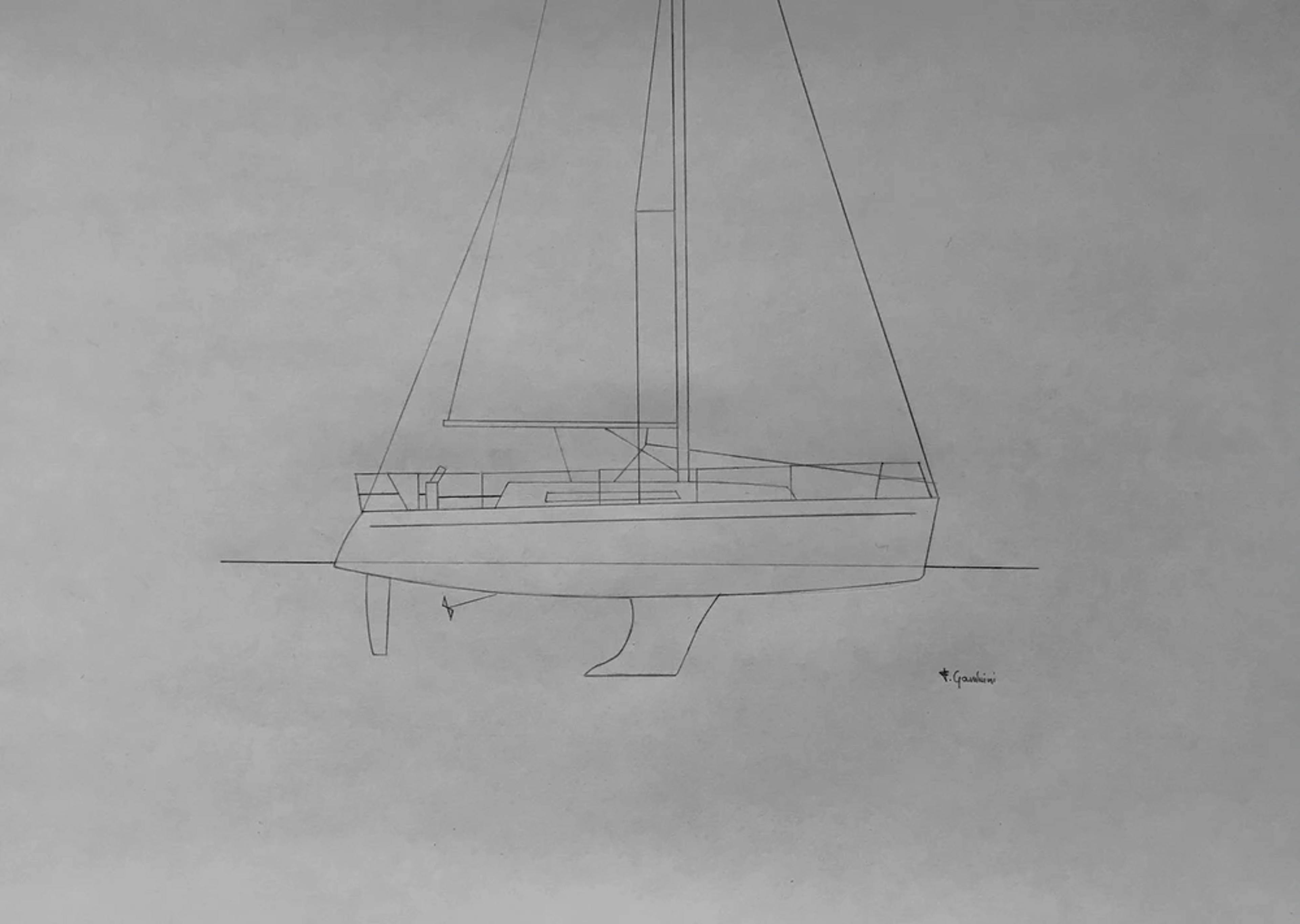
- Parts of a sailing boat: What's their use and can you locate them onboard?
From the bow to the stern
A sailing holiday is a holiday at sea... with a vitamin boost!
In fact, a sailing boat (I'm talking about a sailing boat, but what I've said is also valid for catamarans). Even if the size can feel relatively small, sailing boats hide lots of well-thought and organized spaces, each with its own peculiarities that we will discover during our holiday.
We will (soon) realize that some places are perfect for certain activities, while in others we will enjoy other moments of the day.
The sailing boat is a privileged point of view for a holiday at sea because it allows us to experience the sea... from the sea! This is no small detail...
Yacht charter: book your sailing holiday with us!
Let's start with the basics: what are the parts of a sailing boat .
A sailboat has a tapered shape. The front part is called the bow, whilst the back part is the stern.
Sailboats of the type we will be referring to here are called cabin boats because they have a living space inside the hull - namely, the cabin. Another aspect that identifies cabin boats is the keel's presence: a heavy ballast that ensures that it cannot tip over under any conditions. A cabin boat is clearly divided into an upper and lower section.
Above and below what? Above and below deck. The deck, otherwise known as the bridge, is the boat's outer surface, the one we walk on when we are outside. If we want to compare this space to your home, above you'll find the living area, and below, you'll have the sleeping area. It is above that we will spend most of our day on holiday, including meals.
The exterior and the cockpit
The external area is divided into three or four parts: Starting from the stern (we generally enter the boat from the rear, so this is in a sense our front door), we have the cockpit, which is the heart of the boat, this is where we will live most of our day, especially in summer. Bounded at the stern by the little beach and at the bow by the hatch, the opening that allows you to go below deck, the cockpit is a kind of living room of 4/6 square meters.
The cockpit, bordered by benches with soft cushions, features a helm wheel with all the nautical instruments and a superbly equipped table with lights, cup holders, and storage space for drinks and snacks.
You'll also find everything you might need to have at hand while sailing (sunglasses, hats, sun cream). The cockpit is naturally sheltered by the protected position, partially inserted inside the hull. The awning, also known as the bimini, shelters the cockpit from the sun (and rain). The canopy, also known as the sprayhood, shelters it from wind and water splashes. There is a central area in the middle of the boat with two walkways at the sides, mainly occupied by sail rigging but perfect for sunbathing as it is flat and a triangular area in the bow.
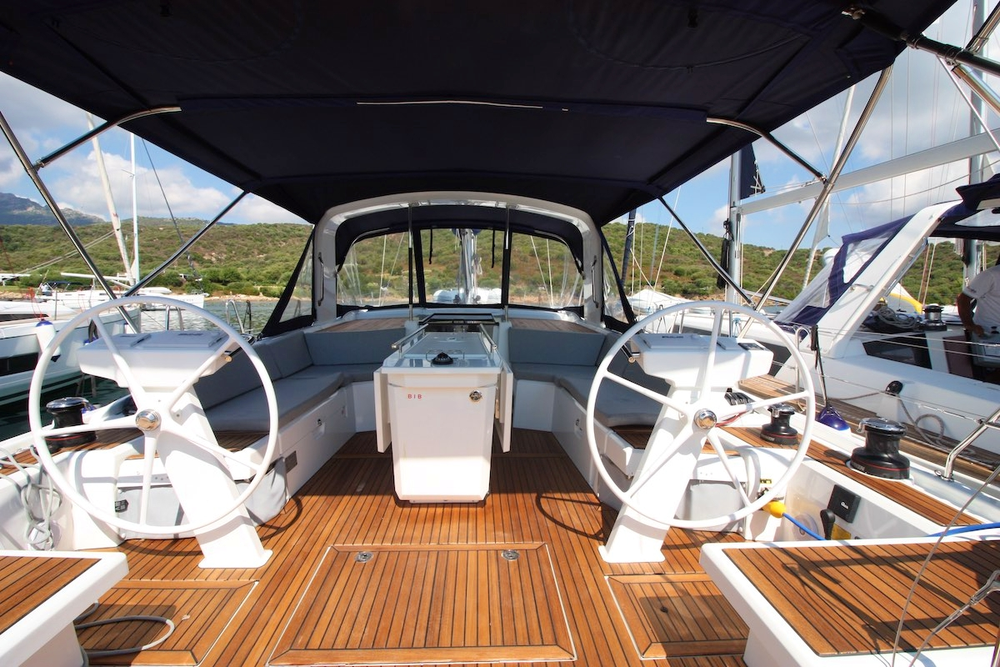
Exterior and the cockpit of a Beneteau Oceanis 46.1
Interior and dinette
After getting off, we will have the dinette, a sort of multifunctional living area with a small but well-equipped kitchen (two gas burners, two sinks, fresh and seawater at will, an under-sink fridge with a mini freezer).
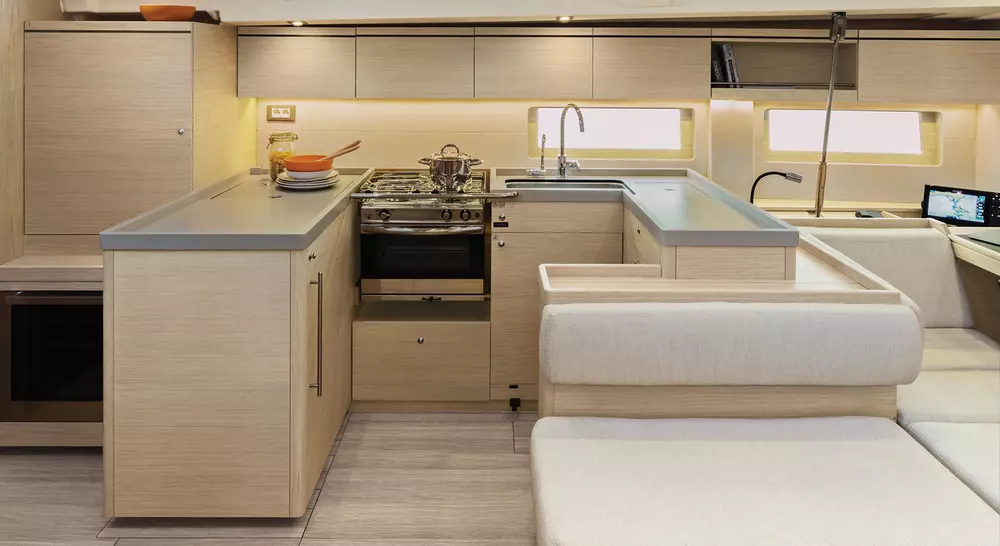
Interior and dinette of a Beneteau Oceanis 51.1
As in every house in every dinette, there is a table and chairs. Often the table is foldable to obtain two additional beds for friends passing through. On modern boats, this area, once the skipper's kingdom, is increasingly becoming the boat's technological heart, from all the monitoring takes place: the position of the boat, the battery charge, the water and fuel level, the switching on of all on-board equipment. For us, it's also where we charge our mobile phones.
This space is overlooked by the cabins and one or more bathrooms, small but very functional, in some cases with a separate shower. A sailboat, as the name implies, is characterised by the presence of sails. Sails are kept in position by the mast, which is made of aluminium. The mast is supported by strong steel cables: the one by the bow is called the forestay (to which the sail is wrapped around to form a soft sausage). The one at the stern, the forestay, often splits to facilitate boarding.
It is also excellent support for not one but two points of support.
On the right and left sides, the mast, which can be more than 15 metres high and is subjected to considerable strain, is supported by shrouds, one or more on each side, which reach right up to the outer side of the boat and are perfect for supporting it as it passes from stern to bow. In this article, I would like to point out two parts of the boat that I am sure you will appreciate to the fullest on your next sailing holiday. The first is the calling card of every holiday sailing boat, the stern platform, which can often be folded down. It is a platform on the surface of the water almost as wide as the boat itself, and its depth varies. Still, it is always enough to get in and out of the water and do all your favourite activities: yoga, diving, a snack, a nice shower or simply enjoy the moment with your feet underwater...
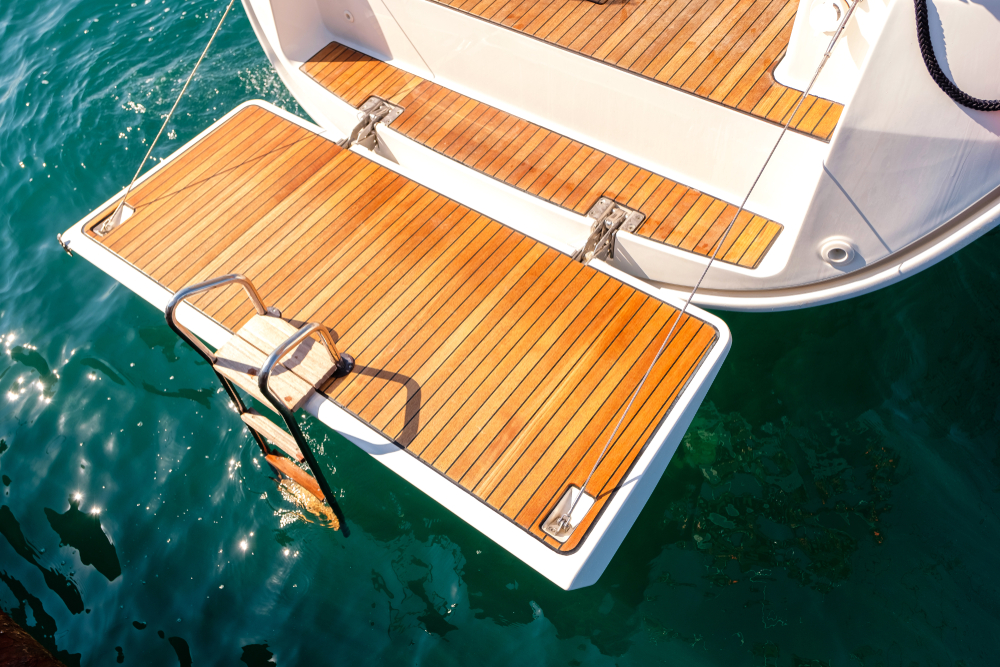
Deck of the sailing yacht from above
This delightful little balcony overlooking the sea also allows easy access on board in all conditions. The second is the bow of the boat itself, where the anchor winch is located. This area is often enhanced by a seat where we can sit back and watch the landscape change, "it's something I really like to do, especially on long motorboats," says Caterina, who has just returned from the Cyclades.
Yacht charter: book your sailing holiday with Sailogy
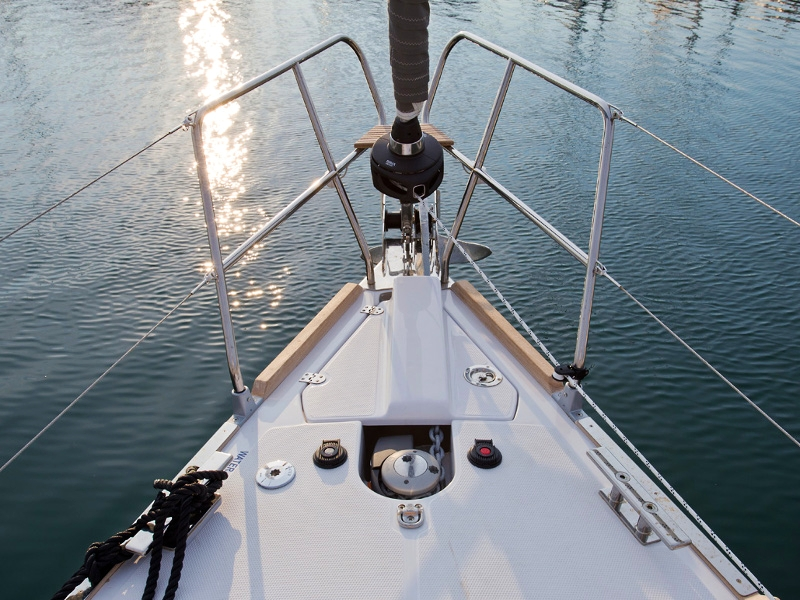
Elan Impression 45
Keep in mind while you're comfortably sitting on the bow and enjoying the scenery, not to end up in the water. You don't need to hold on with your hands. A good way is to put your legs on opposite sides of a candlestick.
A candlestick?!
Our boat is surrounded by a sort of safety railing: Let's see what it looks like: First of all, it is made up of rigid parts consisting of sturdy steel tube railings generally present at the bow and stern (pulpit) and flexible parts consisting of a set of vertical steel tubes firmly fixed to the deck of the boat (the stanchions) joined together by horizontal stainless steel cables (the dragnets).
A fine-meshed safety net can often be attached to these, which is advisable if there are children on board. What about you? What are your favourite parts of the boat?
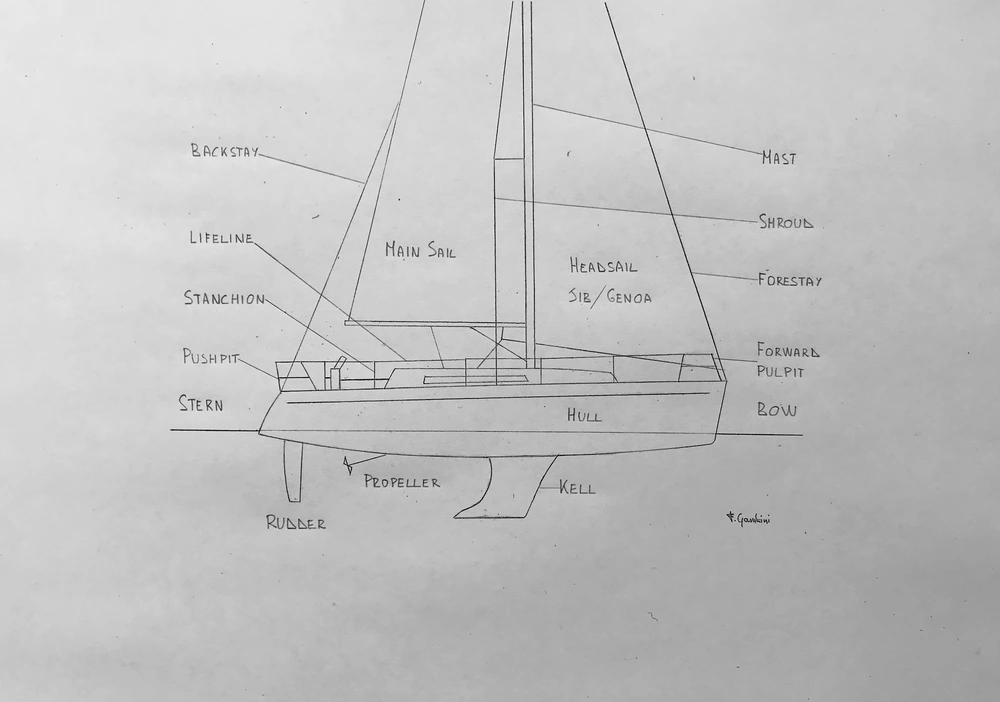
Discover our favorite yachts
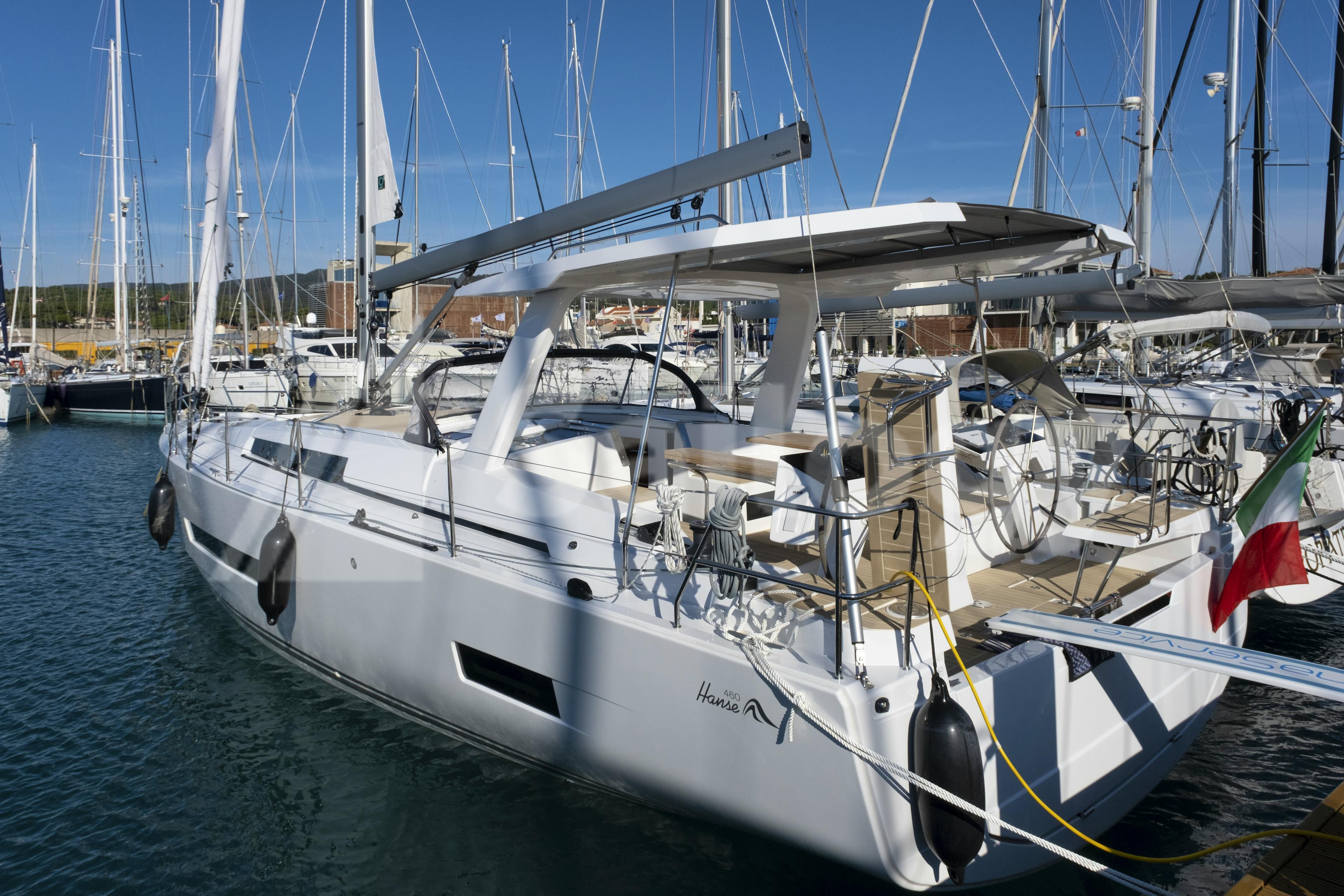
- Sailing boat
Castiglioncello, Tuscany
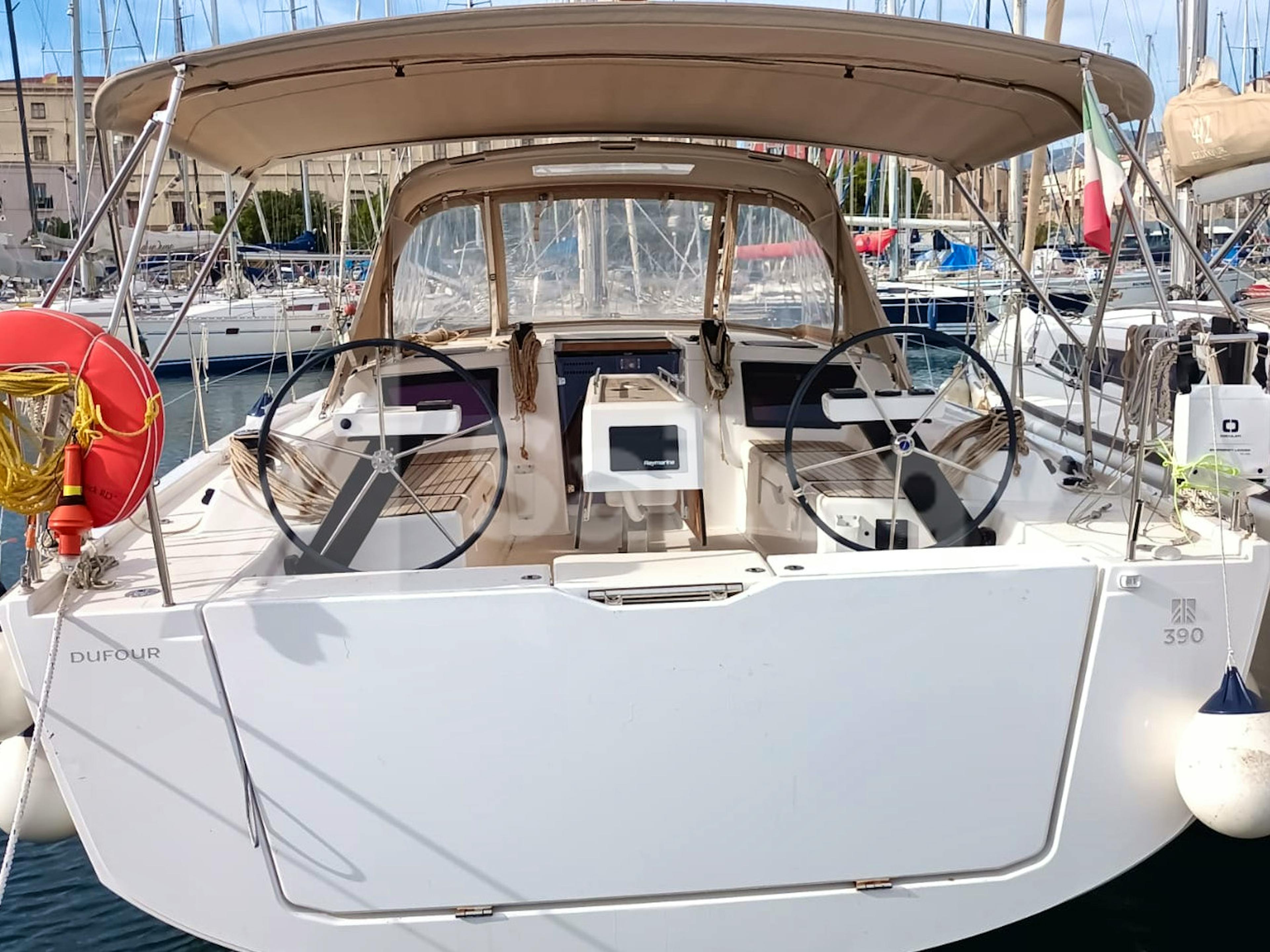
Dufour 390 Grand Large
Palermo, sicily.
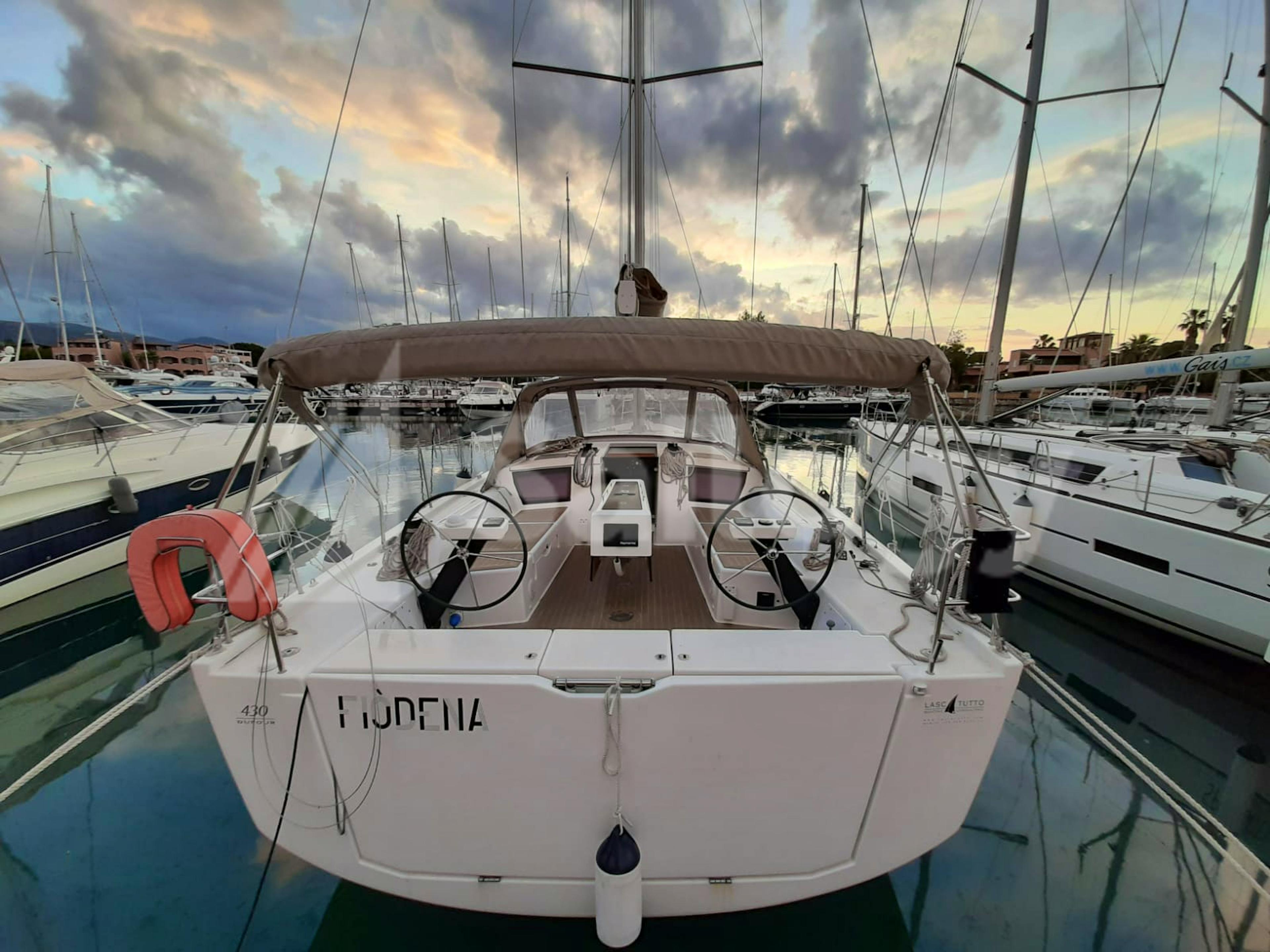
Dufour 430 Grand Large
Portorosa, aeolian islands.
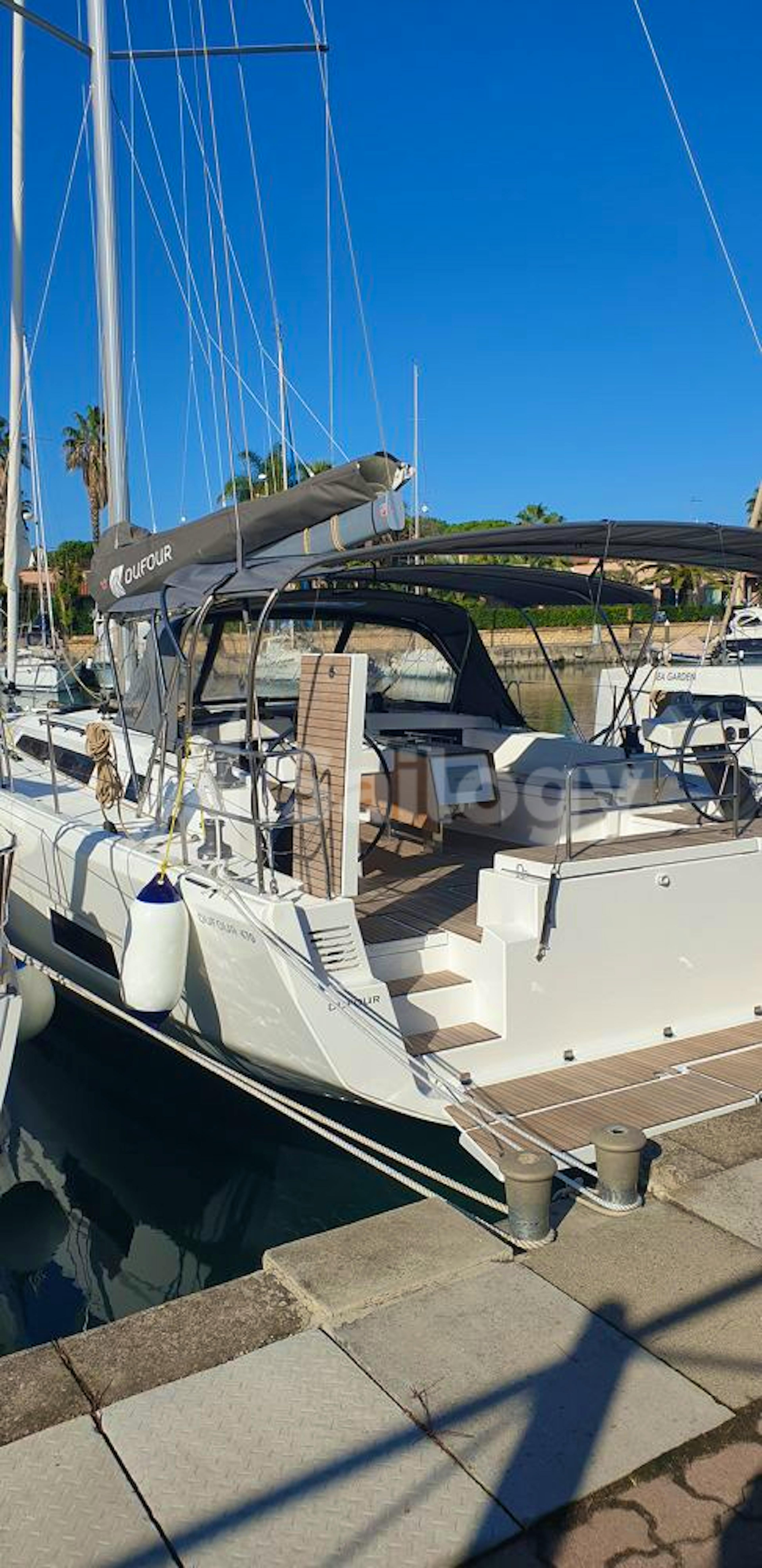
Kastela, Dalmatia
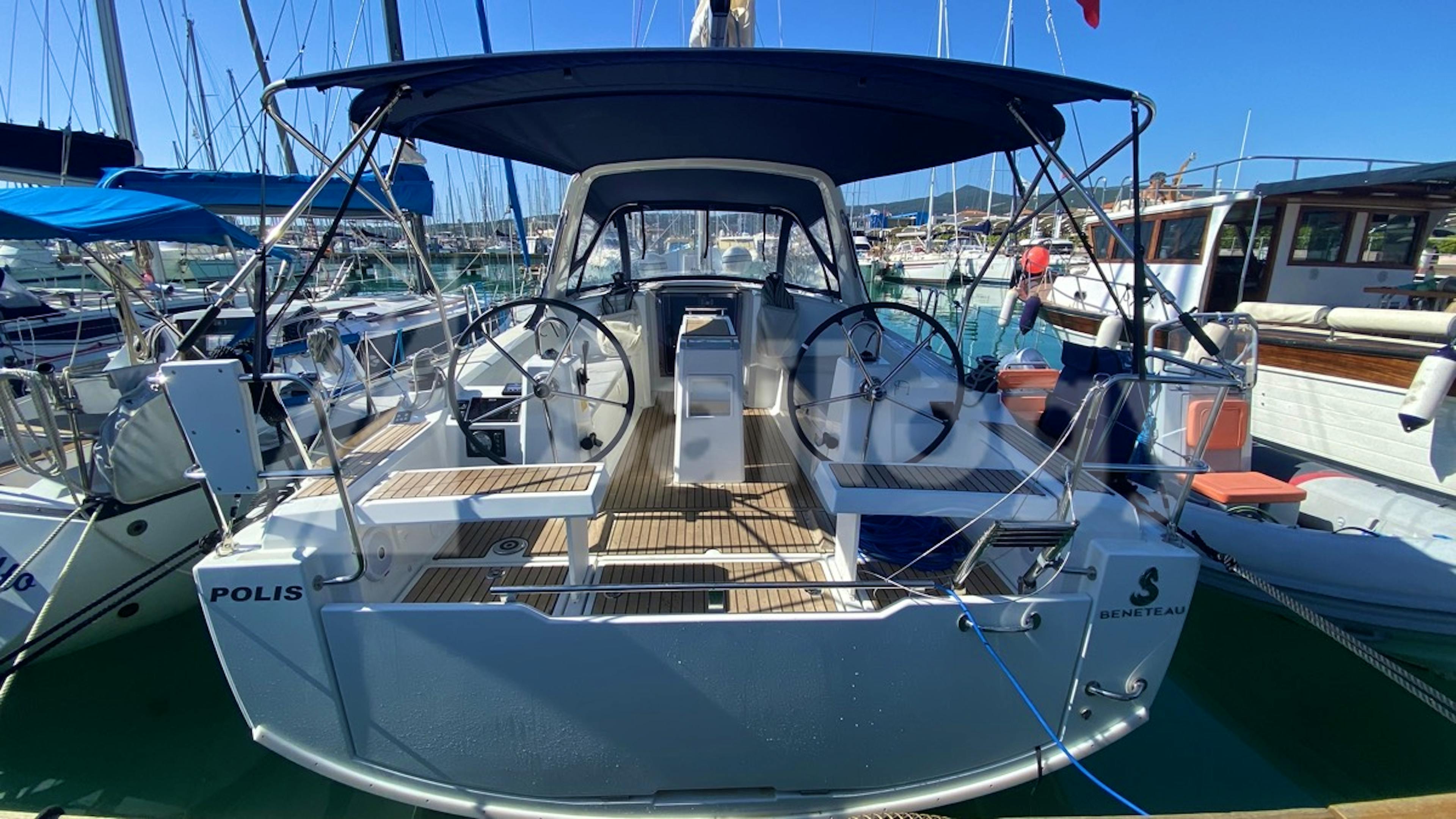
Beneteau Oceanis 35.1
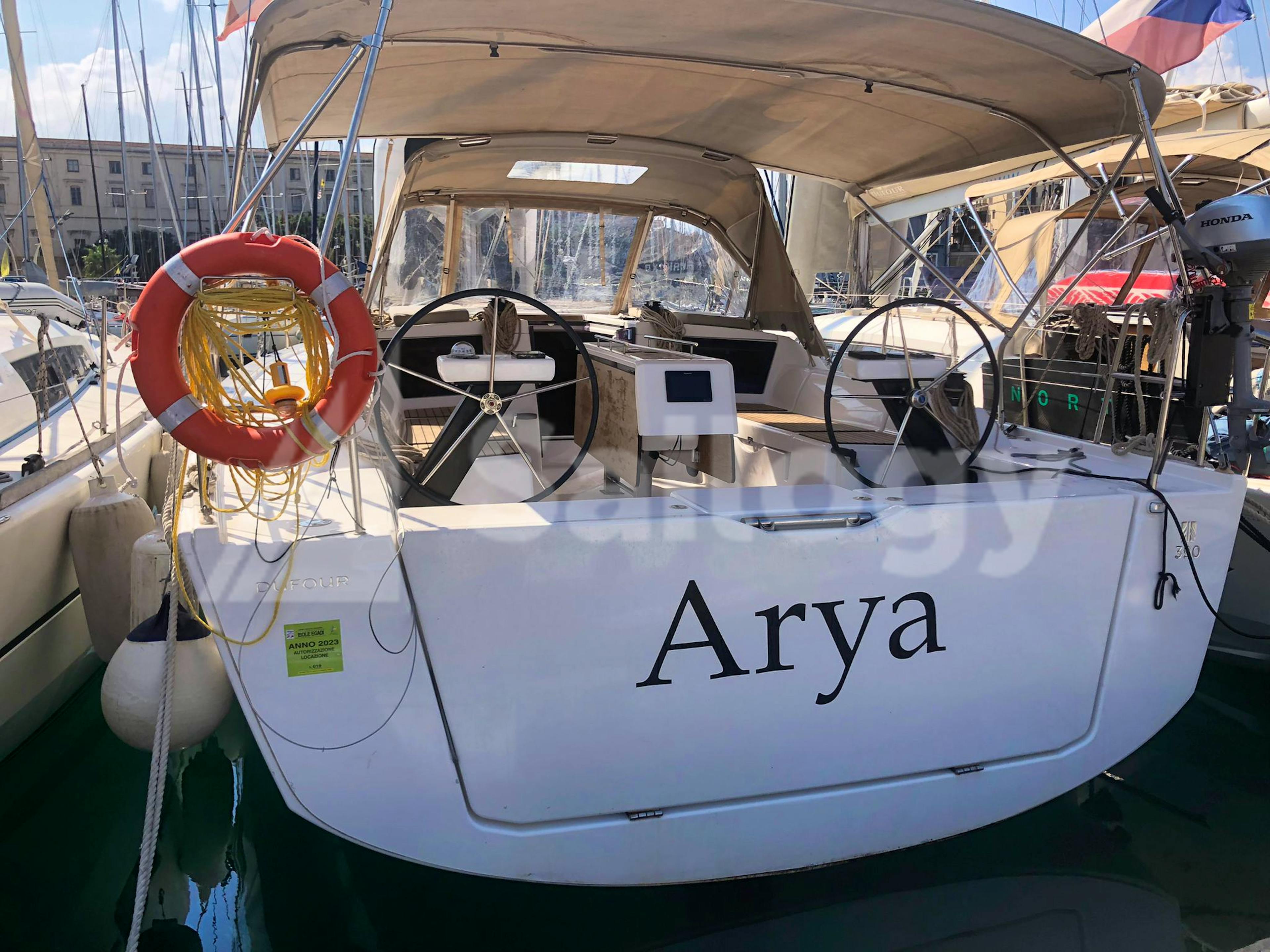
Kalamaki, Athens
Other articles.
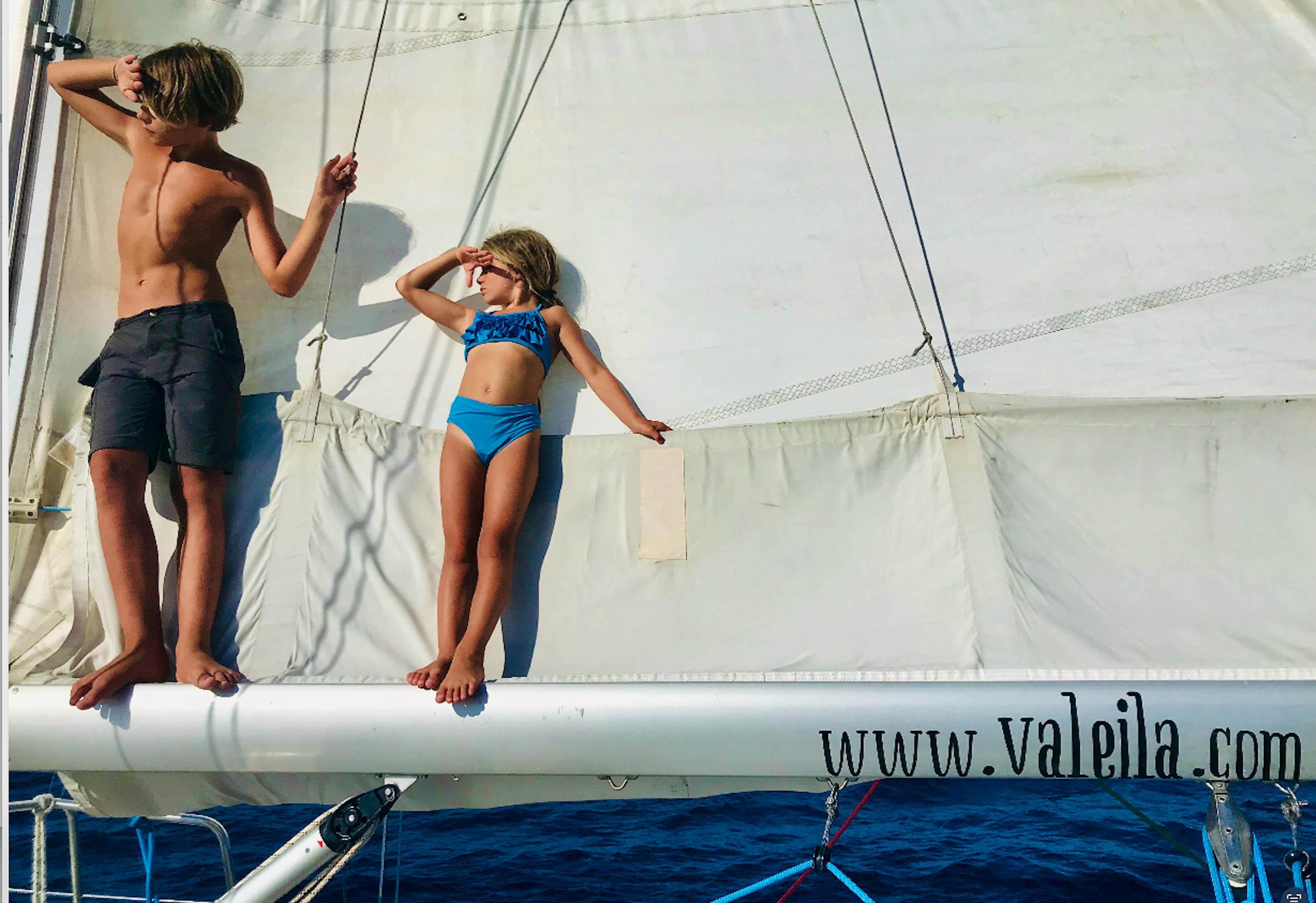
Segeln mit Kindern: Familienerlebnisse auf See schaffen
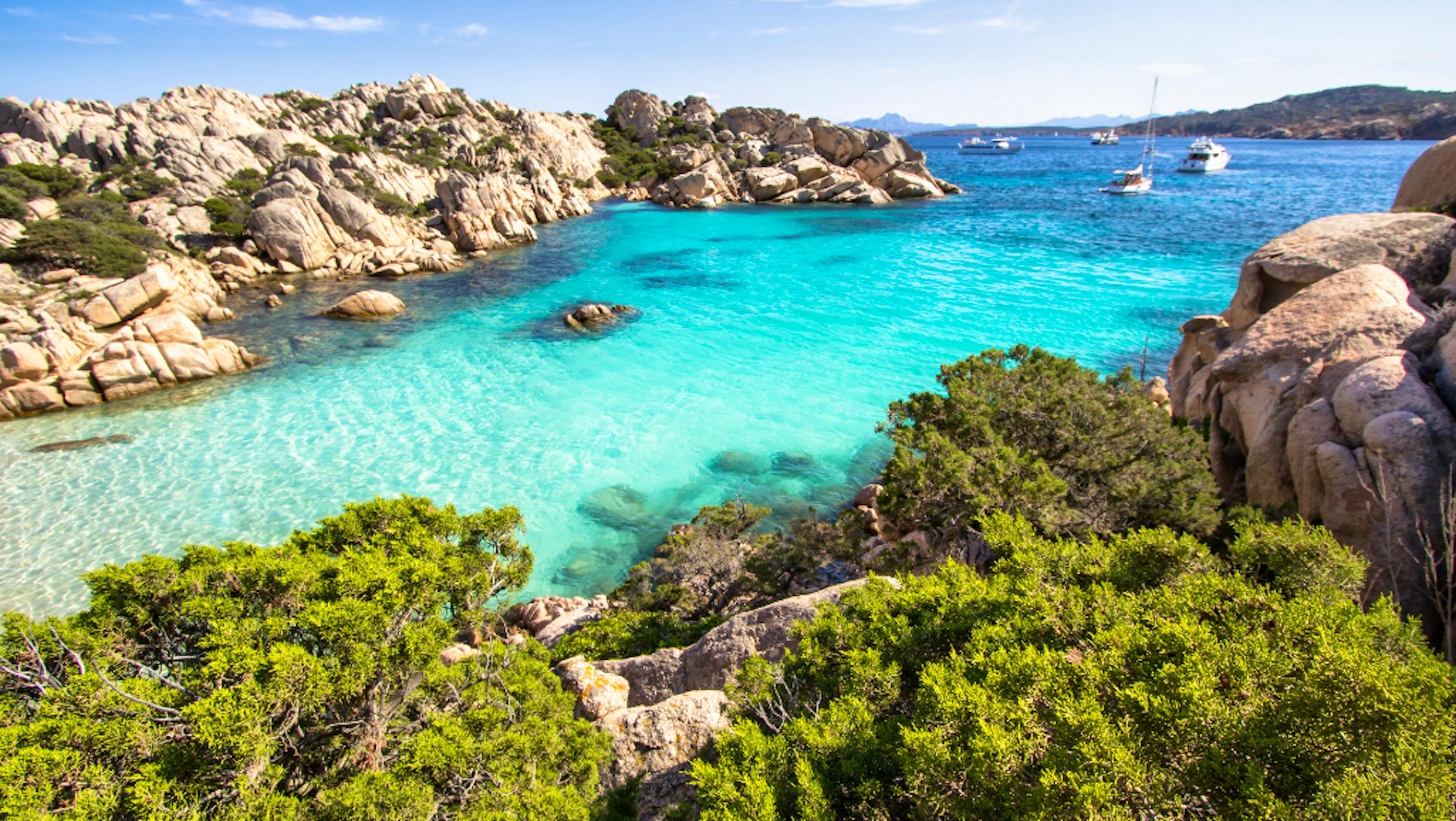
Die besten Strände Sardiniens von Norden nach Süden

Sailing with Kids: Creating Family Memories at Sea
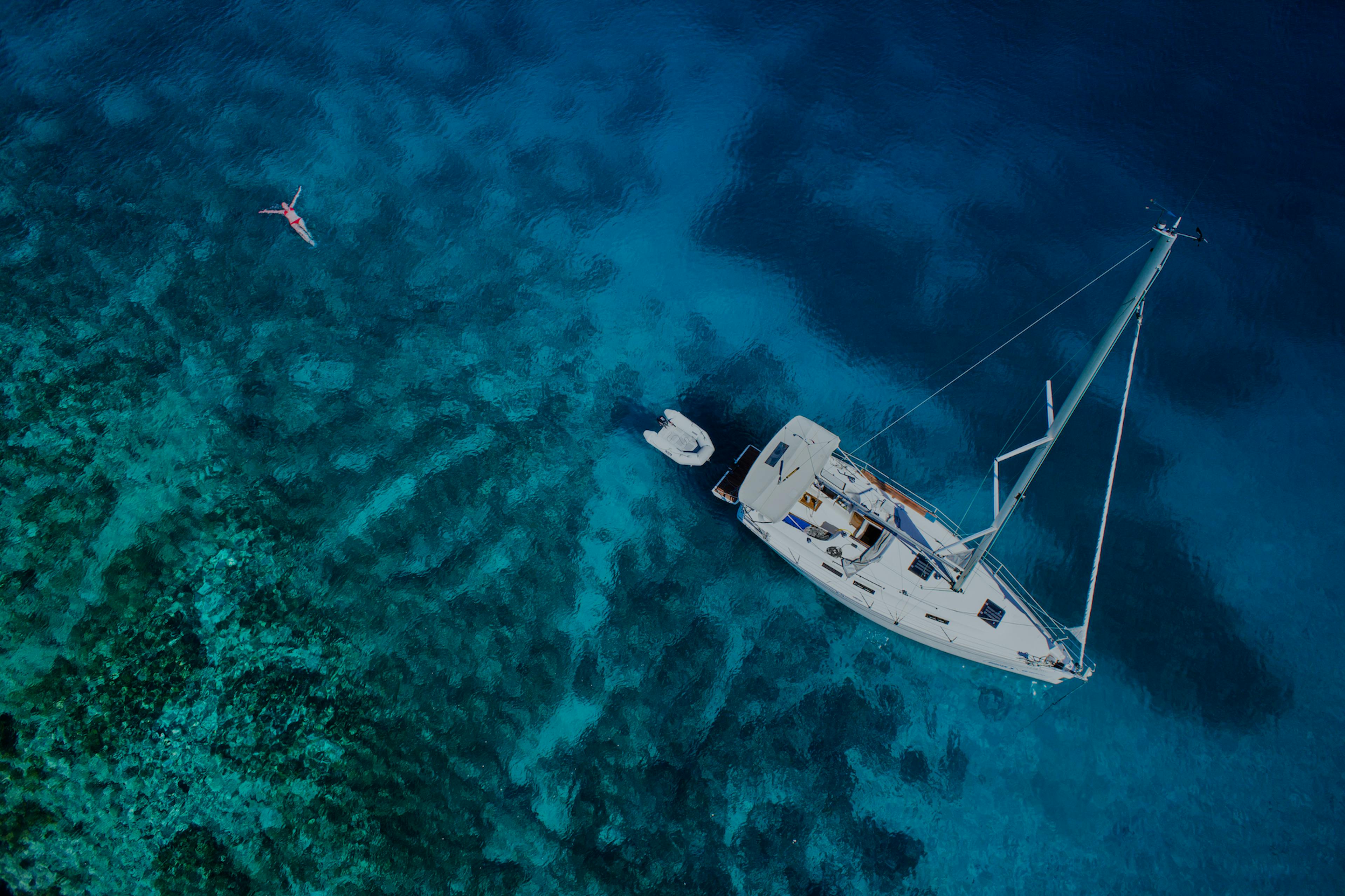
Stay in touch
New sailing magazine out now.
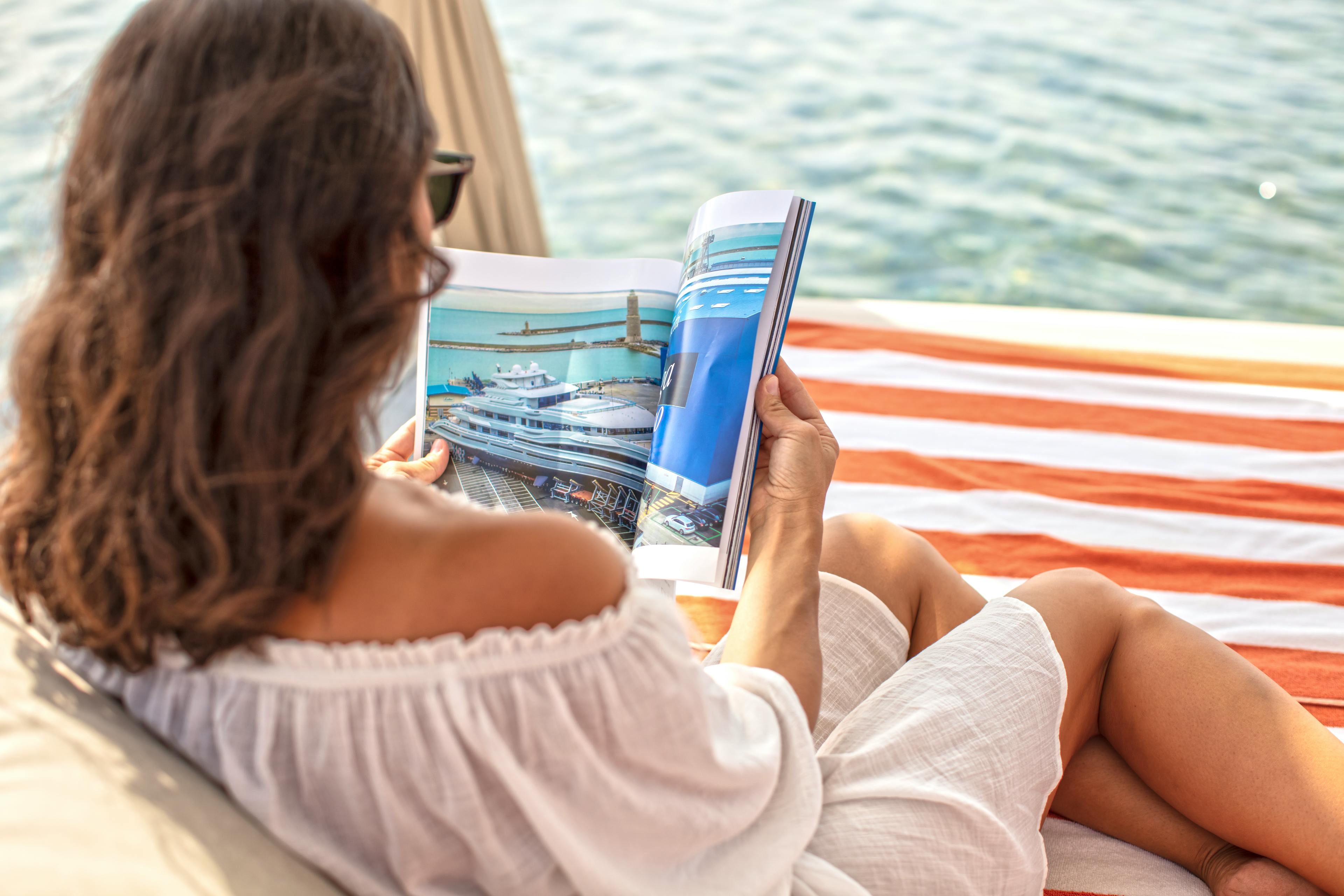

The Ultimate Guide to Choosing Between a Sailboat or Catamaran for Your Sailing Adventures
C hoosing between a sailboat and a catamaran for your sailing adventures is a significant decision that depends on various factors, including your sailing preferences, experience level, budget, and intended use. Here's an ultimate guide to help you make an informed decision:
1. Sailing Experience:
- Sailboats: Typically require more skill and experience to handle, especially in adverse weather conditions. Ideal for sailors who enjoy the traditional feel of sailing and are willing to invest time in learning and mastering the art.
- Catamarans: Easier to handle, making them suitable for beginners. The dual-hull design provides stability, reducing the learning curve for those new to sailing.
2. Space and Comfort:
- Sailboats: Generally have a narrower beam and less living space. However, some sailboats may offer comfortable cabins and amenities.
- Catamarans: Wider beam creates more living space. Catamarans often have multiple cabins, spacious saloons, and expansive deck areas, providing a more comfortable living experience.
3. Stability:
- Sailboats: Monohulls can heel (lean) while sailing, which some sailors enjoy for the thrill but can be discomforting for others.
- Catamarans: Greater stability due to the dual hulls, providing a more level sailing experience. Reduced heeling makes catamarans suitable for those prone to seasickness.
4. Performance:
- Sailboats: Known for their upwind performance and ability to sail close to the wind. Some sailors appreciate the challenge of optimizing sail trim for efficiency.
- Catamarans: Faster on a reach and downwind due to their wide beam. However, they may not point as high into the wind as monohulls.
- Sailboats: Typically have a deeper draft, limiting access to shallow anchorages and requiring deeper marina berths.
- Catamarans: Shallow draft allows access to shallower waters and secluded anchorages, providing more flexibility in cruising destinations.
- Sailboats: Generally more affordable upfront, with a wide range of options available to fit different budgets.
- Catamarans: Often more expensive upfront due to their size and design. However, maintenance costs may be comparable or even lower in some cases.
7. Mooring and Docking:
- Sailboats: Easier to find slips and moorings in marinas designed for monohulls.
- Catamarans: Require wider slips and may have limited availability in certain marinas, especially in crowded anchorages.
8. Intended Use:
- Sailboats: Ideal for traditional sailors who enjoy the art of sailing, racing enthusiasts, or those on a tighter budget.
- Catamarans: Suited for those prioritizing comfort, stability, and spacious living areas, especially for long-term cruising and chartering.
9. Resale Value:
- Sailboats: Generally have a more established resale market, with a wider range of buyers.
- Catamarans: Growing in popularity, and well-maintained catamarans often retain their value.
10. Personal Preference:
- Consider your personal preferences, the type of sailing you plan to do, and the kind of lifestyle you want aboard your vessel.
In conclusion, both sailboats and catamarans have their advantages and disadvantages. Your decision should be based on your individual preferences, experience level, budget, and intended use. If possible, charter both types of vessels to experience firsthand how they handle and to help make a more informed decision based on your own preferences and needs.
The post The Ultimate Guide to Choosing Between a Sailboat or Catamaran for Your Sailing Adventures appeared first on Things That Make People Go Aww .

News | The Annapolis Spring Sailboat Show offered a…
Share this:.
- Click to share on Facebook (Opens in new window)
- Click to share on Twitter (Opens in new window)
Baltimore Sun eNewspaper
- Anne Arundel County
- Baltimore City
- Baltimore County
- Carroll County
- Harford County
News | The Annapolis Spring Sailboat Show offered a ‘First Sail’ workshop. Here’s how it went.

At the end of each April, the Annapolis Spring Sailboat Show is a weekend outing spent ogling boats along City Dock that cost nearly as much as a house, if not more, and dreaming about sailing around the world.
But for those who participated in the hands-on First Sail Workshop, the show was a chance to begin pursuing what could be a lifelong love of the sport. And, is there really a better way to spend your Friday morning?
For one student, the class was a way to dip his toes in the water, testing it out before he committed to a three-day introductory course. Another student had inherited a boat and needed the skills to sail it. Ron Soberano, a Montgomery County resident, had spent years watching sailing videos on YouTube and hoped to make his own channel. Others were seeking out something new.
I also wanted to get a glimpse of what it was like to learn how to sail, but full disclosure — it wasn’t new to me. I’m already a sailor and an American Sailing Association certified instructor with several years of teaching ASA 101, the introductory keelboat sailing course that many sailors start with, under my belt.
While it never hurts to brush up on skills, even as a seasoned sailor, the workshop was a chance to see others experience the same joy that I felt the first time I went sailing, an enchantment with the water that still holds steady more than a decade after my own first sail. That experience is craved by others, too — several dozen spaces offered in the First Sail Workshops on Saturday and Sunday are sold out.
We started our journeys before the show opened for the weekend, learning the ropes in our makeshift classroom, a sunlit space above Latitude 38. The blue skies outside and a light breeze made for a perfect first day on the water.
ASA instructor Ken Roach, a longtime sailor from Delaware, walked us through the basics, using a model cutter rig sailboat to show us the parts of the boat — keel, hull, bow, stern, mast, standing and running rigging, jib and mainsail, port and starboard, among others, scratching the surface of the new vocabulary to be learned when embarking on your first sailing journey.

Adding to the lesson, Roach also showed us how to interpret a diagram of the points of sail, the directions of the wind that dictate where a boat can sail, and informed us of the rules of the road, or water.
As we walked outside after our classroom lecture, eager to hit the docks, the boat show was coming alive. Vendors and yacht brokers milled around, setting up for an eight-hour day under tents and on boats. The three-day event continues Saturday from 10 a.m. to 6 p.m. and 10 a.m. to 5 p.m. on Sunday.
Amid a sea of cruisers, our boat, a Beneteau First 22, awaited. The 22-foot keelboat boasts ample cockpit space and responsive, yet forgiving twin rudders, a design specifically tailored for beginner courses.
Rick Robey, another longtime ASA instructor and captain, was ready to get on the water, guiding each of us on the correct way to board the boat, ensuring we each had a hand on the shroud and a foot firmly planted on the deck as we stepped on — multiple points of contact are crucial when transferring from a floating dock to the boat.
The power of a tiny electric outboard motor would help us leave the dock once our lines were cast off, and Soberano guided us out past the mooring field in Spa Creek toward the Severn River. For him, taking the helm was bringing his years of watching others sail around the world on a screen to reality.
Once our bow was pointed into the wind, another classmate, Angela Ring, and I worked to raise the mainsail, tightening the foot of the reefed sail before unfurling the jib. With sails up, the motor was switched off, with only the sound of water lapping against the hull and a faint din from the show to be heard.
Ring, a Bowie resident who had casually motored around on powerboats for years before taking the workshop, decided to set sail on Friday to see if she liked it before diving deeper into lessons.

At 10 a.m. on a Friday, boat traffic on the water is light, lending itself to an ideal first-sail environment. A moored boat dead ahead, however, meant that we needed to change course. It was up to us, under the watchful eye of Robey, to navigate onto a new tack.
“Prepare to tack,” Soberano, our helmsman, said.
“Ready!” Ring and I replied, readying at the winches as the bow turned through the wind.
That would be the first in a series of tacks and jibes, with our responsibilities switching between taking the helm and working as crew over the 90-minute voyage. Although the breeze faltered at times, we were smoothly sailing throughout, possibly hitting a top speed of 4 knots.
All good things must come to an end, however, and the time came to drop the sails and motor back to the dock.
Though our arrival back to shore ended the trip, for my classmates, it wasn’t a true ending: it was the beginning of their sailing journeys. I can only hope that this morning excursion sparked a similar love for sailing in them, and that they, too, will find this to be a joy lasting a lifetime.
The First Sail Workshop, presented by the American Sailing Association, is available at the Annapolis Spring Sailboat Show in April and the Annapolis Sailboat Show in October.
More in News

Business | Coalition against Harborplace redevelopment in Baltimore seeks to defeat November ballot question

Education | Maryland State Board of Education limits dual enrollment courses
![Gov. Wes Moore joined members of the Maryland State Board of Education Tuesday to present awards to eight public schools that excel at supporting students from military families. Children from military families have unique needs related to how often they move to different states and school systems. The state started the “Purple Star School” program in 2022 to recognize schools that connect students to their communities and handle other challenges caused by differences in credits, classes and volunteer hours. Moore, a Democrat, told a packed board room how he had signed up for the Army as a 17-year-old student and […] Gov. Wes Moore joined members of the Maryland State Board of Education Tuesday to present awards to eight public schools that excel at supporting students from military families. Children from military families have unique needs related to how often they move to different states and school systems. The state started the “Purple Star School” program in 2022 to recognize schools that connect students to their communities and handle other challenges caused by differences in credits, classes and volunteer hours. Moore, a Democrat, told a packed board room how he had signed up for the Army as a 17-year-old student and […]](https://www.baltimoresun.com/wp-content/uploads/2024/04/TBS-L-Purple-Star-Award.jpg?w=501)
Education | Maryland Gov. Wes Moore gives 8 schools awards for supporting students from military families

Politics | At energy forum, 10 Democrats vying for Sarbanes’ seat talk climate issues affecting vulnerable communities

Queen Camilla hails 'brilliant' all-female sailing crew at Clarence House reception
The queen hosted the crew of the maiden at a special reception.
The Queen hailed the record-breaking crew of The Maiden as “brilliant” as she welcomed them to Clarence House to celebrate their unprecedented victory in the Ocean Globe Race.
They became the first ever all-female crew to win an around-the-world yacht race, setting sail last September and crossing the finish line on April 16 after spending 153 days at sea and raising funds and awareness for girls’ education.
Thanking them for coming, Her Majesty said: "I think you are doing a brilliant job. Keep on doing it, it’s really important."
As she greeted veteran sailor Tracy Edwards, who founded The Maiden Factor, which promotes girls’ education through the Yacht, Camilla said: "You’ve brought the warm weather with you. It’s rather warmer than Scotland, where I’ve just come from, which was absolutely freezing!"
Before the crew set sail last year, the Queen sent a message to say: "You are all much in my thoughts today, as you cross the start line of the Ocean Globe Race for Maiden’s final race. I do hope that each one of you is proud to be part of such a special crew, bringing Messages of Hope to girls across the world. I wish you fair winds and following seas! - Camilla R."
You may also like
Today, as they gathered at the King and Queen’s London residence over tea, sandwiches, cake and Champagne, the crew were introduced to Her Majesty, who joked that "everybody looks younger and younger."
Hailing the winning crew’s skipper Heather Thomas, Tracy told the Queen: "She's happy, she has a glass of Champagne in her hand."
“Quite right!” replied Camilla.
Turning to Heather, 27, she said: “You are a very young skipper!”
"I'm the same age that Tracy was when she did the race."
The crew’s success comes three decades after celebrated yachtswoman Tracy and her all-female crew finished second in the 1989 to 90 Whitbread Round the World Race aboard the 58ft Maiden, becoming the first all-female team to take part in an around-the-world race.
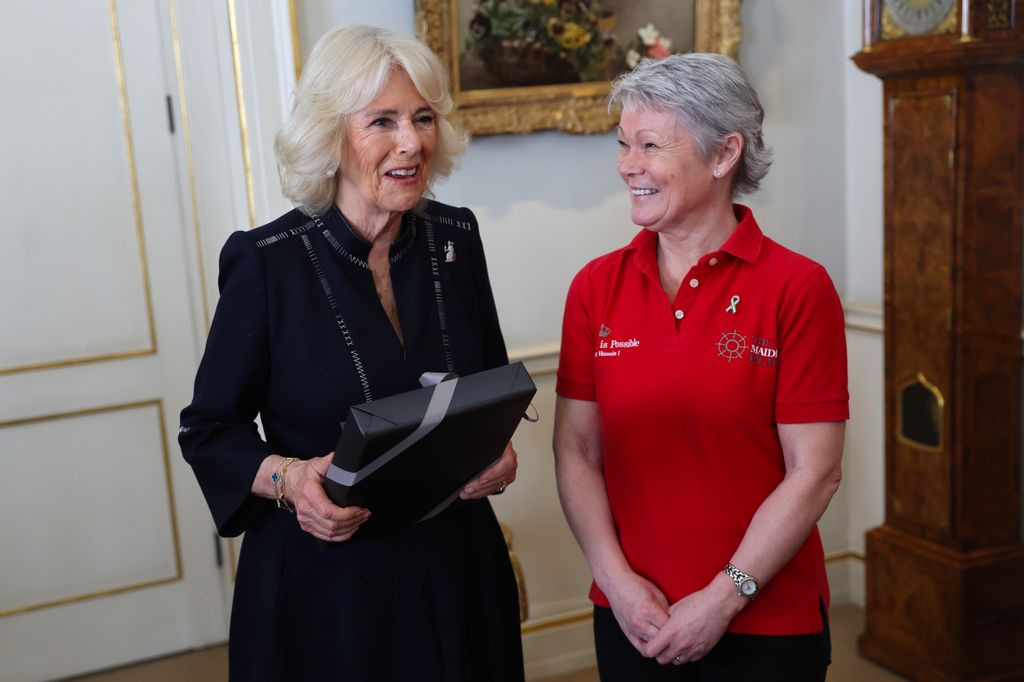
Asked by the Queen how she became a sailor, Heather replied: “I used to sail dinghies with my dad and then..."
"A bit of a bigger Dinghy!" joked the Queen
Heather went on: "I come from Yorkshire, we’re pretty landlocked. I went on a boat called James Cook which is run by the Ocean’s Trust up in Newcastle and takes disadvantaged kids on trips in the North East and I loved it. I came back and volunteered and at 18 I decided that’s what I wanted to do."
The 2023-24 retro-style race, which took place 50 years after the 1973 Whitbread Round the World Race, saw the crew ditch computers, GPS, and other high-tech tools for sextants and paper charts.

The Queen giggled as she was told how crew members were allowed to play cassette tapes during the voyage and had to be shown how to re-spool tape using a pencil.
"You learned a lot of new skills!" she laughed.
Sailors on board 14 boats raced over four legs across 27,000 nautical miles, taking in stops in South Africa, New Zealand and Uruguay. This year's crew was waved off by Tracy as the most diverse professional sailing crew ever to sail the world.
Members come from the UK, Antigua, USA, South Africa, Puerto Rico, Italy, France and Afghanistan and include the first Black and Middle Eastern female crew members to take part in such a race.
The Queen was introduced to Najiba Noori, a former AFP camerawoman who fled Afghanistan nearly three years ago and was recruited to film aboard the Maiden during the race.
She told Camilla: "I grew up in the mountains, I had never been at sea."
Speaking afterwards, she said: "It was a little bit scary, especially when there were big waves and wind, but slowly, slowly, it was okay.”
She said of her escape from the Taliban: "The day I left Afghanistan, that was the toughest day of my life and the toughest decision I’ve made. I had just five minutes to decide should I leave or stay. But I knew that if I stayed I would be a prisoner."

Najiba, who now lives in France, said of her meeting with the Queen: "I would never imagine to sail around the world and.. win the race and after that to meet the Queen. It was very nice to talk to her and tell her a little bit of my story.
"She told me 'It’s very important that you were part of this race', sailing on Maiden, which has a very important message for the world about girls’ education. That was the reason that I decided that I wanted to do this race for the women and girls of Afghanistan."
Najiba, who celebrated her 29 th birthday at sea, added: "I decided to do it just to bring a little bit of hope for the girls and for the women of my country."
The Maiden was repurposed in 2018 to raise funds and awareness around girls’ education and the-then Prince of Wales and Duchess of Cornwall visited her, accompanied by Princess Haya of Jordan, whose father King Abdullah funded the yacht and who helped to fund its refurbishment.
The Queen met 13 crew members and another six on-shore team members, along with Tracy. They included three other members of the original 1989 to 90 team – Marie-Claude Heys, former First Mate for training, Sally Hunter, crew member and Howard Gibbons, who served as an on-shore project manager.
Before leaving, Tracy presented the Queen with a framed, gift-wrapped photograph of The Maiden, which features a spinnaker designed by school girls and hand-painted by the crew and bearing the words: "Respect, Peace, Dignity."
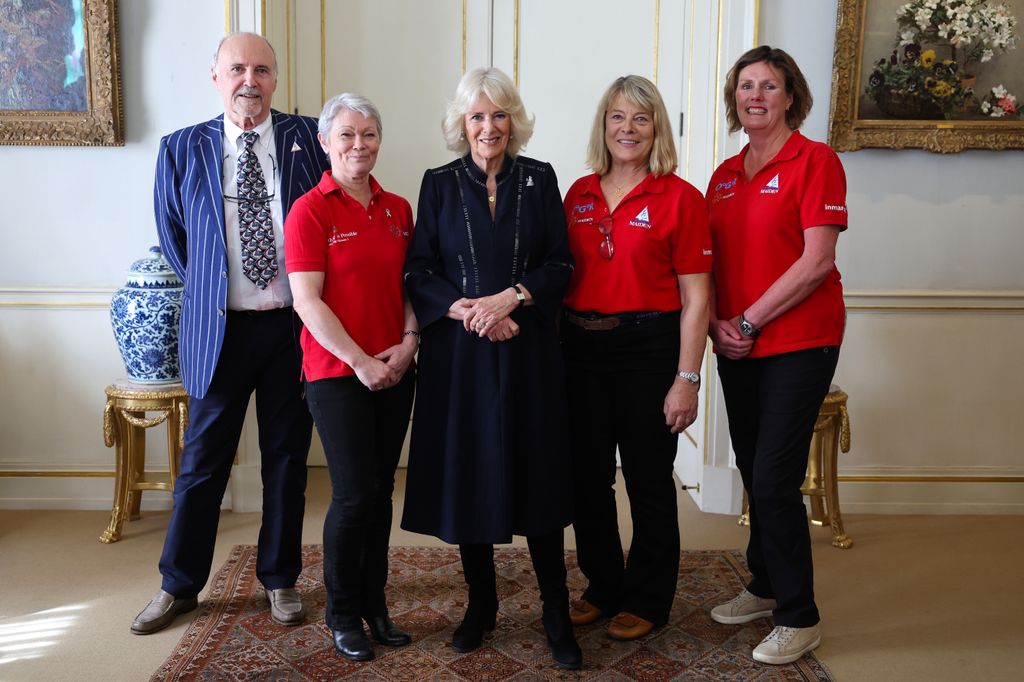
Speaking afterwards, Tracy said: "It’s the perfect bookend to the project we've just done. Her Majesty Queen Camilla actually launched Maiden in September 2018. Since then we’ve been around the world twice, had a pandemic and raced around the world with a new young all female crew – the most diverse female crew that's ever been on a professional sailing team. And they have become the first all-female crew to win an around the world. And then she's invited us here today. It's the perfect circle."
Tracy said of the Maiden’s victory: “For me it's the end of a 45 year fight for the equality of women within sailing sports generally."
She said of the diverse crew: "Sailing is described as male, pale and stale. So with maiden in 1989 we dealt with the male and stale bit, we didn't deal with the pale bit."
She went on: "When Whoopi Goldberg became our patron, she looked me square in the eye and when she went, 'Change it', I went, 'Ok!' So we did.” She said it was vital to keep the sport “evolving”, adding “we’ve got to keep changing our sport or it will die."
She said of Queen Camilla: "We are so lucky to have her as our Queen. I remember meeting her when she launched Maiden and she was talking about the empowerment of women. I don’t think people realise how much she does in that sphere."
Asked about Najiba's story, Tracy said: "We wanted to highlight what was going on in Afghanistan. 130 million girls didn’t have an education before the pandemic and the Taliban… that number has increased."
Skipper Heather Thomas described the Queen's support as "massively important," adding: "We're a British vessel, we've got a lot of history in this country so to have the support of the monarchy is really important to us."
She said: "It was amazing to bring the team and to show them off to the Queen and to get them to see the Queen and be recognised for what they've done."
LISTEN: A Right Royal Jam - and more!
LOVE THE ROYALS? JOIN THE CLUB!
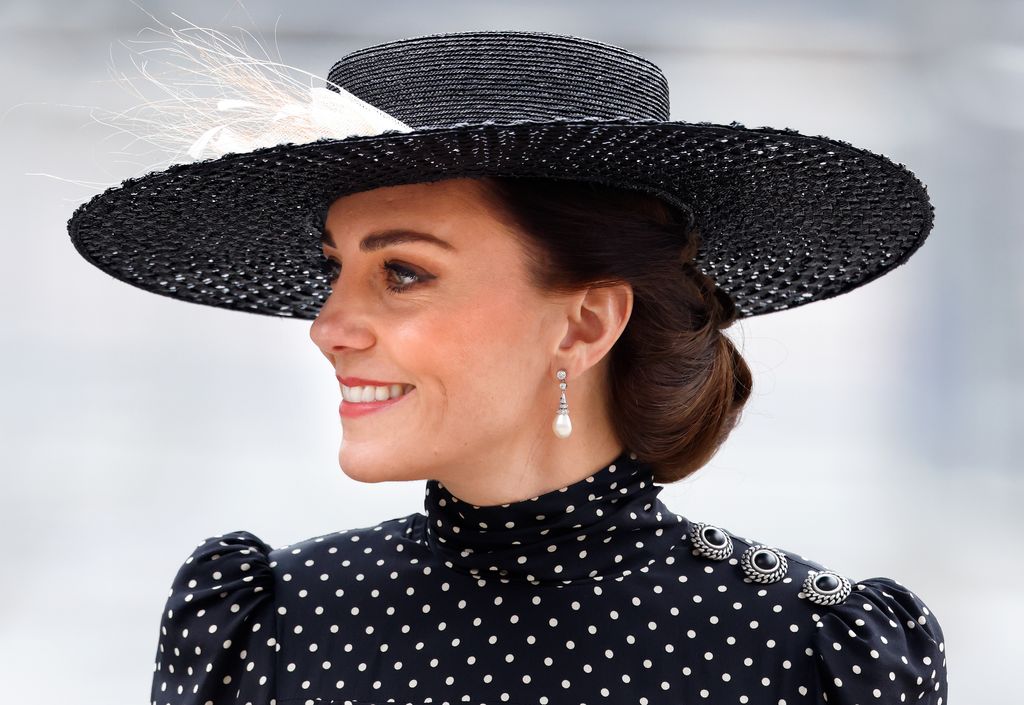
If you are reading this, the chances are you are obsessed with all things royalty – which is just as well because so are we! So obsessed, in fact, we’ve launched a club solely dedicated to covering them. So welcome to The HELLO! Royal Club . We would love you to join us there…
What is it?
Interactive community offering behind-the-scenes access, exclusive royal interviews, unmissable royal insights, and an illustrious royal Inner Circle .
Member benefits
- Two weekly newsletters, one from Emily Nash
- Video posts and audio notes from Emily Nash and the HELLO! Royal team
- Access to our royal community and opportunity to interact with club writers and members
- Participate in polls, comments and discussion threads
- Access to our Ask Me Anything sessions with our journalists
- Invitations to in-person and virtual events
- A subscription to the digital edition of HELLO! Magazine (Worth £82 annually)*
- Future ‘Inner Circle’ benefits
By royal decree
You are royally invited to join The HELLO! Royal Club – and then to go forth and spread the word to your fellow royal fans. See you in the club!
- British Royals
- Queen Camilla
More Royalty

Gallery King Charles reveals how he felt when told about cancer diagnosis and holds hands with patients - inside his first public outing

Beaming Queen Camilla looks divine in floaty leopard print look

New photo of King Charles and Queen Camilla has royal fans saying the same thing

King Charles announces return to public duties with loving new photo alongside Queen Camilla

King Charles gives prestigious new roles to four family members

Eco royals: How King Charles, Prince William, Princess Eugenie & more are fighting to protect the planet

King Charles reappears on late Queen's birthday as he drives wife Queen Camilla to church

Inside Queen Camilla's love life before King Charles
Queen camilla is a regal vision in sheer leopard print, queen camilla makes first appearance after easter break for cause close to her heart, where king charles and queen camilla spent their wedding anniversary, gallery princess anne, queen margrethe and more royal grandmothers doting on their grandchildren.
A cruise to nowhere: Royal Caribbean sailing canceled after guests boarded

A Royal Caribbean International Alaska voyage became a cruise to nowhere over the weekend, with the line canceling the sailing after guests had already boarded.
The cruise line’s Radiance of the Seas ship experienced propulsion issues, forcing it to shorten and eventually scrap the weeklong itinerary, according to notices shared with guests. The sailing was originally set to depart from Vancouver on Friday.
Charlene Chong, who was on board with her husband, their 3-year and 11-month-old children, and her parents, said passengers were notified Saturday afternoon that the cruise was canceled. The 34-year-old teacher and her husband previously took a cruise for their honeymoon, but this marked their first trip with Royal Caribbean.
“My parents had wanted to go to Alaska for a really long time,” said Chong, who lives in Vancouver.
The cruise line warned guests several days before boarding that the ship had a “technical issue with its propulsion system,” according to an email sent to passengers that Chong shared with USA TODAY. The line later pushed the departure back by two days to allow more time for repairs.
Royal Caribbean said boarding would proceed as planned but that the terminal would close Friday evening due to U.S. Customs and Border Protection rules. Passengers would not be able to leave until the ship arrived at Icy Strait Point.
“We were going stir crazy a little bit,” said Chong.
Royal Caribbean gave guests onboard credit worth two days of their fare, a future cruise credit of the same amount, complimentary drinks and other compensation, another email said.
According to Chong, the ship sailed toward a nearby cargo port, but the captain announced Saturday afternoon that the sailing could not proceed and that guests would need to disembark by Sunday at 4 p.m. Chong said she and her family were “lucky” they were local, but she saw other guests scrambling to change their flights and find accommodations.
Your cruise was canceled: Now what?
“We understand the disappointment due to this unfortunate turn of events,” the cruise line said in a letter shared with guests. “We truly extend our sincerest apologies for the continued unforeseen disruptions to your vacation.”
Royal Caribbean gave them their money back as onboard credit with any remaining amount refunded, increased their future cruise credit to 100% of their fare and kept its open-bar policy for the remaining time on board. The line also offered to reimburse trip change fees up to $250 for guests traveling domestically and $400 for international travel and additional reimbursements for hotel and transportation costs, among other compensation.
The cruise did not immediately respond to USA TODAY’s requests for comment.
After they got home, Chong and her family booked a trip to Mexico instead – though her parents decided not to join as they were “a bit exhausted by the whole ordeal.” For now, she’s not inclined to use the future cruise credit. “I would like to go to Alaska,” she said. “I'm not sure if I want to go with them.”
Nathan Diller is a consumer travel reporter for USA TODAY based in Nashville, Tennessee. You can reach him at [email protected].
NASA will unfurl a 860-square-foot solar sail from within a microwave-sized cube
The highly advanced solar sail boom could one day allow spacecraft to travel without bulky rocket fuel.
By Andrew Paul | Published Apr 24, 2024 11:53 AM EDT

NASA hitched a ride aboard Rocket Lab’s Electron Launcher in New Zealand yesterday evening , and is preparing to test a new, highly advanced solar sail design . Now in a sun-synchronous orbit roughly 600-miles above Earth, the agency’s Advanced Composite Solar Sail System (ACS3) will in the coming weeks deploy and showcase technology that could one day power deep-space missions without the need for any actual rocket fuel, after launch.
The fundamentals behind solar sails aren’t in question. By capturing the pressure emitted by solar energy , thin sheets can propel a spacecraft at immense speeds, similar to a sailboat. Engineers have already demonstrated the principles before, but NASA’s new project will specifically showcase a promising boom design constructed of flexible composite polymer materials reinforced with carbon fiber.

Although delivered in a toaster-sized package, ACS3 will take less than 30 minutes to unfurl into an 860-square-foot sheet of ultrathin plastic anchored by its four accompanying 23-foot-long booms. These poles, once deployed, function as sailboat booms, and will keep the sheet taut enough to capture solar energy.
[Related: How tiny spacecraft could ‘sail’ to Mars surprisingly quickly .]
But what makes the ACS3 booms so special is how they are stored . Any solar sail’s boom system will need to remain stiff enough through harsh temperature fluctuations, as well as durable enough to last through lengthy mission durations. Scaled-up solar sails, however, will be pretty massive—NASA is currently planning future designs as large as 5,400-square-feet, or roughly the size of a basketball court. These sails will need extremely long boom systems that won’t necessarily fit in a rocket’s cargo hold.
To solve for this, NASA rolled up its new composite material booms into a package roughly the size of an envelope. When ready, engineers will utilize an extraction system similar to a tape spool to uncoil the booms meant to minimize potential jamming. Once in place, they’ll anchor the microscopically thin solar sail as onboard cameras record the entire process.
NASA hopes the project will allow them to evaluate their new solar sail design while measuring how its resulting thrust influences the tiny spacecraft’s low-Earth orbit. Meanwhile, engineers will assess the resiliency of their novel composite booms, which are 75-percent lighter and designed to offer 100-times less shape distortion than any previous solar sail boom prototype.
Don’t expect the ACS3 experiment to go soaring off into space, though. After an estimated two-month initial flight and subsystem testing phase, ACS3 will conduct a weeks-long test of its ability to raise and lower the CubeSate’s orbit. It’s a lot of work to harness a solar force NASA says is equivalent to the weight of a paperclip in your palm. Still, if ACS3’s sail and boom system is successful, it could lead towards scaling up the design enough to travel across the solar system.

Andrew Paul is Popular Science's staff writer covering tech news. Previously, he was a regular contributor to The A.V. Club and Input, and has had recent work also featured by Rolling Stone, Fangoria, GQ, Slate, NBC, as well as McSweeney's Internet Tendency. He lives outside Indianapolis.
Like science, tech, and DIY projects?
Sign up to receive Popular Science's emails and get the highlights.
Rocket Lab launches new NASA solar sail tech to orbit (video, photos)
It was the second liftoff in a 16-minute span today (April 23), after a SpaceX Starlink launch.
Rocket Lab launched a South Korean Earth-observation satellite and new NASA solar-sailing tech to orbit this evening (April 23).
The agency's Advanced Composite Solar Sail System , or ACS3 for short, was one of two payloads that lifted off atop a Rocket Lab Electron vehicle from New Zealand today at 6:33 p.m. EDT (2233 GMT; 10:33 a.m. on April 24 New Zealand time).
The Rocket Lab mission turned out to be the second half of a spaceflight doubleheader; SpaceX launched 23 of its Starlink internet satellites from Florida just 16 minutes earlier , at 6:17 p.m. EDT (2217 GMT).
Related: LightSail 2 spacecraft ends its solar-sailing mission in a blaze of glory

Solar sails harness the subtle push of sunlight, using it to propel probes through space much as seagoing ships capture the wind here on Earth. Because solar sailing is efficient and requires no fuel, many exploration advocates have high hopes for this relatively novel propulsion strategy.
A few solar sailing missions have already flown, including Japan's Ikaros spacecraft and the Planetary Society's LightSail 2 . ACS3 aims to develop the technology further.
"The mission plans to test the deployment of new composite booms that will unfurl the solar sail to measure approximately 30 feet [9 meters] per side, or about the size of a small apartment in total," Rocket Lab wrote in a mission description .
Get the Space.com Newsletter
Breaking space news, the latest updates on rocket launches, skywatching events and more!
"Flight data obtained during the demonstration will be used for designing future larger-scale composite solar sail systems for space weather early-warning satellites, asteroid and other small body reconnaissance missions, and missions to observe the polar regions of the sun," the company added.
ACS3 was the secondary payload on today's mission, which Rocket Lab called "Beginning of the Swarm." The main passenger was NEONSAT-1, an Earth-observation satellite developed by the the Satellite Technology Research Center at the Korea Advanced Institute of Science and Technology.
NEONSAT-1 will use a high-resolution camera and artificial intelligence tech to monitor and track natural disasters along the Korean coastline, according to Rocket Lab. Other NEONSAT spacecraft will launch in 2026 and 2027 to add to the constellation, which explains the "Beginning of the Swarm" moniker.
The two satellites headed to different orbits. The Electron deployed NEONSAT-1 323 miles (520 kilometers) above Earth about 50 minutes after liftoff, then deposited ACS3 at an altitude of 620 miles (1,000 km) 55 minutes later as planned .
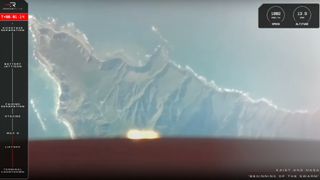
— Solar-sailing sentries could allow up-close study of interstellar visitors like 'Oumuamua
— Facts and information about Rocket Lab
— Wild idea: What if interstellar visitor 'Oumuamua is an alien light sail?
"Beginning of the Swarm" was Rocket Lab's fifth orbital launch of 2024 and its 47th overall. All but four of the company's liftoffs to date have occurred from its New Zealand site, on the North Island's Mahia Peninsula; the others have lifted off from NASA's Wallops Flight Facility in Virginia.
Rocket Lab is working to make the 59-foot-tall (18-meter-tall) Electron's first stage reusable. The company has recovered boosters from the sea on multiple prior missions and is planning to refly one of them on an upcoming launch. But there were no recovery activities on "Beginning of the Swarm."
Editor's note: This story was updated at 6:53 p.m. EDT on April 23 with news of a successful liftoff, then again at 8:22 p.m. EDT with news of satellite deployment.
Join our Space Forums to keep talking space on the latest missions, night sky and more! And if you have a news tip, correction or comment, let us know at: [email protected].

Michael Wall is a Senior Space Writer with Space.com and joined the team in 2010. He primarily covers exoplanets, spaceflight and military space, but has been known to dabble in the space art beat. His book about the search for alien life, "Out There," was published on Nov. 13, 2018. Before becoming a science writer, Michael worked as a herpetologist and wildlife biologist. He has a Ph.D. in evolutionary biology from the University of Sydney, Australia, a bachelor's degree from the University of Arizona, and a graduate certificate in science writing from the University of California, Santa Cruz. To find out what his latest project is, you can follow Michael on Twitter.
Boeing Starliner 1st astronaut flight: Live updates
China releases world's most detailed moon atlas (video)
The highest observatory on Earth sits atop Chile's Andes Mountains — and it's finally open
Most Popular
- 2 Satellite operator SES acquiring Intelsat in $3.1 billion deal
- 3 Einstein Probe X-ray telescope releases 1st images taken with 'lobster vision'
- 4 'We are ready:' New NASA documentary looks ahead to Artemis 2 moon mission (video)
- 5 Scientists reveal Southern Ring Nebula's unexpected structure: 'We were amazed'

COMMENTS
Leech: Back edge of the sail. Tack: The lower front corner of the sail. Clew: The bottom back corner of the sail. Foot: Bottom of the sail. There are two sail shapes, the fore-and-aft rigged sails, and square-rigged sails. Nowadays, fore-and-aft sails are more popular, have better performance and maneuverability.
A sail, which is a large piece of fabric that is attached to a long pole called the mast, uses the wind to pull a sailboat across the water. It has various parts, such as the head, tack, clew, luff, leech, foot, mainsail, jib, and batten. These components determine the shape and efficiency of the sail.
3. Genoa. The genoa is a large sail that attaches to the front of the forestay. (In this instance, it's similar to a headsail.) However, the genoa is larger than the headsail and overlaps the mainsail partially or completely to help the boat go faster. Genoa sails are useful when sailing through light or medium wind.
A gaff sail is a traditional four-sided sail held up by a horizontal spar called the "gaff." They are used on classic gaff-rigged sailboats and allow for a larger sail area with a shorter mast. Gaff-rigged boats were traditionally popular and usually carried 25% more sail area than the equivalent Bermudan rig, making them fast on a downwind ...
As a general setup, sailboats will use three common sails, including headsail, mainsail, and specialty sail. Due to the varying wind conditions and the model of the sailboat, there are many types of sails including jib, genoa, trysail, storm jib, code zero, gennaker, and spinnaker. While that sounds like too many models of sails, you can easily ...
In front of the main mast is called a foremast. The 5 most common two-masted rigs are: Lugger - two masts (mizzen), with lugsail (cross between gaff rig and lateen rig) on both masts. Yawl - two masts (mizzen), fore-and-aft rigged on both masts. Main mast much taller than mizzen.
On the most common sailboats, the term foresail refers to the front sail, which is attached to the boat's bow and mast. It is usually rolled in the roller furling or attached to the forestay via little snaps called 'hank-ons.' If you stumble upon the term 'headsail' or simply 'front sail,' know it is just a different name for the same thing.
1. Main Parts of a Sail. When it comes to sailing, understanding the different parts of a sail is essential.In this section, we'll dive into the main components that make up a sail: the luff, the leech, and the foot.Each sub-section will take us on a journey exploring the significance and role of these sail parts. So, buckle up and get ready to navigate the seas of sail anatomy like a true ...
The sail is what propels the boat, and most boats have more than one. The aft (rear) sail on a single-masted boat is called the mainsail , and it's the largest of the two primary sails. The triangular forward (front) sail is called the jib, and it's generally smaller than the mainsail.
Sailing upwind, a boat tacks when the bow passes through the eye of the wind until the boat is sailing on the opposite side or "tack" creating a zig-zag course. When sailing downwind, the boat jibes when passing the stern through the wind. Turning upwind is called heading up and turning away, or downwind is falling off.
The most common is the Jib. When a jib is so large that it overlaps the mast it is called a genoa. Parts of a Sail. Luff -A sail's forward edge. The luff of the mainsail is usually hoisted up and attached to the mast. ... What You'll Learn ASA 101 is your introduction to Basic Keelboat Sailboat and is your key to a lifetime of sailing. How ...
The mainsail, headsail (or jib), genoa, spinnaker, and gennaker are the most popular types of sails on sailboats. There are also a number of different configurations when considering the type of sail and mast in use including a sloop, fractional rig sloop, cutter, ketch, schooner, yawl, and cat. Simply put, different sailboat sails serve ...
Headsail/Jib. The headsail, or the jib, is likely the second most popular kind of sail found on sailboats. This is because it often accompanies the mainsail, the most popular kind. On all sailboats, the headsail is put at the front of the mast over the sailboat's bow. It is always a smaller sail than the mainsail.
The hull is what most people would consider 'the boat'. It's the part that provides buoyancy and carries everything else: sails, masts, rigging, and so on. Without the hull, there would be no boat. The hull can be divided into different parts: deck, keel, cabin, waterline, bilge, bow, stern, rudder, and many more.
A basic sailboat is composed of at least 12 parts: the hull, the keel, the rudder, the mast, the mainsail, the boom, the kicking strap (boom vang), the topping lift, the jib, the spinnaker, the genoa, the backstay, and the forestay. Read all the way through for the definition of each sailboat part and to know how they work.
The rig of a sailboat refers to it's mast and sail configuration. Here are the most common types of sailboat rigs and what they're used for. ... of two masts, but some have three or more. The aftermost large sail is the mainsail, and the nearly identical forward sail is called the foresail. Schooners can have one or more headsail, which ...
Sailing craft employ two types of rig, the square rig and the fore-and-aft rig.. The square rig carries the primary driving sails on horizontal spars, which are perpendicular or square, to the keel of the vessel and to the masts. These spars are called yards and their tips, beyond the lifts, are called the yardarms.A ship mainly so rigged is called a square-rigger.
Hull - The watertight structural shell of a boat. Bow - The forward part of a boat. Stern - The aft part of the boat. Transom - The more or less flat surface that closes the hull at the stern. Rudder - The sailboat is steered by a fin-shaped appendage attached beneath the boat toward the stern which can be rotated to change the angle ...
The sail plan. The last factor is the number of masts and the sail plan. The sail plan, simply put, is the number of sails, the type of sails, and how the sails are mounted to the masts (also called rigging). Sailboat are mostly named after the sail plan, but occasionally, a sail type is thrown in there as well.
Sailboats are powered by sails using the force of the wind. They are also referred to as sailing dinghies, boats, and yachts, depending on their size. Sailboats range in size, from lightweight dinghies like the Optimist dinghy (7'9") all the way up to mega yachts over 200 feet long. The length is often abbreviated as LOA (length overall), which ...
Hull - The main structure. Keel - The fin under the boat. Rudder - To steer the boat. Mast and Rigging - Supporting the sails. Boom - Supporting the mainsail. Sails - The canvas used to harness the energy of the wind. The starboard and port side of the boat. Windward and Leeward. Basic parts of a sailboat.
A sailboat or sailing boat is a boat propelled partly or entirely by sails and is smaller than a sailing ship. Distinctions in what constitutes a sailing boat and ship vary by region and maritime culture. ... The second mast is called the mizzen mast and the sail is called the mizzen sail. A ketch can also be Cutter-rigged with two head sails ...
The cockpit is naturally sheltered by the protected position, partially inserted inside the hull. The awning, also known as the bimini, shelters the cockpit from the sun (and rain). The canopy, also known as the sprayhood, shelters it from wind and water splashes. There is a central area in the middle of the boat with two walkways at the sides ...
Even those who don't sail can soak up the views at Cliff Walk, a 3.5-mile trail that takes travelers along the edge of the water. Sailors can count on catching some cool summer breezes while on ...
Choosing between a sailboat and a catamaran for your sailing adventures is a significant decision that depends on various factors, including your sailing preferences, experience level, budget, and ...
Jones takes the Annapolis Spring Sailboat Show's First Sail Workshop. (Paul W. Gillespie/Staff photo) At 10 a.m. on a Friday, boat traffic on the water is light, lending itself to an ideal first ...
The Queen hosting the 'Maiden' yachting crew to congratulate them on their unprecedented win of the Ocean Globe Race, becoming the first ever all-female crew to win an around-the-world yacht race
A Royal Caribbean International Alaska voyage became a cruise to nowhere over the weekend, with the line canceling the sailing after guests had already boarded.. The cruise line's Radiance of ...
These poles, once deployed, function as sailboat booms, and will keep the sheet taut enough to capture solar energy. [Related: How tiny spacecraft could 'sail' to Mars surprisingly quickly .]
Rocket Lab launched a South Korean Earth-observation satellite and new NASA solar-sailing tech to orbit this evening (April 23). The agency's Advanced Composite Solar Sail System, or ACS3 for ...